

Trams in Budapest
Table of Contents
The Tram Lines in Budapest
Budapest’s tram network consists of over 40 tram lines that run throughout the city’s historic center. The following lines are the most useful for tourists:
Tram Line 2
Tram line 2 is one of the most popular tram lines in Budapest, providing great views over the Danube and Buda Hills. The tram runs along Pest’s Riverbank and passes by some of the city’s most iconic landmarks, including the Chain Bridge , the Hungarian Parliament , and the Central Market Hall . It runs from Kozvagohid to Jaszai Mari Square, which is the closest stop to Margaret Island .
Tram Lines 19 and 41V
Tram lines 19 and 41V travel along Buda’s riverside, offering similar views to tram line 2 but on the western part of the city. The lines link Batthyany ter (St. Anne’s Church) with Gellert Hill and are useful for tourists wanting to visit the Gellert Spa and the Citadella .
Tram Lines 4 and 6
Tram lines 4 and 6 are the busiest tram lines in Budapest, carrying the largest number of passengers in Europe. They are not as useful for tourists as they mainly serve residential areas.

Schedule and Tariffs
Trams in Budapest run from 4:30 am to 11 pm, with the most important lines running every 5 to 10 minutes. All of Budapest’s means of transport use the same tickets and travel passes and cost the same price:
- Single ticket: HUF 350
- Block of 10 tickets: HUF 3,000
- 24-hour travel card: HUF 1,650
- 72-hour travel card: HUF 4,150
Future Developments
Budapest’s tram network is constantly evolving, with several new developments in the pipeline. The Mayor of Budapest recently announced that 51 new CAF-type trams will arrive in the capital to run on the Buda lines, greatly helping the further development of public transport in Budapest.
There are also plans to reinstate the tram on one of the busiest streets, Thokoly Road, and link the rail axis. These plans are worth taking seriously and building as soon as domestic or EU funding can be secured, according to David Vitezy, a transport expert and former state secretary.
A Brief History of Trams in Budapest
The history of trams in Budapest dates back to the 19th century when the city was experiencing rapid growth and needed a reliable mode of public transportation. The first horse-drawn tram line was opened in 1866, and it was followed by the first electric tram line in 1887.
During the 1980s, Budapest’s tram network was in decline, and there were even proposals to close some of the lines. However, from the 2000s onwards, there were several developments that gave the network a new impetus. The arrival of the Combino trams in 2004-2006 and a contract with CAF, a Spanish railway vehicles manufacturing company, in 2014 marked a new era for Budapest’s tram system.
How do I buy tickets for the tram?
Tickets for the tram can be purchased at ticket vending machines found at many tram stops, metro stations, and also at newsstands. Remember to validate your ticket once on board.
Can I travel with the same ticket on trams, buses, and the metro?
Yes, a standard ticket is valid for a single trip on all modes of public transportation within Budapest, including trams, buses, trolleys, and the metro.
What are the operating hours of the trams in Budapest?
Trams in Budapest generally operate from early morning until late at night. However, schedules vary depending on the route and the day of the week. Some lines offer 24-hour service.
How often do trams run in Budapest?
Tram frequency in Budapest varies depending on the route and time of day. During peak hours, trams can arrive as frequently as every 5 minutes.
What is the Budapest Card and can it be used on trams?
The Budapest Card is a travel card for tourists, which offers unlimited travel on public transportation, including trams, for a specified period of time (24, 48, 72, 96, or 120 hours). It also provides free or discounted access to many attractions.
What is the most scenic tram route in Budapest?
Many consider the No. 2 tram line as the most scenic route, as it travels along the Danube River, providing beautiful views of the Buda Castle, the Parliament, and other landmarks.

6 Epic Tram Lines of Budapest: The Villamos’ that’ll Show You the Many Faces of the City
This is an excerpt from our extensive Budapest guide book in which we show you the city from its most authentic and honest side through 99 chapters and more than 200 places to discover.
Budapest’s trams (“villamos'”) are shiny yellow beacons of the city’s public transportation system. Their history reaches back to more than 150 years and today, they are somewhat the “exceptional children” of the otherwise often hated-on BKV (the Budapest public transport system). And even if they’re sometimes late and rather slow, nobody can really be angry at them. Maybe it’s because of their happy colours. Or because they look simply adorable. It could be the fact that you can stare out of the windows, and enjoy a ride free of exhausts and on the surface. Or their often scenic and calming routes.
Whatever it is, riding the “villamos” in Budapest is an absolute must while you’re here. Since there are 25 of them and not all of them give you the same experience, here are the top 6 most special tram-rides of Budapest:
Tram Lines Nr. 47 & 49
These two tram lines will show you the best of Pest along with the whole beauty of Liberty Bridge and the Danube . Afterwards, they’ll take you along a chilled avenue of Buda (Bartók Béla út), which is lined with some of the coolest cafés and eateries of the city. Get off at Móricz Zsigmnd körtér and round your journey off with a laid-back walk around the “Ass-Less Lake” (Lake Feneketlen) – an inner-city lake surrounded by plenty of mystery and urban legends .
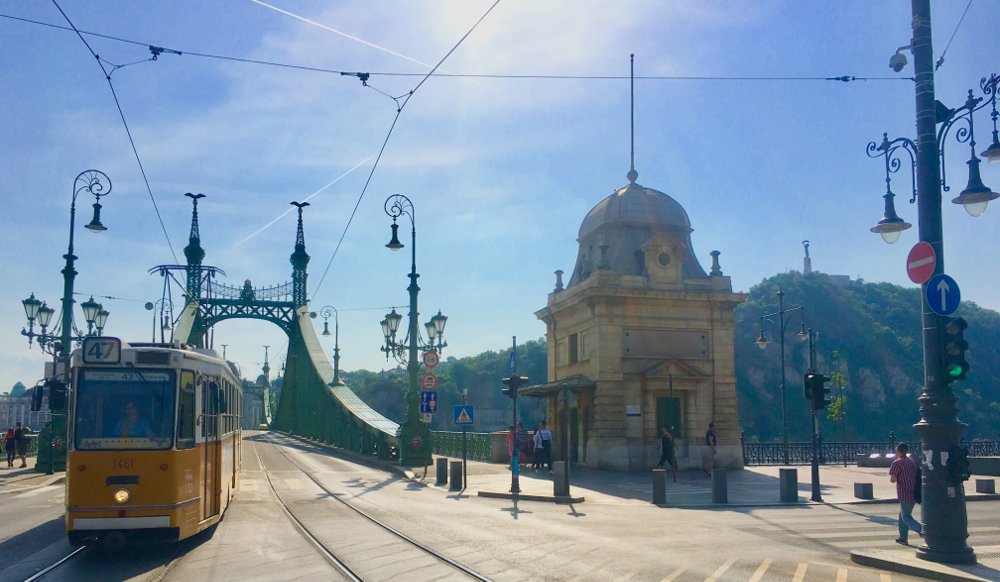
Get on at: Deák Ferenc tér
Get off at: Móricz Zsigmond körtér
Look out for:
- Deák Ferenc tér: The heart of the city; the door to the “party district” and probably the most famous meeting point of whole Budapest (stop: Deák Ferenc tér)
- the small ring road (“Kiskörút”) : the former border of the city of Pest, running now where previously the old city walls stood. Today’s gate to downtown with plenty to see. (between stops Deák Ferenc tér and Fővám tér)
- the National Museum, a beautiful classicistic building with historic significance, serving as an important setting of Hungarian history. (stop: Astoria)
- the Great Market Hall (stop: Fővám tér)
- Liberty Bridge from the best possible point of view (stop: Fővám tér)
- the Danube Panorama , as the tram makes its way across Liberty Bridge (between stops Fővám tér & Szent Gellért tér)
- The beautiful Viennese-Secession-style Gellért Hotel (this is the building that inspired Wes Anderson’s Grand Budapest Hotel!) (stop: Szent Gellért tér)
- Bartók Béla Avenue with some of the best cafés and eateries of the city (between stops Szent Gellért tér & Móricz Zsigmond körtér)
- the myth-enshrouded & and very laid-back Lake Feneketlen (“the Ass-Less Lake”) (stop: Móricz Zsigmond körtér)
Note: It doesn’t matter which line you take, as they only part at Móricz Zsigmond körtér.
Tram Line Nr. 2
The one you read of in every single guidebook – this time for good reason . A beautiful ride along the Pest side of the Danube Bank that’ll give you the whole beauty of the city.
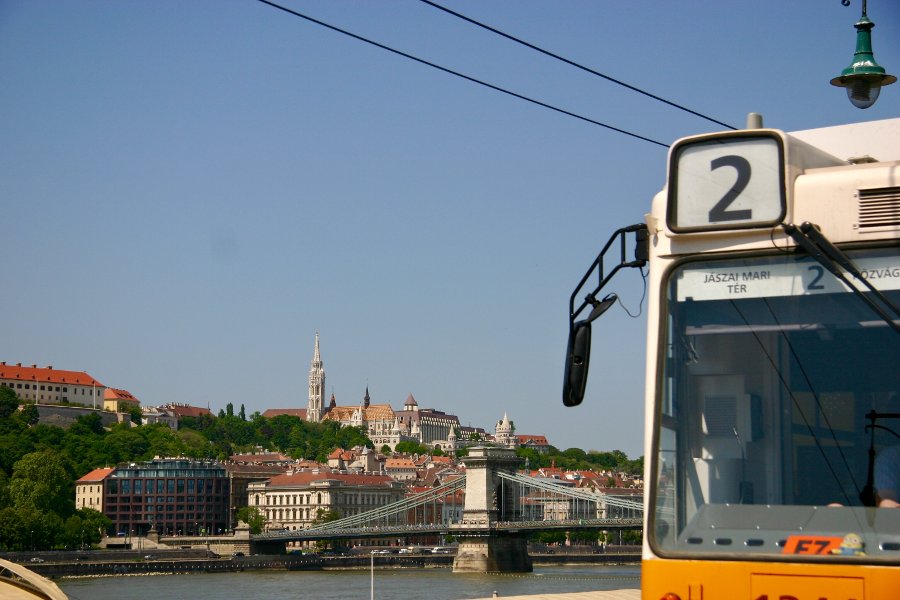
Get on at: Fővám tér
Get off at: Jászai Mari tér
- The Buda Castle (visible on the opposite side of the Danube throughout the whole route)
- The Grand Market Hall (stop: Fővám tér)
- Liberty Bridge (“Szabadsághíd”) (stop: Fővám tér)
- The Chain Bridge (between stops Eötvös tér & Széchenyi István tér)
- The Shoes on the Danube Bank (between stops Széchenyi István tér & Kossuth Lajos tér) – a chilling reminder of history
- The Parliament (stops Kossuth tér & Országház Látogatóközpont)
- Margaret Bridge & Margaret Island (stop: Jászai Mari tér)

BUDAPEST – 99 THINGS YOU NEED TO SEE, DO AND EXPERIENCE
Explore the authentic side of budapest.
Our guidebook will help you peel back the multiple layers of Budapest one by one. It’ll help you see Budapest the way it’s meant to be seen.
It’s written for conscious travellers and locals . For those who are looking for more than just a glimpse at the main tourist attractions.
For those who want to not only see, but also feel the city and experience how it lives, plays, works, eats, drinks and functions.
It features countless little gems for you to discover while strolling the city streets – be it a hidden courtyard, a secret bar, a colourful garden, an offbeat flea market, or a stunning piece of street art.
Tram Lines 4 & 6
Among the busiest tram lines of the world (legend says it’s *the* busiest!) – these two lines truly never sleep . Being the only public transport (except for the night buses) that run round the clock , every night, they transport millions of passengers every year along Budapest’s big ring road (“Nagykörút”) . All of this at max. 15min-intervals, although during rush hours they run every 2(!) minutes . The route is a real spectacle ; the best is to just sit back and take it all in, but here are some points of reference:
Get on at: Széll Kálmán tér
Get off at: Rákóczi tér
- Margit körút – The Forgotten Ring Road and its Bauhaus architecture (between stops Széll Kálmán tér and Margit híd, Budai hídfő)
- The Danube Panorama (including the Citadel, the Parliament and the Buda Castle) (between stops Margit híd-Budai hídfő and Jászai Mari tér)
- Margaret Island (stop: Margitsziget-Margit híd)
- The impressive Nyugati Railway Station built in the style of French Renaissance. Fun fact: It was planned by August de Serres and Gustave Eiffel. Yapp, that guy who later planned the Eiffel tower. (Stop: Nyugati pályaudvar)
- All the little, often trashy and weird shops that are inherently characteristic for the Ring Road. Especially the numerous bridal shops! (mostly between stops Nyugati pályaudvar and Király utca)
- Rákóczi Square Market Hall : The much less touristy little sister of the Grand Market Hall (stop: Rákóczi tér)
Note: It doesn’t matter which line you take, as they only part for their two final stops.
Tram Line Nr. 61
Makes its way through the beautiful forests and enchanting houses of faraway Buda. A true hidden gem of a line!
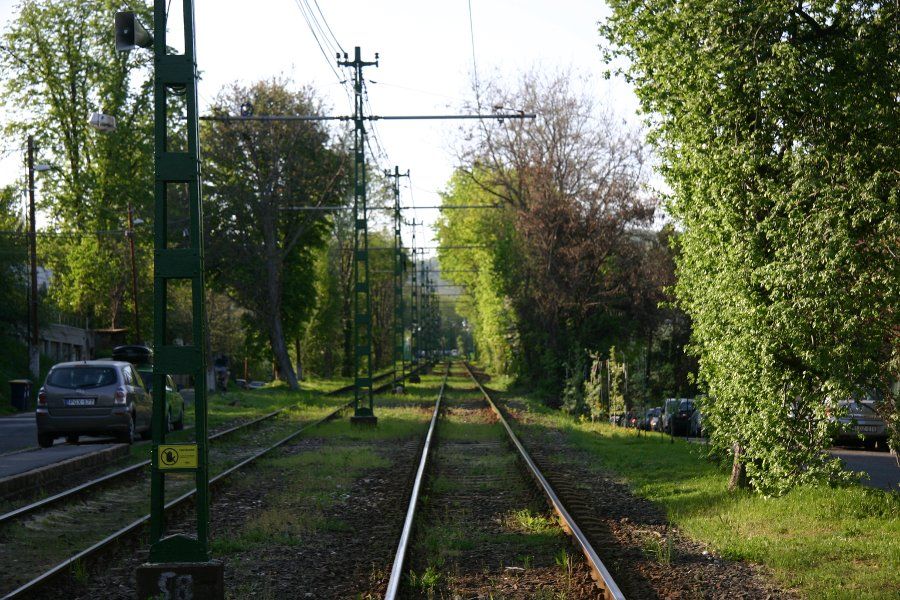
Get off at: Hűvösvölgy
- The “Körszálló”: Budapest’s “Round Hotel” which you can see even from far above in the Buda Hills. It looks like a giant barrel and was built in the 60s to show “the West” that “we can build skyscrapers, too!” (stop: Városmajor)
- The “Bauhaus-street” and its super interesting buildings in Napraforgó utca (stop: Zuhatag sor)
- The enchanting forest and the little houses along the way (between stops Budagyöngye to Hűvösvölgy)
- The final station of Hűvösvölgy – looks like straight out of a fairytale and is under monumental protection. (stop: Hűvösvölgy)
Our tip: If you’re up for the biggest toy of Budapest, you can jump straight into the Children’s Railway at Hűvösvölgy and start a great hike in the giant mountains of Buda from here. Here is everything there is to know about this peculiar little vehicle of Budapest. Find all our infos here or this awesome trip.
Tram Line Nr. 51
The ugly beauty of the Pestest Pest . Get ready for old factories, run-down buildings and be enchanted by a lot of industrial charme on the way. A ride into the dark side to fall for. For everyone who has a rough side to their heart.
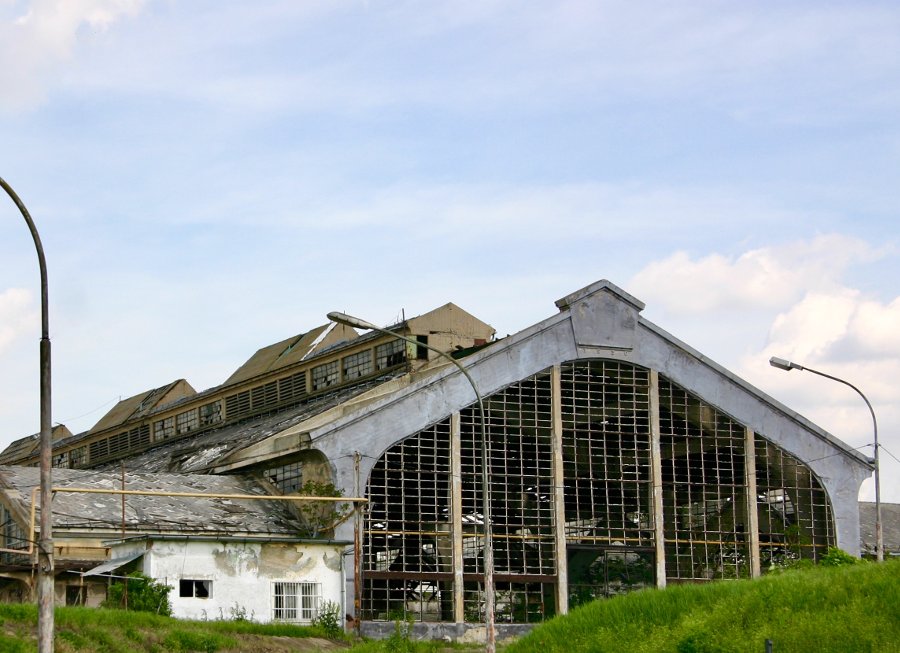
Get on and off at: Mester utca / Ferenc körút
Look out for: Just take it all in!
Tram Line Nr. 41
The adorable Buda-bro to famous tram-line 2. Beautiful Danube bank & panorama , all without the tourists. Once you leave the bank, get ready for some serious Buda-peace & chill as you slowly make your way to the “Chamber Forest” (Kamaraerdő). Take a big, big walk from there!
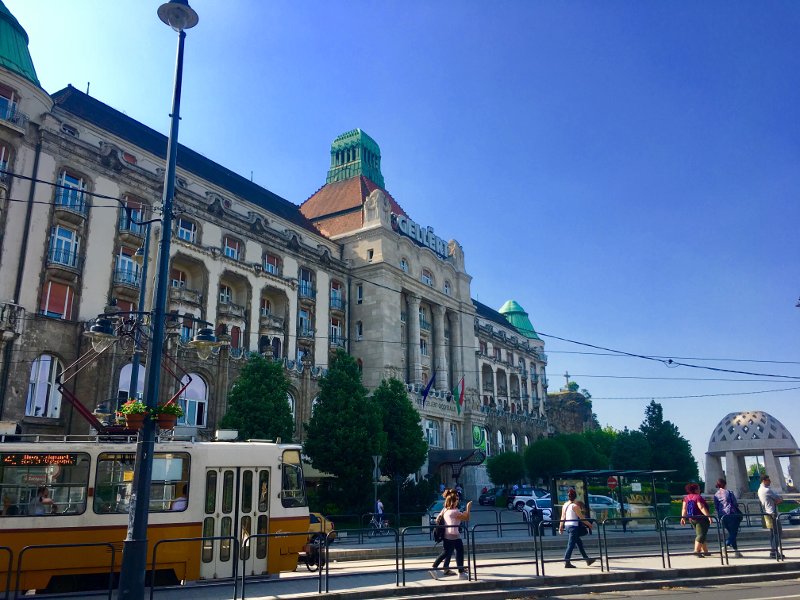
Get on at: Margit híd-Budai hídfő
Get off at: Kamaraerdei Ifjúsági Park
- The whole Danube-panorama (between stops Margit híd, Budai hídfő & Szent Gellért tér)
- The beautiful Viennese-Secession-style Gellért Hotel (this is the building that inspired the Grand Budapest Hotel!) (stop: Szent Gellért tér)
- Kamaraerdő (“The Chamber-Forest”) – a peaceful recreation forest perfect for going on a hike after the ride
And now we’d like to hear from you: Which is your favourite tram line of Budapest (or even the world)? Any other mode or line of transport you totally fell for here? Which gems did we miss along the way? Let us and others know in the comments below!
You might also like:
- 30 Amazing Things to Experience in Budapest this Spring
- Budapest’s Ruin Pub Culture – A Ruined Pub Culture? (Including 4 Authentic Ruin Pubs You sshould Visit!)
- Day Trip Itinerary in Budapest: The Children’s Railway and the Buda Hills
- A Stunning Weekend Getaway from Budapest – Zebegény & the Danube Bend (Dunakanyar)
- 15 Cool Bars in the Budapest Party District that Are still Hassle- and Stag-Free
- 9 Heavenly Cozy Cafés in Budapest for Rainy Days
- 15 Little Amazing Things We Adore about Budapest
Hi. In September 1989 I visited your great city, mainly to ride the wonderful tramway. I took 75 minutes of video just of the trams on many lines and am preparing it for Youtube. I believe that I have correctly named locations but it would be better if a local tram fan would like to check it for mistakes. Please contact me at: tressteleg(at)icloud.com Use the normal symbol instead of (at) Thank You!
Leave a Reply
Leave a reply cancel reply.
Your email address will not be published. Required fields are marked *
Save my name, email, and website in this browser for the next time I comment.
This site uses Akismet to reduce spam. Learn how your comment data is processed .
Catch Budapest
- Budapest Guide
- Learn Hungarian
- One Hungarian Word a Day
- Our Courses
- Smart Hungarian Short Stories Course: Learn Hungarian Through the Magic of Short Stories
- The Best Resources for Learning Hungarian
This site uses cookies. By continuing to browse the site, you are agreeing to our use of cookies.
Cookie and Privacy Settings
We may request cookies to be set on your device. We use cookies to let us know when you visit our websites, how you interact with us, to enrich your user experience, and to customize your relationship with our website.
Click on the different category headings to find out more. You can also change some of your preferences. Note that blocking some types of cookies may impact your experience on our websites and the services we are able to offer.
These cookies are strictly necessary to provide you with services available through our website and to use some of its features.
Because these cookies are strictly necessary to deliver the website, refusing them will have impact how our site functions. You always can block or delete cookies by changing your browser settings and force blocking all cookies on this website. But this will always prompt you to accept/refuse cookies when revisiting our site.
We fully respect if you want to refuse cookies but to avoid asking you again and again kindly allow us to store a cookie for that. You are free to opt out any time or opt in for other cookies to get a better experience. If you refuse cookies we will remove all set cookies in our domain.
We provide you with a list of stored cookies on your computer in our domain so you can check what we stored. Due to security reasons we are not able to show or modify cookies from other domains. You can check these in your browser security settings.
We also use different external services like Google Webfonts, Google Maps, and external Video providers. Since these providers may collect personal data like your IP address we allow you to block them here. Please be aware that this might heavily reduce the functionality and appearance of our site. Changes will take effect once you reload the page.
Google Webfont Settings:
Google Map Settings:
Google reCaptcha Settings:
Vimeo and Youtube video embeds:
You can read about our cookies and privacy settings in detail on our Privacy Policy Page.
Exploring Budapest: 7 Beautiful Tram Rides Along the Danube
Published: 2023-07-16
Buda is not only known for its stunning architecture and rich history but also for its extensive tram network . Taking a tram ride in Budapest is not only a convenient way to get around the city but also a way to experience the beauty of the Danube and its surroundings. In this article, we will explore some of the most beautiful tram rides along the Danube and delve into the sights and landmarks that can be seen along the way.
Tram 1: Crossing the Danube Twice
Tram 1 is a gem among the city's tram routes as it offers not one, but two crossings over the Danube River. This journey provides sweeping views of the millennial arts complex and Margaret Island from its lesser-seen northern perspective . Along the way, passengers can also admire the elegant villas of Zugló and the scenic parks of Bikás park and Népliget .
Tram 2: Front Row Seats to Buda's Cityscape
Considered the grande dame of all trams in Budapest, tram 2 offers passengers front row seats to gawk at Buda's historic cityscape and the main bridges that adorn the city center . Starting at Margaret Bridge and passing by iconic landmarks such as the Parliament building and Chain Bridge , this tram ride is a perfect way to take in the beauty of the Pest embankment and immerse oneself in the city's charm.
Tram 19: Explore Buda's Terrace Life
Tram 19 takes passengers on a journey through Buda's most happening avenue, Bartók Béla út, where they can observe the vibrant terrace life of the city. As the tram winds its way beneath Gellért Hill and Castle Hill , passengers can catch glimpses of the famous Gellért Hotel and the bustling Pest embankment. This ride also passes by key spas and stops at Óbuda , a neighborhood known for its village-like atmosphere.
Tram 56: From Wine Cellars to Leafy Slopes
Tram 56 takes passengers on a scenic ride through the Buda side, from the charming local market in Budafok to the leafy slopes of Hűvösvölgy . Along the way, passengers can admire residential Buda , the foot of Castle Hill , and the picturesque park of Városmajor . Although the schedule for tram 56 can be capricious, this ride is worth taking for those seeking a glimpse of the greenery and tranquility of upper Buda.
Tram 59: Parallel to Tram 56, with a Twist
Running parallel to tram 56, tram 59 provides an alternative route between Szent János Kórház and Déli station . This tram ride offers a similar scenic experience as tram 56, showcasing the beauty of Budapest's Buda side. Whether it's exploring the charming neighborhoods or connecting to other transportation options , tram 59 is a convenient choice for traversing the city.
A tram ride along the Danube in Budapest offers not only a convenient way to get around the city but also an opportunity to witness its beauty and charm. Whether it's crossing the Danube multiple times or admiring the historic cityscape, these tram rides provide a unique perspective of Budapest's landmarks and neighborhoods. So next time you're in Budapest, hop on a tram and enjoy the sights along the way.
Questions & Answers
=== Which trams in Budapest offer scenic views along the Danube? Trams 1 and 2 in Budapest offer scenic views along the Danube.
What landmarks can you see from tram 1 in Budapest? From tram 1 in Budapest, you can see the millennial arts complex, Margaret Island, Bikás park, Népliget park, and the elegant villas of Zugló.
What landmarks can you see from tram 2 in Budapest? From tram 2 in Budapest, you can see the Parliament building, Gresham Palace, Chain Bridge, Pest embankment, and the five-star hotels along the Danube.
What landmarks can you see from tram 19 in Budapest? From tram 19 in Budapest, you can observe the terrace life of Buda's Bartók Béla út, see the Gellért Hotel, pass by Gellért Hill and Castle Hill, and see the Pest embankment.
What is the route of tram 56 in Budapest? Tram 56 in Budapest runs on the Buda side and takes you from Budafok to Hűvösvölgy, passing through residential Buda, Újbuda-központ, Castle Hill, and Városmajor park.
Does tram 56 in Budapest cross the Danube? No, tram 56 in Budapest stays on the Buda side and does not cross the Danube.
What is the schedule of tram 56 in Budapest? Tram 56 in Budapest runs during working hours on weekdays and follows a frequent schedule once it gets going.
Which trams in Budapest pass by Szent János Kórház and Déli station? Trams 56 and 59 in Budapest pass by Szent János Kórház and Déli station.
What is the timetable for tram 59 in Budapest? The timetable for tram 59 in Budapest is unclear.

- Public Transport
Trams in Budapest
Budapest has over 40 tram lines that run throughout the historic center. Read about the most important lines, schedules and tickets.
Trams in Budapest are a good way of getting around Budapest . They are especially popular among children and many lines offer a panoramic ride of the city centre.
Budapest has over 40 tram lines that run throughout the historic centre. The following lines are the most useful for tourists:
Tram line 2
The tram line 2 runs along Pest’s Riverbank , providing great views over the Danube and Buda Hills. The route passes by the Chain Bridge , the Hungarian Parliament , the Central Market Hall and other landmarks on the eastern bank.
The tram runs from Közvágóhíd to Jászai Mari Square, which is the closest stop to Margaret Island .
Tram lines 19 and 41V
The tram lines 19 and 41V travel along Buda’s riverside , very similar to the tram no. 2 route, but on the western part of the city. It links Batthyány tér (St. Anne’s Church ) with Gellért Hill. If you get off at Gellért Hill, you can visit Gellert Spa , one of the most famous thermal baths in Budapest and then see the Citadella .
Both retro trams connect with Batthyány Square , a station on the metro line 2 (red line).
Tram lines 4 and 6
Both tram lines 4 and 6 are always packed with passengers . It is believed that these lines carry the largest number of passengers in Europe. These two lines are not very useful for tourists.
Trams in Budapest run from 4:30 am to 11 pm . The most important lines run every 5 to 10 minutes .
All of Budapest’s means of transport use the same tickets and travel passes and cost the same price:
- Budapest transport ticket and pass prices.
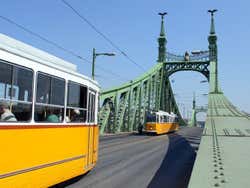
You may also be interested in
The Budapest metro has four lines and is easy to use, as three of them only cross in one point: Deák Ferenc tér station
Budapest has over 200 bus lines that reach most parts of the city but, despite its extensive network, the easiest ways to get around the city centre are by tram or metro, avoiding the city’s traffic jams.
Budapestbylocals.com
Budapest public transport, how to travel in the city.
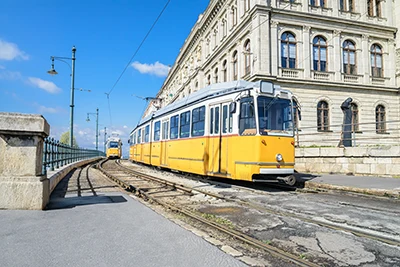
Use public transport services to travel in Budapest, especially if you stay in one of the outer districts.
Although attractions in the central districts (V., VI., parts of I., II., VII. and VIII.) are easy to explore on foot you might want to rest your legs after a while and hop on a metro/tram/bus.
Table of Contents – Budapest Public Transport
Best public transport lines for tourists.
You will easily get to any sight and attraction by travelling on one of the four metro lines or the major tram lines (No. 4, 6 and 2).
TIP: In case it’s cold or a summer shower catches you, take one of the four metro lines (M1 , M2, M3 and M4), or any of the major tram lines (tram 2, 2B, , 4, 6, 47, 49 or 19)
- Trams No. 2 and 2B run along the Pest Danube emabankment (between Jászai Mari tér – Közvágóhíd stops), covering the pircturesque promenade called Duna Corso and stopping in front of the Parliament in Kossuth Square.
- Trams 47 and 49 are also useful especially if you want to get from Pest to Buda or vica versa.
- Tram 19 is great for sightseeing in Buda , it connects Kelenföld Train Station with Óbuda (the Northern part of Buda). Similarly to Tram 2 and 2B in Pest it travels along the Danube between Liberty Bridge and Margaret Bridge offering a scenic view of the river and some famous attractions in Pest, in the .
See more on travelling buy tram in Budapest!
These transport services will take you to most of the places of interest.
The bus and trolley bus service are quite extensive too.
There’s also a scheduled boat service on the Danube from spring till autumn.
Below you find information on Budapest public transport: types of tickets and passes, buying, and validating them.
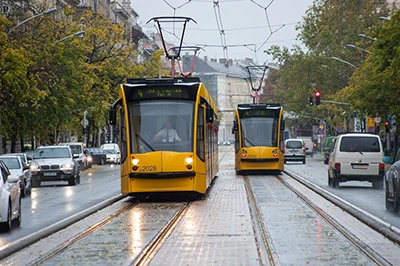
Popular Activities
Tickets, travel cards, prices and fines.
Budapest has a fairly extensive and efficient public transport system. It is also cheaper than in most Western European cities.
A wide variety of trams, buses, trolleys and metro trains run in the city.
Night service is quite reliable, too.
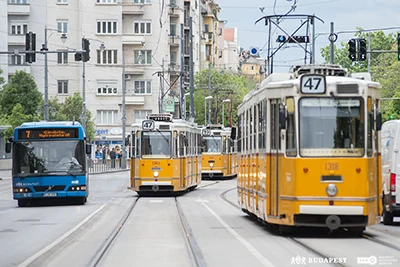
Be prepared for typical rush hours : vehicles are crowded and traffic can be rather slow. This would be expected in any large city.
Children’s Fares, Student Passes, Family Discounts
Children living in Hungary up to the age of 14 travel free of charge. A valid Hungarian identity card is required for them to verify age if a controller asks for tickets and passes.
Pupils, university students can buy discount monthly/yearly passes with a valid student ID card.
No student discount on single tickets though.
TIP: For families visiting Budapest with kids we recoomend getting the 24-hour group travel card. 5 people can travel with it for p to 24 hours and it cots 5 000 HUF.
Free Travel on Public Transport with Budapest Card
TIP: If you don’t want to bother with buying and validating tickets, purchase a Budapest City Card .
Besides unlimited free travel on public transport, the card offers a range of discounts on tours/services, free entry to the permanent exhibitions of many museums, entry to the Lukács Bath etc.
Buy Budapest Card: Public Transport, 30+ Top Attractions & Tours
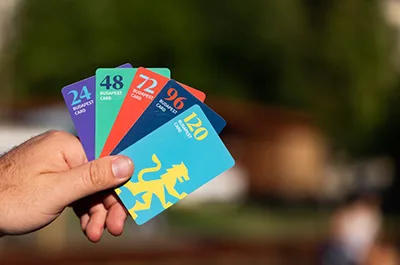
- 24-Hour Card: 29 EUR
- 48-Hour Card: 43 EUR
- 72-Hour Card: 56 EUR
- 72-Hour Plus Card: 87 EUR
- 96-Hour Card: 69 EUR
- 120-Hour Card: 82 EUR
Read more about the Budapest Card and whether it’s worth getting it!
Public Transport Tickets and Passes
(Prices Updated For 2024)
Note: The price of a single ticket and discounted pack of 10 tickets has gone up as of September 01, 2023: A single ticket costs 450 HUF , pack of 10 single tickets costs 4 000 HUF. Price of travel cards, monthly passes hasn’t changed. Both are available online through the BudapestGO App .
TIP: If you visit the Hungarian capital for 2-3 days and you stay in a city center hotel , we recommend that you use:
- Single tickets or the
- Discounted block of 10 tickets to make travelling on public transport lines hassle-free.
- Time-based tickets (30-minute and 90-minute) work well too with unlimted transfers within the timeframe.
Free Travel For Seniors 65 + – EU Citizens Only
TIP: Citizens of the European Union countries and Switzerland aged 65 and up can use all public transport lines for free in Budapest.
They have to show a valid ID to verify age and nationality if asked by a ticket inspector).
The current tickets and passes are of pale purple colour.
Tickets, Transfer Tickets
- Single ticket (vonaljegy or just jegy) 450 HUF, (600 HUF if purchased from the driver on board the vehicle): valid on all public transport vehicles for one uninterrupted trip. If you
- Block of 10 single tickets (tíz darabos gyűjtőjegy: 4 000 HUF). Costs less than 10 single tickets purchased individually.

Time-Based Tickets: Save Money
Use time-based tickets if you need to transfer between metro lines and also other lines (trams, buses, trolley).
You save money with it since you don’t need to use a 450-HUF single ticket every time you need to change public transport lines.
Moreover, you can finish your trip beyond the 30th or 90th minute until you reach your destination within Budapest.
Please remember to validate your time-based ticket before the start of your travel and each time you switch to another travel line.
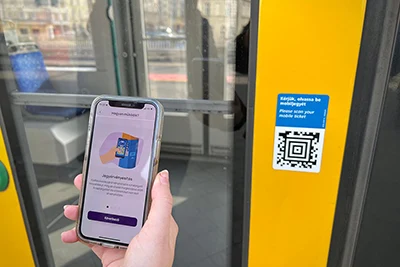
You can use time-based tickets for an unlimited number of transfers and trip interruptions, by validating it each time you board making sure that your last transfer falls within the 30-minute or 90-minute time limit.
There Are Two Time-Based Tickets:
- 30-minute ticket: 530 HUF
- 90-minute ticket: 750 HUF
Important! Please scan the code each time when you board a vehicle to validate your ticket. When transferring between metrolines, you are not required to revalidate your ticket.
Note: If you carry a bike with you (permitted only on a few vehicle types) you have to validate a single ticket for it.
Travel Cards
24-hour travel card.
- Price: : 2 500 HUF – Please note that is not the same as the 24-hour Budapest Card
- Valid on all public transport vehicles except for the boat service on the Danube.
- For an unlimited number of trips from 0:00 to 24:00 of the day indicated on the ticket (you decide on the starting time).
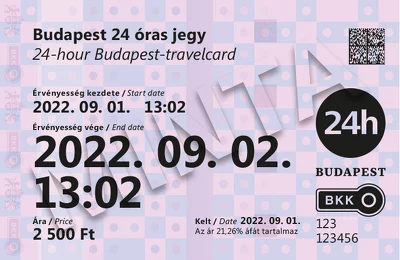
24-Hour Group Travel Card, For Max. 5 Persons
- Price: 5 000 HUF – Recommended also for families
- Valid on all public transport vehicles – except for the boat service.
72-Hour Travel Card
- Price: 5 500 HUF) – not the same as the 72-hour Budapest Card
- Valid on all public transport vehicles – except for the boat service- for an unlimited number of trips for 72 hours starting from the time and date you purchased it.
Public Boat Service Tickets
Unfortunatley Public Boat services ceased to run as of 2023 due to high maintenance expenses.
Where To Buy Tickets And Passes?
You have two options, choose the one that you’re more comfortable with:
BudapestGO App or Paper Tickets/Tarvel Cards
- Go the traditional way and buy and use paper tickets and travel cards (24-hour or 72-hour, or if you are comfortable with using apps
- Download the BudapestGO public transport application to buy single tickets, time based tickets (for 30-minute or 90-minute duration) and 24/72-hour travel cards. The app is also a great help in planning your route providing real-time travel information as well as route and service recommendations including the BuBi public bike rental points.
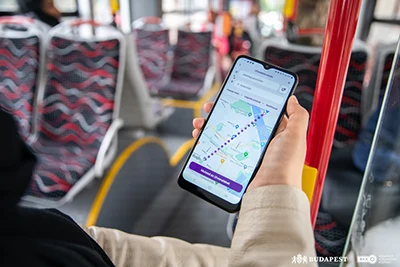
You can buy paper tickets and travel cards from the ticket vending machines with bankcard (or cash) . You The purple colored ticket automats are placed at main public transport stations (metro entrance), as well as at the airport.
The airport also has BKK Customer Sales Points where you can get your ticket/travel card from a real person.

If you don’t have or don’t want to use the BudapestGO App you have to buy your tickets/pass in advance.
You can get them from ticket vending machines (TVM) or at many newspaper kiosks.
Around 300 new ticket vending machines have been placed throughout the city where you can get tickets and passes 24/7 by paying with cash or bank card.
I often use them and found them are quite reliable .
Most ticket offices have closed down though. You will find Ticket Offices (Jegypénztár) in some metro stations near the entrance:

- Corvin negyed M3/blue line,
- Népliget M3/blue line,
- Nyugati tér M3/blue line,
- Blaha Lujza tér M2/red line,
- Széll Kálmán tér M2/red line.
Most cashiers speak only Hungarian so it’s best to go to the cashier with a piece of paper on which you’ve written down in Hungarian what type of ticket you want to buy.
TIP: Here is a map of the Public Transport Company showing all the operating ticket sellers .
How To Use The Ticket Vending Machines (TVMs)?
Using the machines is pretty straightforward, just read the instructions displayed on the monitor.
First choose language by touching the appropriate flag symbol on the bottom of the screen on the right hand side of the TVM.
A list of the most popular ticket types and passes will appear
- Single ticket-350 HUF,
- Block of 10 tickets – 3000 HUF,
- 24-hour travel card,
- 24-hour group travel card,
- Various monthly passes.
I only give you the steps on buying tickets/travel card because these are the ones most suited to tourists visiting Budapest for a couple of days.

Buying Ticket/Travel Card From The TVM:
- Select the ticket/travel card you want to buy.
- Decide whether you want the machine to print an invoice , if not then press payment without VAT invoice.
- Choose payment method: you can pay by cash, bank card (PayPass/contactless cards). I prefer using bank card, and recommend this payment method for tourists as well.
Paying By Bank Card/Contactless Card – Recommended For Tourists
The simplest and fastest way is to pay with a bankcard/contactless card .
Just follow the steps shown on the card terminal screen. After payment collect the purchased ticket or travel card.
Paying By Cash:
The machine accepts all current Hungarian coins from 5 HUF to 200 HUF.
You can use banknotes too: 500 HUF, 1 000 HUF, 2 000 HUF, 5 000 HUF, 10 000 HUF, 20 000 HUF. Based on the total value of the purchase the TVM defines the banknotes to be accepted.
If the purchase is of a small amount (e.g. a 350 HUF single ticket) 2000 HUF or smaller notes are accepted. In case of a bigger purchase larger notes can also be used.
The machine accepts 35 coins and 15 banknotes per transaction. It gives back changes in coins and notes.
Make sure you don’t leave your bank card or other belongings at the machine.
You can also view an instructional video on how to buy monthly passes and use the vending machines on the transport company’s (BKK) website.
How To Validate Tickets?
You must validate your ticket at the start of your journey.
Metro Stations
In case of metro tickets you have to put the ticket in the ticket validation machine (orange coloured box on a metal pole) that’ll stamp a time and date on the ticket.
A short musical tone and the tiny green light confirm that the ticket has been validated.
Once you validated the metro ticket you head for the escalator that’ll take you to the metro platform where you wait for the metro car.
At the top of the escalator ticket inspectors will most likely stop you to check whether you’ve validated your ticket.
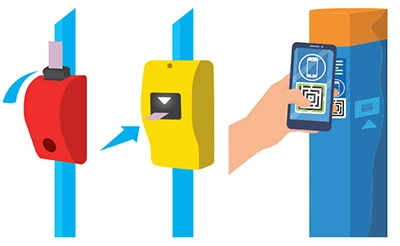
Other Vehicles
On other vehicles (trams, buses, trolley) there’ s
- Either the orange or yellow box similar to the ones in metro stations, or
- A smaller red box in which you insert the ticket then pull the black part on the top towards you to punch the ticket (a pattern of holes appear on the validated ticket).
Note: The slot on some ticket validation machines is clogged with chewing gum or paper (deliberately done by prank makers) so you won’t be able to insert the ticket. Try another machine on the vehicle to validate your ticket.[
Inspectors check passengers’ tickets throughout the day.
An inspector usually wears dark blue uniform and a blue with a red armband. Nowadays, however they are in plain clothes (but still must put on the armband when checking tickets) in order to disguise themselves.
To avoid problems , buy the type of ticket or pass that are most suitable for your visit and your budget, and remember to validate it. Keep your ticket until the end of your journey.
Fines are high (if caught travelling without a valid ticket or pass you’ll be fined to pay 16.000 HUF, 8.000 HUF if you pay it on the spot or within 2 days of being fined)
It’s not worth ruining your stay with constant watching out for the inspectors. If you forgot to buy a ticket or validate it, and you’re fined the ticket inspector must give you a receipt about the payment.
Fines For Travelling Without A Valid Ticket/Pass
If you’re caught without a valid ticket by a ticket inspector , you are to pay a fine which is currently 12 000 HUF paid on the spot or in BKK’s Surcharge Office within 2 work days from the date of the fining.
Note: The inspector must give you a receipt of the payment when you pay on the spot.
If you don’ pay the fine on the spot or within 2 work days, but settle the amount within 30 days the penalty fare is 25 000 HUF .
If you don’t pay the fine on the spot, the ticket inspector initiates a fining procedure (ensuring the opportunity of deferred payment).
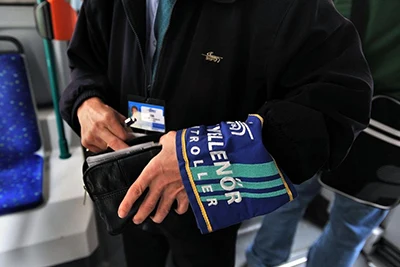
In this case he/she is entitled to ask the required personal data (name, mother’s name, date and place of birth) and also the address of the passenger. On the basis of these data, the ticket inspector fills in a so-called “Surcharging procedure report”.
If the passenger refuses to give his/her personal data, the ticket inspector can ask for police assistance on the spot.
The ticket inspector gives a cheque about the amount of the fine and a leaflet about the opportunities of payment.
The passenger shall sign that he/she accepts the surcharging and confirms that he/she has given the required personal data. The denial of signature doesn’t acquit the passenger of the consequences of the fining.
You’ll find the most up-to-date information about tickets, prices and penalty fines on the Public Transport Company’s website (BKK).
Neighborhoods to Know
72-Hour Itinerary
Day Trips From Budapest
Top Things to Do
Free Things to Do
Best Museums
Thermal Baths
Shopping in Budapest
Hungarian Dishes to Try
Best Restaurants in Budapest
Ruin Bars to Visit
Best Time to Visit
Weather & Climate
Budapest Airport Guide
Public Transportation
Getting Around Budapest: Guide to Public Transportation
Although Budapest is a walkable city, it’s easy to get around thanks to its excellent public transport network operated by the BKK (Budapest Center of Transport) . If you’re not planning to go outside the Hungarian capital, it’s best not to rent a car as you’ll get around the city more quickly and easily with its extensive metro, tram, and bus system. This guide will help you prepare for your trip to Budapest, so you’ll be riding the subway and the tram like a local in no time.
How to Ride the Budapest Metro
Although buses and trams are the primary forms of transport in Budapest, the metro is the easiest way to get around the city for a first-timer. It is also the quickest way to get around the city. There are currently four metro lines, so it’s simple to navigate the city. Not to mention, metro line 1 is the oldest subway in continental Europe and a UNESCO World Heritage Site.
- Fares: Single tickets cost 350 Hungarian forints and you can change metro lines with a single ticket. Travel passes are also available for 24 hours (1,650 forints), 72 hours (4,150 forints), or a week (4,950 forints), which cover all modes of transportation. If you get a Budapest Card , you can have unlimited transport for the period you choose. If you have a single ticket, validate it in one of the validation boxes at the metro entrance—usually by the escalators—and keep it with you until the end of the journey.
- Routes and Hours: The metro runs daily from 4:30 a.m. to 11:30 p.m. from the first stop of each line, with trains coming every 2 to 5 minutes during the day and every 10 minutes during early morning and late evenings. There are four metro lines, line 1 (yellow) runs from Vörösmarty tér to Mexikói út. Line 2 (red) goes from Déli pályaudvar in Buda to Örs Vezér tere in Pest, and line 3 (blue) runs between Újpest-Központ and Kőbánya-Kispest on the Pest side of the river. Line 4 (green) is the newest and goes between the Kelenföld train station in Buda and the Keleti train station in Pest.
- Service Alerts: The metro, in general, is pretty reliable, but occasionally there are delays or closures, especially on metro line 3, which is undergoing renovation. Replacement buses run when the metro isn’t operational. You can check any updates at bkkinfo.hu or download the BKK app , which shows the estimated time for the next mode of transport.
- Accessibility: Metro line 4 is fully accessible, with elevators even running up to the platform. Line 1 is only accessible by stairs, line 3 has an elevator only at Kőbánya-Kispest station, and there are only three stations (Örs Vezér tere, Pillangó utca, and Puskás Ferenc stadion) that are fully accessible on line 2. You can read more about the accessible transport options on the BKK website.
Riding the Tram
Budapest’s tram network is extensive. More than 390 million passengers take the tram yearly, which is almost 100 million more than the metro.
- Routes: There are more than 30 routes operating on nearly 100 miles of track across Budapest. The most popular lines are the 4 and 6, which run along the Grand Boulevard, connecting Buda and Pest. Tram line 2 offers the most scenic route, as this takes you along the Pest embankment, with the 41 and 19 running parallel on the Buda side. The 47 and 49 trams operate on Small Boulevard to transport hub Deák Ferenc tér.
- Hours: Trams generally run between 4:30 a.m. and 12:30 a.m. from the end of the line. The tram line 6 runs 24 hours a day, every day.
- Fares: Fares for the tram are the same as for the metro. You will need to validate your ticket on board. Modern trams punch the ticket automatically. On older trams you will need to put the ticket in the validation box and pull the slot you put the ticket in hard to punch the ticket. Random ticket inspections are common, and if you are caught without a valid ticket, you will be fined. You can only use one ticket on one tram, so if you change lines, you will need to use another ticket.
How to Pay for Budapest’s BKK Network
There are many ways to buy a ticket or a pass. You can get them at the ticket offices in most metro stations, some newsagents or post offices, or from ticket vending machines. You can take a look at the interactive BKK map , which gives you all the sales points in the city, but the easiest ways to buy a ticket are:
- At the ticket office: You can usually find a ticket office in most metro stations. You can pay with cash or card.
- From the BKK Ticket vending machine: Most tram or bus stops, and metro stations, will have a purple ticket machine where you can buy tickets and passes any time of day. These accept both card and cash (even notes, you will get the change back in coins). All machines have the option to switch to an English language version.
- From the bus driver: If you need to take a bus, you can buy tickets directly from the driver (tickets cost 450 forints), and you must pay in cash.
- Via the Mobiljegy app: You can buy passes on the BKK mobile ticket app. You can read more about how this works on their website .
There are different bus services operating within Budapest. There are the standard blue buses and the red trolleybuses, which use overhead cables. While buses cross the city center, they are also best way to reach neighborhoods further into the suburbs, like the Buda Hills. Some buses require you to board at the front and show your ticket or pass to the driver. There are night bus services that run once the metro, tram, and regular buses shut down for the night.
BHÉV Suburban Train
There is a suburban train network, called the BHÉV, which takes you to the outer limits of the city and beyond. Most visitors will take the BHÉV to the town of Szentendre for the day. Your tickets and passes are valid on these within the city limits. However, if you are planning to go beyond, you’ll need an extension ticket you can buy from the ticket offices or the purple machines.
Airport Bus
The 100E airport bus offers a direct link to the city center, running between the airport to Kálvin tér and Deák Ferenc tér, and takes 40 minutes. Buses run every 10 to 20 minutes from 3:40 a.m. to 12:40 a.m. Single tickets cost 900 forints.
If you need a taxi, there are plenty of options. Never hail a cab from the street, as many companies are looking to scam foreign visitors, but call a reputable company like Főtaxi , City Tax i, or 6X6 . Alternatively, you can also download the Bolt app and order a cab that way (if you’re used to Uber, Bolt operates more or less the same way).
Anyone can use this bike-sharing system. Just walk around the city and look out for the lime green BuBi bikes . They can be rented for 24 hours, 72 hours, seven days, or get longer-term passes. Once you’ve got your time ticket, you can use the bike for free for the first 30 minutes, after which you’ll be charged an additional 500 forints for every 30 minutes used. You can buy the tickets using a bank card from the touchscreen terminals at the docking station, or on the website . There is a deposit of 25,000 forints, which is returned when you return the bike.
The BKK Boat
The best way to see Budapest is to go by boat, and if you’re on a budget, you can take the BKK boat service for a couple of dollars. Tickets on the boat cost 750 forints one way, and in the summer, some of the boat lines run from Kopaszi Gát to Római Part. In the winter, there are fewer services and shorter routes. You can see more about the boat services on the BKK website.
Tips for Getting Around Budapest
Transport in Budapest is affordable and convenient, but you can make life a little easier by following a few tips.
- Validate and keep your ticket. If you are not using a pass, make sure you validate the ticket and keep it on you at all times. Sometimes plain clothes inspectors get on the tram or bus to check at random, and it’s also possible inspectors check tickets as you leave the metro. Getting caught without a valid ticket means a hefty fine and an unpleasant encounter that ruins your trip.
- Don’t travel at rush hour. The tram, metro, and bus buses can get pretty packed between 8 and 9 a.m., and between 5:30 p.m. and 7 p.m. Try to avoid traveling during those times if possible.
- Keep an eye on your belongings. Budapest is generally a safe city, but like any capital, you have a risk of pickpockets. It’s possible to put your phone in your pocket for 30 seconds only to find it gone when you reach back in.
- Download the BKK App. The BKK Futár app will tell you when all modes of transport run to real time, and it can make it so much easier to plan your trip.
- Use Bolt if you need a taxi. Bolt is so easy to use, especially if you’re worried about the language barrier or getting taken advantage of. You can see your route in live time, get fare estimates, and see where your driver is while you wait.
Your Trip to Budapest: The Complete Guide
Getting Around Mexico City: Guide to Public Transportation
Getting Around Paris: Guide to Public Transportation
Getting Around Madrid: Guide to Public Transportation
Getting Around Frankfurt: Guide to Public Transportation
The Best 18 Things to Do in Budapest
How to Travel from JFK Airport to Manhattan by Subway, Train, Taxi, and Shuttle
Getting Around Naples: Guide to Public Transportation
Getting Around Seattle: Guide to Public Transportation
Getting Around Lyon: Guide to Public Transportation
Getting Around Beijing: Guide to Public Transportation
Venice's Vaporetto Transportation System: A Complete Guide
Getting Around Vienna: Guide to Public Transportation
Getting Around Lisbon: Guide to Public Transportation
Getting Around Prague: Guide to Public Transportation
Getting Around Strasbourg: Guide to Public Transportation
Budapest.city
Your Essential Budapest Travel Guide
Budapest Guide » Visiting Budapest » By Tram
Navigating Budapest by Tram
Uniquely experience the charm of Budapest by hopping aboard one of its 32 vibrant, bright-yellow tram lines. In Hungarian, these are known as “villamos”. You’ll find tram lines like no. 4 and no. 6 exceptionally useful, as they run along the Outer Ring (Nagykörút), covering a significant swath of the city.
Tram Lines to Explore in Budapest
But for a truly unforgettable scenic journey, tram No. 2 is a must-try. It meanders along the Pest side of the Danube River, between Margit híd and Boráros tér, offering a breathtaking view of the Buda Hills, including the iconic Castle District . This tram ride provides an unparalleled sightseeing experience, arguably outclassing any tour bus . A ride along this route is highly recommended, especially at night when the city is lit up.
Riding the Tram: Ticket Validation and Guidelines
Once onboard, you can self-validate your tickets. Remember, tickets are valid for a single ride, not for the entire line, so you will need a new ticket each time you board a tram. One crucial tip: red buttons near the tram doors are designated for emergency stops, not for stop requests, so refrain from pushing them unless it’s an emergency.
Handling Maintenance Shutdowns and Replacement Buses
In cases where a tram line is temporarily closed for maintenance, replacement buses often take over the route. These buses carry the same number as the tram, preceded by a ‘V’ (for ‘villamos’). For information about ticket prices and where to purchase them, refer to the “Fares” section.
Additional Notes: The tram lines of Budapest offer an engaging perspective of the city, showcasing its historic charm and modern pulse. So grab your ticket, hop on a tram, and let the city’s story unfold around you.
- Skip to main content
To do in Budapest.com
The best tips and hotspots in Budapest!
Your complete guide to public transport in Budapest
09/15/2017 · Public transport in Budapest , Useful in Budapest · 0
When I’m planning a trip, I’m usually overwhelmed by the local public transport. I often have no idea how to look up where and when a bus or tram is leaving. Sometimes there are a ton of options, and (the worst), sometimes the information isn’t available in English. Half the time I just end up walking everywhere! After living in Budapest for five months, I think I’ve pretty much figured out the public transport. So here it is (in English!): your complete guide to public transport in Budapest.
There are many different kinds of public transport in Budapest: metros, trams, buses, and trolley buses, ferries. And then there’s also bikes, taxis, and trains to other cities in Hungary. It can be quite challenging! I’ve done the research for you, and you can find some useful tips and apps at the end of this post.
Public transport in Budapest
Public transport in Budapest is available 24/7. Yes, also during the night, on weekdays and on the weekend. There’s a daily schedule between 04.30 am and 11.50 pm, in between there are night buses and trams.
Each kind of transportation has its own color. That way it’s easy to recognize if you’re stepping into a bus or trolley bus and if you’re hopping onto metro 2 or 3. The trams are yellow, the trolley buses are red, and the normal buses are a light blue. Metro line 1 is yellow, metro line 2 is red, metro line 3 is dark blue, and metro line 4 is green.
Budapest has four train stations. The most important stations are Nyugati Pályaudvar, Keleti Pályaudvar, and Déli Pályaudvar. Budapest is connected to a large part of Hungary from these stations, and also to many cities in other countries. Because you won’t be taking the train within Budapest and you need other tickets for it, I didn’t write about the trains in this guide.
Didn’t validate your ticket and got caught? Oops, that’s going to cost you. 8000 HUF (around €25,85) to be exact, to be paid in cash on the spot. If you’re paying later at a register, you’ll have to pay double. So make sure to either bring 8000 HUF, or a validated ticket. (I recommend the latter). Not very expensive, but a waste of money.
Tickets for public transport in Budapest
They don’t have anything similar to London’s Oyster card in Budapest, yet. But they’re working on it! Until then, there are the paper tickets. You can buy those at offices at the train stations, many metro stations, and the airport, open between 5 am and 10 pm. Besides that, practically every metro- and tram stop has a ticket machine where you can pay with cash, wireless, and debit/credit cards.
Single tickets
Single tickets cost 350 HUF (around €1,15), but you can also buy 10 tickets for 3000 HUF (around €9,70). If you buy a single ticket from the driver, you’ll pay 450 HUF (around €1,45) and you have to pay this in exact change.
You can take one transport with a single ticket, you have to stamp a new ticket with every transfer. This means from metro to tram or bus to boat, but also when transferring from one bus, tram, etc. to another. Not for the metro though, you can use the metro system for 80 minutes after validating your single ticket at a metro station.
Validating your ticket is super easy: stick your ticket into one of the orange/red machines in the trams, buses, and at the metro stations, get your stamp, and you’re all done! The (trolley)buses and trams have machines hanging near the entrances, the metro stations have them before stepping onto the escalators or near the entrance for metro line 1.
Day tickets
BKK (Budapest’s public transport organization) also sells tickets that are valid for 24 hours, 72 hours or 7 days. A day ticket is 1650 HUF (around €5,35), 72 hours will cost you 4150 HUF (around €13,40), and a weekly ticket costs 4950 HUF (around €16).
These tickets allow you to use unlimited public transport in Budapest, both during the day and the night. A day ticket is cheaper than single tickets when you make 5 trips or more in a day.
Day tickets do not have to be validated since they have dates on them. You will have to show them before hopping on the metro, so keep it within reach.
Budapest Card
You can also choose to pick up a one, two, or three-day Budapest Card . If you have one of these, you can use the public transport in Budapest without limitations, but you also get many extras, such as entry to museums and baths, tours through the city, and discounts at attractions and restaurants.
How does the metro in Budapest work?
There are four metro lines in Budapest. During rush hour, metros ride approximately every three minutes. Early in the morning and late in the evening, about every 10 minutes.
Metro line 1
M1 (yellow) is the second oldest metro line in the world (1896), only the one in London is older. The whole line lies under Pest and connects the city center with Városliget, the City Park. M1 goes under Andrássy út, one of the most important streets in Budapest. The metro line will take you to many sights, from shopping street Váci utca, the Opera House, the House of Terror, and Heroes Square, to the City Park and Széchenyi baths.
M1 is known by different names. It’s also called the Millenium Underground. This is because the Hungarians celebrated 1000 years of the Kingdom in Városliget, but back then the park was far from the center. The government had spent a lot of money on Andrássy út, so they didn’t want to ride a tram through the street. That’s why they built the metro, so the Budapestians could easily reach the festivities in the park. Another name is ‘földalatti’, meaning ‘underground’. Since it was the first and only one, M1 is the one meant when saying ‘underground’. It’s still used that way in Hungarian.
Metro line 2
You won’t use M2 (red) a lot as a tourist unless your hotel is located along the line. M2 goes from Déli Pályaudvar (train station) in Buda, along Deák Ferenc tér (the central square), Keleti Pályaudvar (another train station), the arena, all the way to Örs Vezér tere. There’s an Ikea and a big mall at the final stop.
Metro line 3
M3 (blue) is probably the most important metro line in Budapest for both tourists and locals. It connects the airport bus 200E with the city center but is also the longest line with the most stops. M3 goes straight through the middle of the city, along some of the most important junctions in the city: Corvin-negyed, Kálvin tér, Deák Ferenc tér and Nyugati Pályaudvar.
This line still has metros from the communist era. Budapestians would really like to get rid of these metros since they don’t like to be reminded of this time. The first new metros started riding the line in March 2017, but a few technical difficulties have delayed further replacements.
Metro line 4
M4 (green) is the youngest line: it’s been active since March 2014. The most important sights along the green line are the Great Market Hall, Gellért baths, and Gellért Hill.
The stops along M4 are little sights on their own: they’re a lot more modern than the stops along the other lines. This metro is self-driving: there are no drivers. Fun fact: M4 is the only metro that doesn’t stop at Deák Ferenc tér.
How does the tram in Budapest work?
Budapest has over 30 tram lines throughout the city, but you won’t be using most of them. The most important trams for tourists are tram lines 2, 4, and 6.
Tram 2 is like a tourist train; it goes along the Danube on the Pest-side and will show you views of the Gellért Hill, Buda Castle, Chain Bridge, and the Parliament. During the day, the tram will go every 3 to 5 minutes, every 10 minutes in the evening. It operates less often during the weekend and holidays.
Tram 4 and 6 go along the Nagykőrut, or Grand Boulevard: a ring in/around the center of Budapest. The trams stop at Corvin-negyed, Nyugati Pályaudvar, and the island Margit-sziget. A tram goes every 5 minutes during the day, every 10 minutes in the evening. Tram 6 is a 24-hour service, it goes around every 10 minutes during the night.
How does the bus work in Budapest?
There’s an extensive (trolley) bus infrastructure in Budapest. Some places in Budapest can’t be reached without a bus (or car), such as the Buda hills. The buses in Budapest go every 10 to 15 minutes, so you never have to wait long.
In some buses (mostly airport buses 100E and 200E) you’re expected to board at the front door, most other buses allow you to board at every door. Keep in mind that the driver won’t always open the door for you, newer buses have a button next to the door that you have to press.
The difference between trolley buses and normal buses is that the trolley buses more environmentally-friendly: they ride on electricity and make less noise. The buses are blue, the trolley buses are red.
How do the ferries in Budapest work?
There are ferries between the south and the north of Budapest. There are several stops in Buda as well as in Pest. During the week you can use your normal public transport tickets, you need a special ticket during the weekend. These are 750 HUF (around €2,45) for adults (you don’t have to pay extra with a Budapest Card).
When taking the ferry from the beginning to the end (2 hours to the north, 1,5 hours to the south) you have a cheaper river cruise, something many tourists pay thousands of forints for. Take some drinks and snacks, and you really won’t need the live music and fancy dinners the river cruises offer.
The boat goes under all the bridges in the city center and you have a view of all the sights along the river, such as the Parliament, Buda Castle, and Gellért Hill. The boat even goes to Rómaifürdő, where you’ll find a beach along the river (hotspot during the summer).
Biking in Budapest
If I’m being honest, I’m not a fan of biking abroad. Just because I’m so spoiled with a biking focused country like the Netherlands. When I think about biking abroad, I worry that the drivers won’t see me because they’re not used to bikers. So I haven’t tried this (yet)!
There are several bike rental places in Budapest, all throughout the city. You can rent a bike at a shop for an hour, two hours, a day, and bring it back there. But like many capitals, Budapest also has a bike sharing system: the MOL Bubi bike. There are over 100 stations in the city and over 1200 bikes.
Most people bike on the roads, between the cars. There are bicycle paths in some places in the city. It seems like it’s also allowed to bike on the sidewalk, but with respect for pedestrians of course.
Mol Bubi cards are available for 24 hours, 72 hours, and 7 days (with a deposit of 25 000 HUF (around €80)), there are also cards for 3, 6 or 12 months. The first 30 minutes are free, after that, you pay 500 HUF (around €1,60) per half hour. You can buy tickets through their app, website or at the bike stations.
Taxis in Budapest
There are several taxi companies in Budapest. In general, it’s better to call a cab than hail one on the streets. There are rules about the costs in Budapest, but just like everywhere, Budapest also has drivers using gullible tourists.
Főtaxi is seen as the most trustworthy company. It’s also the official partner of Budapest Airport. They promise to pick you up in 5 to 10 minutes.
International Budapestians love the Taxify app. Just like with Uber, you can order (and pay) a taxi through the app, and you can see where the taxi is and what car you have to look out for.
Trains in Budapest
There are four train stations in Budapest. As a tourist, you probably won’t be using trains, unless you are traveling to a destination outside of Budapest. Like Lake Balaton from Déli Pályaudvar, or if you’re traveling from Budapest to Vienna from Keleti Pálayaudvar, for example. You can buy tickets at the register or at the ticket machines at the stations. For international trains, you can often buy tickets online.
Budapest airport
There are several ways to get to and from Budapest airport from the city center. The easiest option is a taxi, but if you want to use public transport, these are your best options (during the day):
Take bus 200E to Kőbanya-Kispest from the airport, this is the final stop of the bus. Then hop on metro 3. Don’t worry about which way you’re going, it only goes to the city center from here. The rest depends on your destination.
Another option is bus 100E. This one goes straight from the airport to Deák Ferenc tér, the central square in the city. No transfers in between, but you’ll need a special ticket. It costs 900 HUF (ca. €2,95) and you can buy tickets at the register as well as at the ticket machines.
– Read more: How to get from Budapest airport to Budapest city center
Etiquette in the public transport in Budapest
There are some social norms in the public transport in Budapest, just like in other countries.
- Give up your seat for elderly, pregnant women, and people with small children.
- Some of the escalators are really fast, so make sure to get ready to get on and off. Also: stand on the right, walk on the left.
- Loud music, smelly food, talking loud… People hate it in Amsterdam, London, Berlin; they hate it here too.
- Dogs are allowed with a special ticket, but they do need to be leashed and wear a muzzle.
- Smoking in public transport is forbidden (of course), but in Budapest, you also can’t smoke at the stops. Not everybody complies, but officially it’s a rule.
- Bikes can’t be brought onto public transport in Budapest, with exception of a couple trams and buses that you probably won’t use as a tourist anyway.
Useful apps
Google Maps – Google Maps is my life saver. It helps me figure out how to walk everywhere, I saved all my favorite hotspots as well as go-to spots, and it can tell me exactly which bus/tram/metro to get and where the station is: with real time information.
Taxify – As I said: Taxify is popular among international Budapestians. It works the same as Uber: order a cab, get a confirmation, and wait for your taxi to show up. You can pay with cash or through the app. The biggest advantage of Taxify compared to Főtaxi? You can use the app in English. When you call, you never know if the person picking up will speak English.
BKK Futár – BKK Futár is the official app to plan your public transport in Budapest (BKK is the public transport office). I personally don’t like this app, but it’s widely used.
Budapest Menetrend – The same goes for Budapest Menetrend: not the best app to plan your travels with, but widely used. This was the app my friends recommended to me and I used it for months before the EU canceled roaming costs and I started using Google Maps. The best thing is that you can save routes you often take and you can use it offline.
MOL Bubi Bike – The official MOL Bubi bike app. You can find the docking stations and see how many bikes are available, but you can also use it to buy cards.
Wow, that took a while to put together. But I think I have a pretty complete guide to public transport in Budapest! Please let me know if you have any questions or comments!
What’s your best tip for public transport in Budapest?
Reader interactions.
[…] Your complete guide to public transport in Budapest […]
Leave a Reply Cancel reply
Your email address will not be published. Required fields are marked *
Save my name, email, and website in this browser for the next time I comment.
This site uses Akismet to reduce spam. Learn how your comment data is processed .
COPYRIGHT © 2017 - 2021 · To Do in Budapest.com
How to get around Budapest – A guide to public transport
One of the many great things about Budapest is the city’s excellent and affordable transport network. There are buses, trams, trolleybuses, suburban trains, boats and even a cogwheel railway. Tickets are available via the English-friendly app BudapestGO, although there's still the paper variety, too, and machines for purchasing and punching can be confusing at first. Don’t worry! With this guide, you should be zipping around confidently in no time.
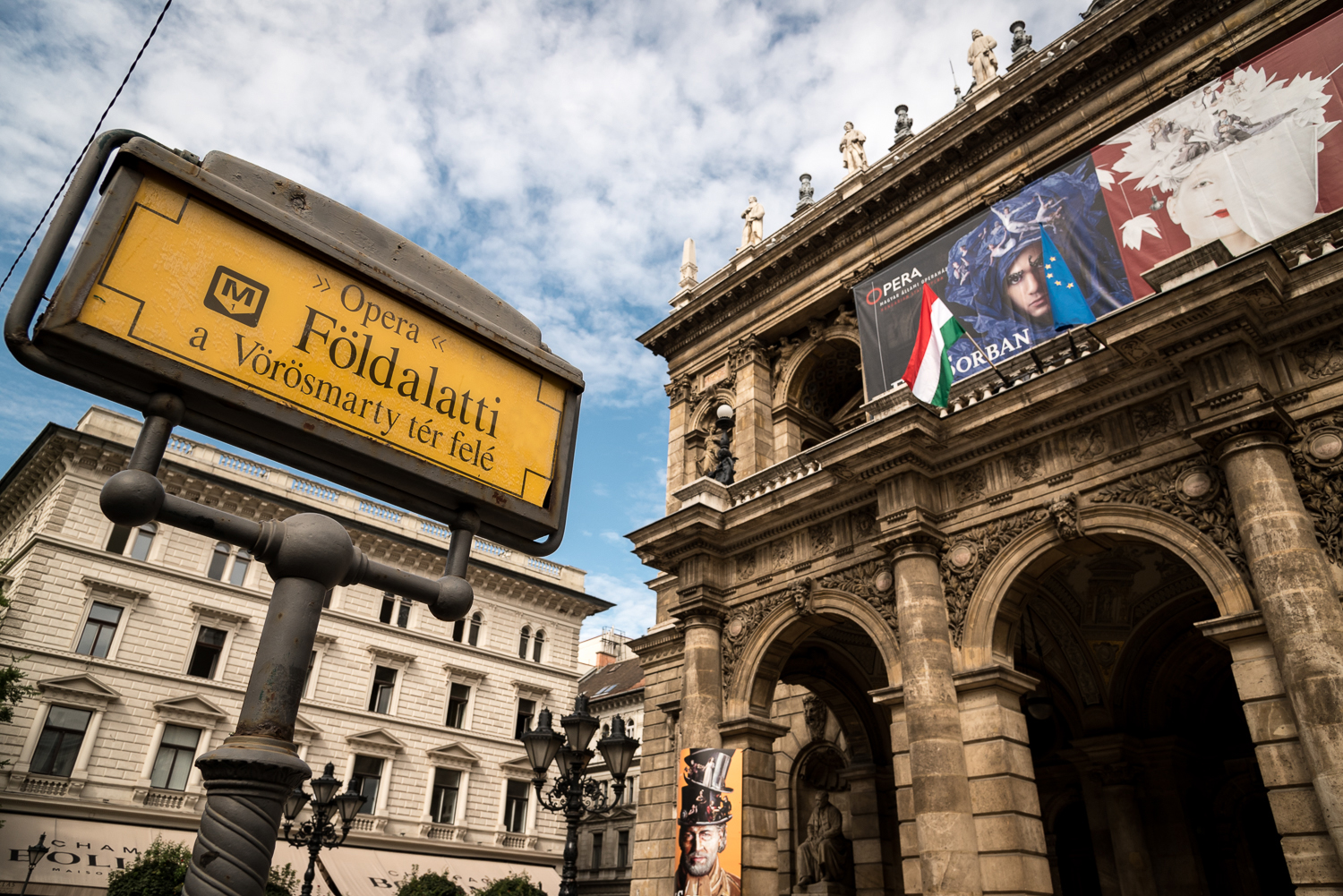
Info & apps
The easiest way to buy tickets and access up-to-date timetables is via the BudapestGO app , available for Android and iOS . Budapest transport company BKK has offices at key stations such as Deák Ferenc tér , Déli pályaudvar and Keleti pályaudvar . They also sell tickets and distribute paper maps . Maps Timetables BKK website BKK app for Androids BKK app for Apple
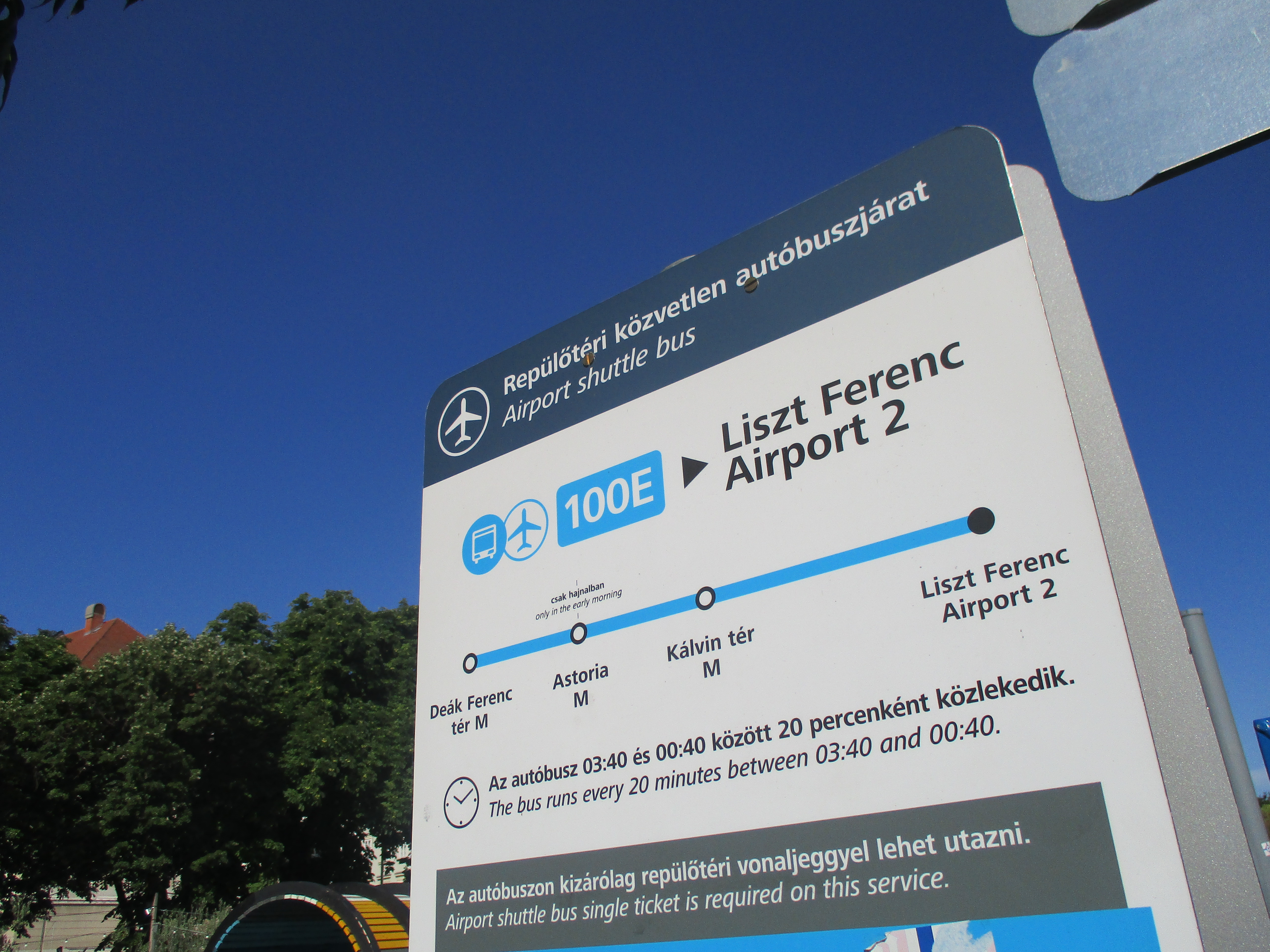
Budapest Airport to city centre
The 100E bus is the best service from the airport to town by public transport. Taking 45 minutes, it calls at Kálvin tér , Astoria and Deák Ferenc tér , all within a short walk of each other in the city centre. As you exit Arrivals, you see the bus stop and English-friendly ticket machine past the taxi kiosk. Tickets cost 1,500 forints – look out for the plane logo on the screen. Machines accept credit cards and Hungarian forints (change given), drivers take cash only. The 100E runs every ten minutes – the first sets off from town at 3.30am and the last service pulls out of the airport at 1.30am .
Alongside, the 200E bus sets off for south Pest, calling at many stops en route. The terminus 25 minutes away is the last station on blue metro M3, K őb ánya-Kispest , but as the line is being renovated, replacement buses serve the rest of the journey into town. Standard BKK tickets (HUF 350, see below ) are valid on this route, but you’ll need to use another for your onward journey . There are Customer Service Points at Terminals 2A (daily 8am-10pm) and 2B (daily 9am-9pm), with English-speaking staff. For details of other ways to get from Budapest Airport to town, see here
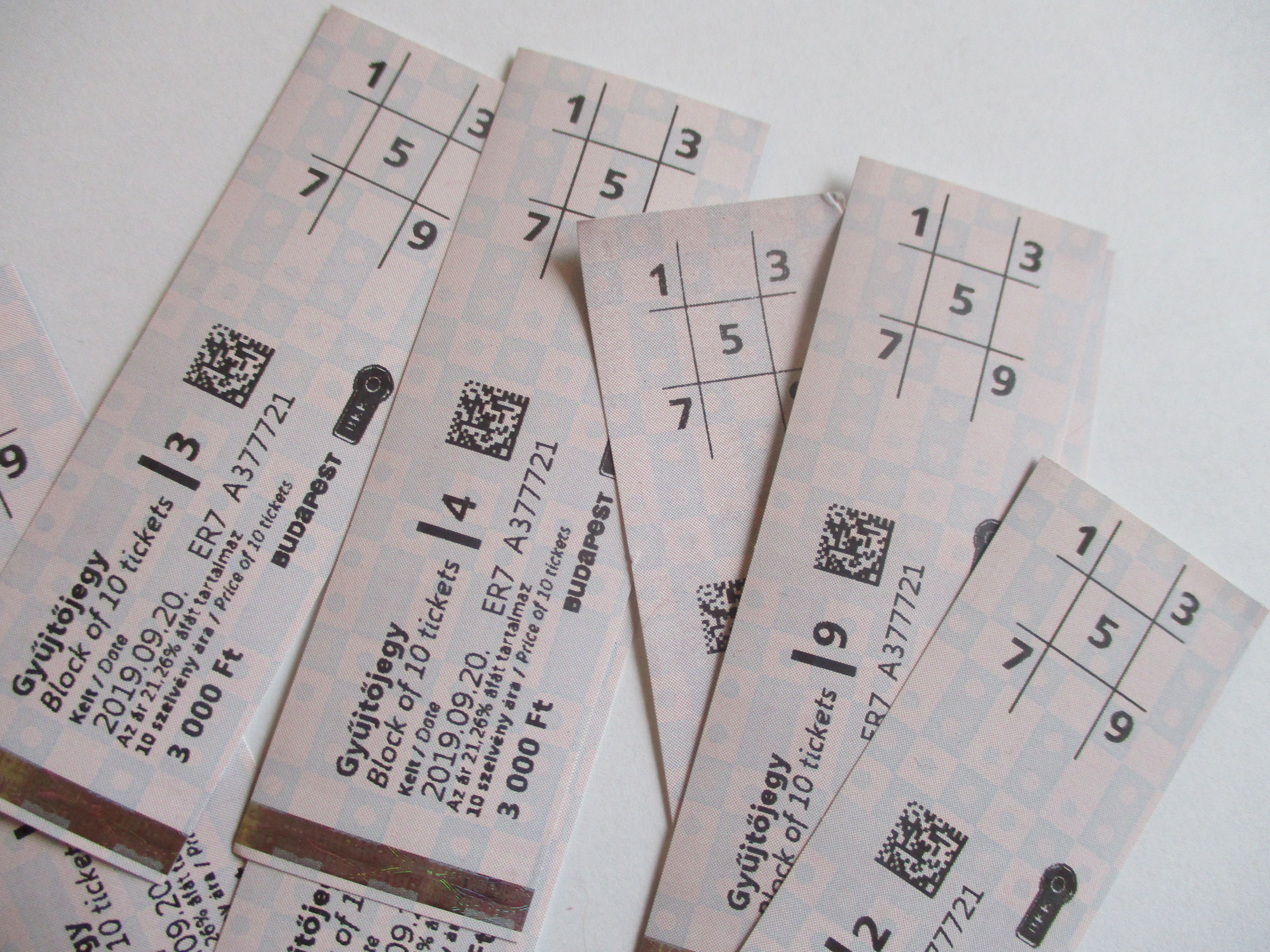
Buying tickets
Tickets and passes can be purchased with the BudapestGO app ( see above Info & apps ). Alternatively, you can use the English-friendly machines at metro stations , tram and bus stops. The BudapestGO app has a map with their locations . Newsstands also sell tickets. Machines take cards and Hungarian forints in cash, but only bills of 5,000 and below. BKK offices (look out for the purple signage) operate within main stations such as Deák Ferenc tér , Déli pályaudvar and Keleti pályaudvar . Assistants can provide information and maps as well as tickets – a machine by the door dispenses numbers to find your place in the queue. You can also buy from the driver on trams and buses, cash only, 450 forints for a single ticket as opposed to the 350 forints if bought in advance. See below , Ticket types .

Ticket types
Single tickets A single ticket ( vonaljegy , HUF 350) is for any one-way, uninterrupted ride on any bus, tram, trolleybus or metro line from one end of the line to the other. Transfers are permitted between metro lines but not between types of transport . There are no returns available. If you're changing types of transport, there are transfer and time-based tickets available, see below . More information Any ticket purchased directly from the driver costs 450 forints. More information
Ten trips There’s a discount if you buy ten tickets at a time, tíz darabos gy űtőjegy . This little booklet costs 3,000 forints , so a 500-forint saving than if you buy ten individually, and are issued as single tickets. This allows you the freedom to use as you wish. More information However, if you plan on using the public transport frequently over a certain period of time , you may consider a longer-term pass ( see below , Time-based tickets & passes ).
Transfer tickets At 530 forints, these tickets allow you a single journey with one transfer , say between bus and metro, or different bus lines. More information Short-section tickets (3 stops or fewer) Valid on the metro network for three stops , for 30 minutes after validation. Transfers are allowed, but only between metro lines , and only for three stops . These cost 300 forints . More information Boat tickets Main city boat lines D2, D11 and D12 are currently suspended, with only the D14 running between Csepel and Molnár islands . However, those with a monthly pass or longer may use the Circle Line run by the Mahart boat company for free between Tuesdays and Fridays. A day ticket otherwise costs 1,500 forints. BKK passholders must register at the Mahart ticket office before boarding, and pay at weekends like everyone else. The Circle Line sets off every day except Monday from Pier 5 at downtown Vigadó tér , five times a day at two-hour intervals from noon. It calls at Margaret Island and Batthyány tér , taking one hour 15 minutes to complete the journey from and to Vigadó tér.
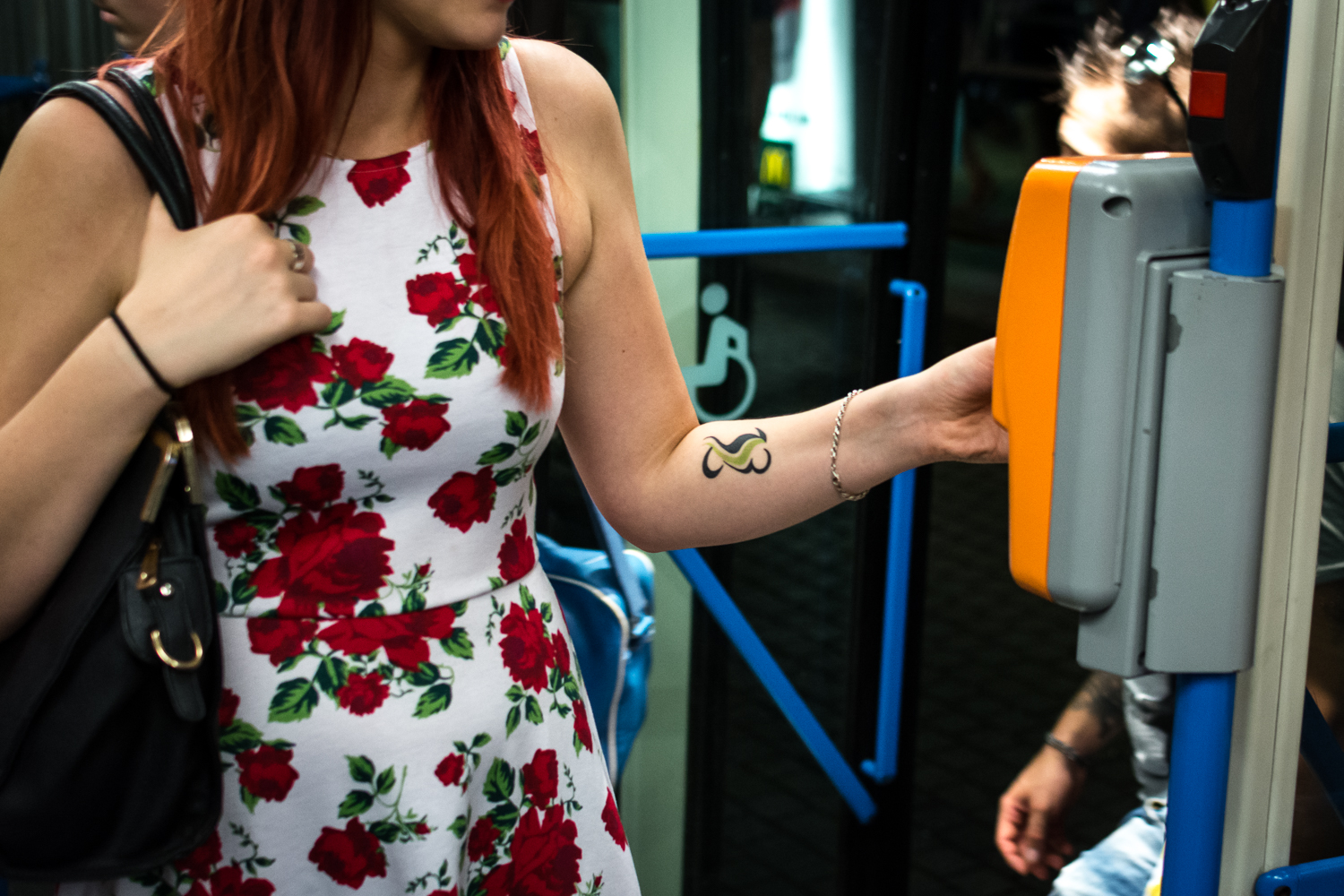
Validating tickets
Paper tickets must be validated before boarding the metro . Tickets for buses and trams are validated after you board – buses require you to enter via the front door and show your pass to the driver or validate your ticket in the machine next to him. Failure to validate your ticket can result in a fine when inspectors come round, 8,000 forints if paid on the spot, 16,000 forints if paid within 30 days . How to validate The metro and modern vehicles are equipped with orange machines – insert your ticket into the slot in the middle. You will hear it whirr as it stamps your ticket . Should a machine fail to work, find another one – there will be a row at the top of metro escalators and along each vehicle. Paper tickets will have a silver strip at one end, and a grid with numbers at the other end. Validate the end with the grid. While it seems excessive, some ticket checkers will fine you for validating the wrong end .
Older vehicles contain red punchers . Insert the grid end of the ticket, with the grid facing you , into the slot, and pull the black lever towards you. You should hear it manually punching the ticket. Again, if it doesn’t work, there will be other punchers further along the carriage. Tickets for boat and heritage services are not validated by stamping or punching, they will be validated by the crew . Similarly the 1,500-forint ticket for airport bus 100E ( see above , Budapest Airport to city centre ) is usually torn off by the driver or his assistant by the stop on the pavement. See this video for validating tickets:
Once validated, tickets must be used within 80 minutes of stamping or 120 minutes for night services . Transfers can only be made between metro lines only. Journeys involving transfers between metro , bus and tram must have a separate, validated ticket, or consider a transfer ticket , as listed above .
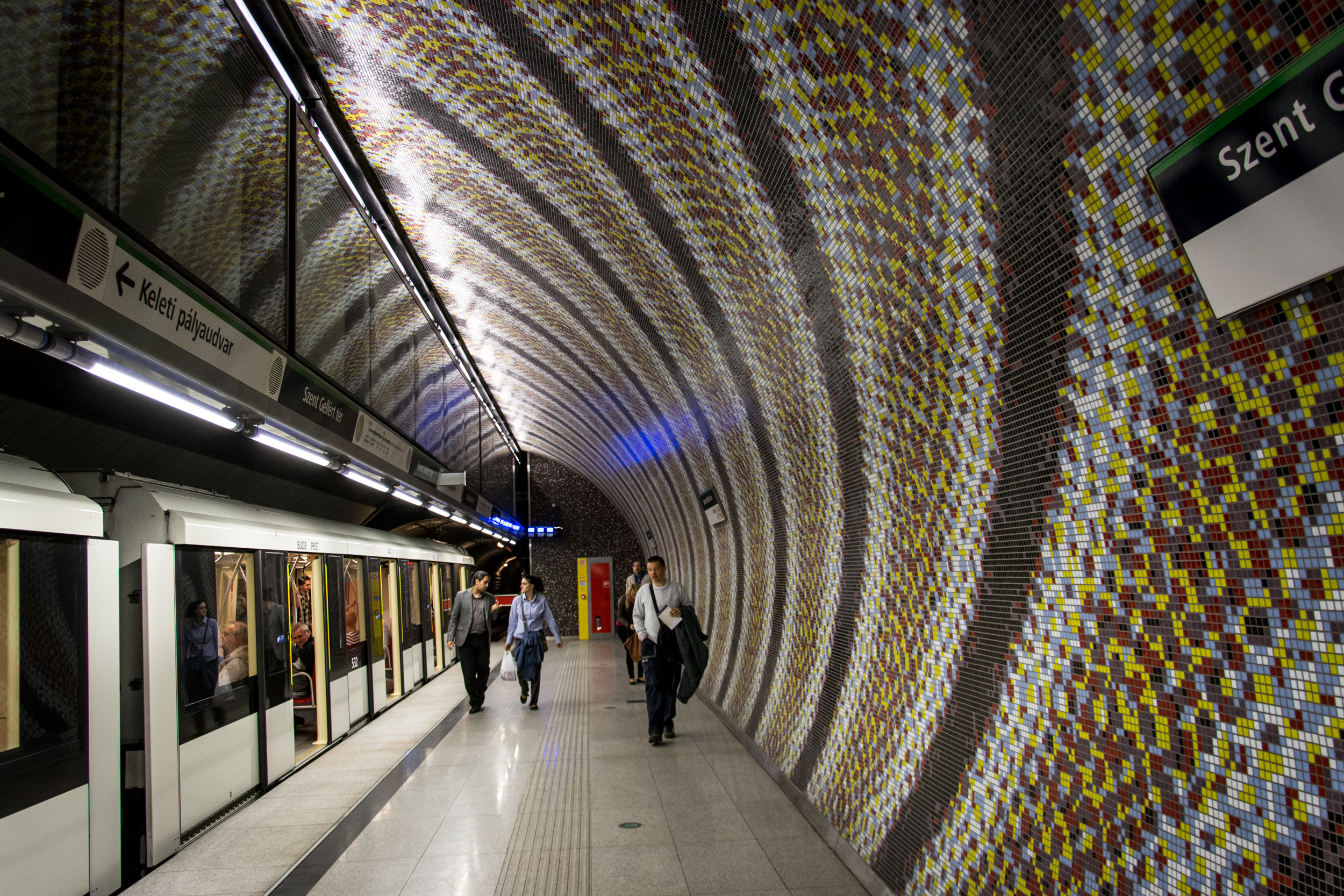
Time-based tickets & passes
Recently introduced time-based tickets for 30 minutes (HUF 530) and 90 minutes (HUF 750) allow unlimited use of the metro, buses, suburban trains (HÉV) etc, within the city limits . As long as you start the final section of your journey within the time limit , your ticket will still be valid . 24- and 72-hour travel passes Valid for 24 hours (1,650 HUF) and 72 hours (4,150 HUF) after purchase, these allow unlimited trips within the city limits. No validation is required before travel. 5/30 travel pass A 5/30 travel pass (4,550 HUF) contains five tickets, each valid for 24 hours. A calendar and time option is printed on the tickets, and users must mark on the day and time they intend to begin their 24 hours of validity . This must be used within 30 days of the first use.
Seven-day travel pass Valid from midnight on the indicated starting day until 2am on the seventh day thereafter. Unlimited trips are permitted within the city limits. A valid photo ID must accompany the travel card if challenged. The seven-day pass costs 4,950 forints. Longer travel passes A valid photo ID must also accompany travel cards for 15 days (HUF 6,300), and passes for a month (HUF 9,500), a quarter (HUF 28,500) or a year (HUF 217,960). Note that lost passes are not refundable. Most Hungarians put their pass in the back of their mobile cover . Discounts Discounted tickets are available for students (HUF 3,450/month) but ONLY for those holding an EU university student card. Quarterly and semester passes are also available. Senior discounts are available for those holding a valid pensioner ID , 3,330 forints/month.
Budapest Card
The Budapest Card is a great way to discover the city, as along with transport access, it grants free admission to many Budapest attractions and other discounts along the way. Prices start from €29/24hrs, then €43/48hrs, and so on. Buy your Budapest Card here .
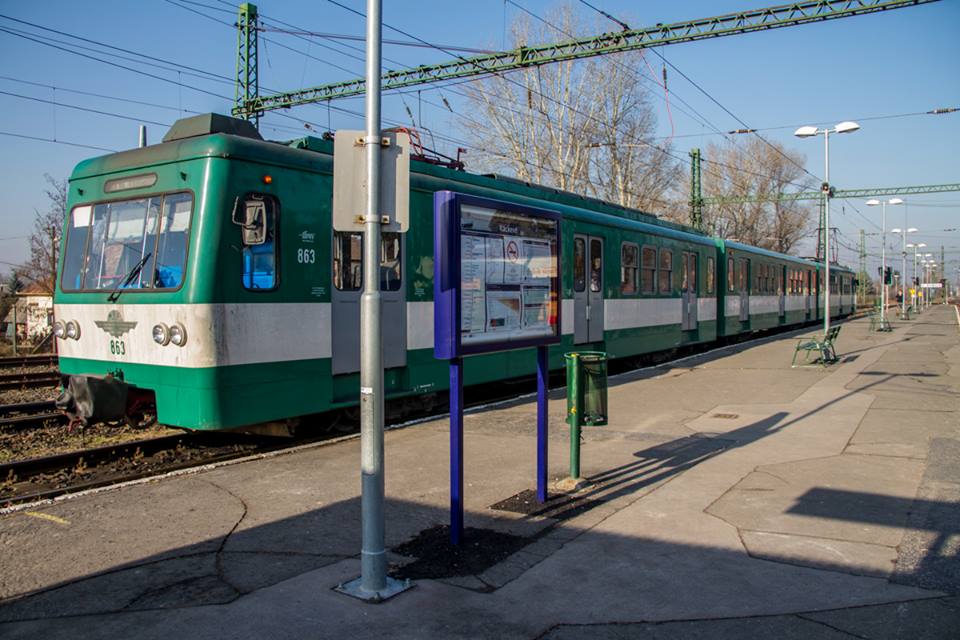
Beyond the city limits
Some buses and all HÉV suburban trains venture beyond the city limits , and travelling to and from them requires additional tickets . These can also be purchased at machines and BKK offices . Supplements are charged from 10km beyond town , then in 5km increment s . See a price list here . Tourist-friendly Szentendre , the most popular option, requires a 310-forint levy, for example. Other destinations include Gödöllő with its grand palace and gardens, and pretty Ráckeve .

Wheelchair accessibility
Wheelchair access is available on many transport lines, including: Buses Over 90% of buses in Budapest have low-floor capabilities . Trolleybuses Low-floor trolleybuses operate on every line , though not on every service . Check the timetable for details.
Metro Metro 1 is currently not accessible. Metro 2 has barrier-free access at the Örs vezér tere , Pillangó utca and Puskás Ferenc Stadion stations. At Örs Vezér tere, the platform design supports barrier-free boarding and disembarking . Lifts are available at the other two stations. Metro 3 is currently under long-term renovation . The newest stations on the northern section of the line, between Göncz Árpád Városközpont and Újpest-központ . Other stations should follow suit as they are unveiled. Metro 4 is accessible by lifts in all stations. More information , including details of parallel routes by bus or tram should step-free access by metro not by available.
Travelling with your bicycle
Bicycles can be transported on several tram and bus lines , one trolleybus route and all HÉV suburban railway lines but you will have to buy and validate an extra single ticket . All details are given here .

Travelling with your dog
Dogs can ride for the price of an extra ticket but they cannot take up a seat , and must be carried on the metro escalators . Those being carried as hand luggage in a closed container do not require an extra ticket. Guide dogs are also exempt. Dogs must be on a leash and wear a muzzle . More information
Related content

Eco-friendly Budapest – How to go green around town in 2024
If you visit or live in the Hungarian capital, here’s how you can contribute to the city’s nature-friendly initiatives.

New urban district to be built on the Danube, with artificial lake and sandy beach
A Mediterranean lagoon in Budapest? Sure, why not? With the new project, you will soon enjoy a sandy beach, a luxury hotel, and shopping facilities!

10 family-friendly attractions to enjoy with kids in Budapest
Budapest is not only child-friendly but child-focused.
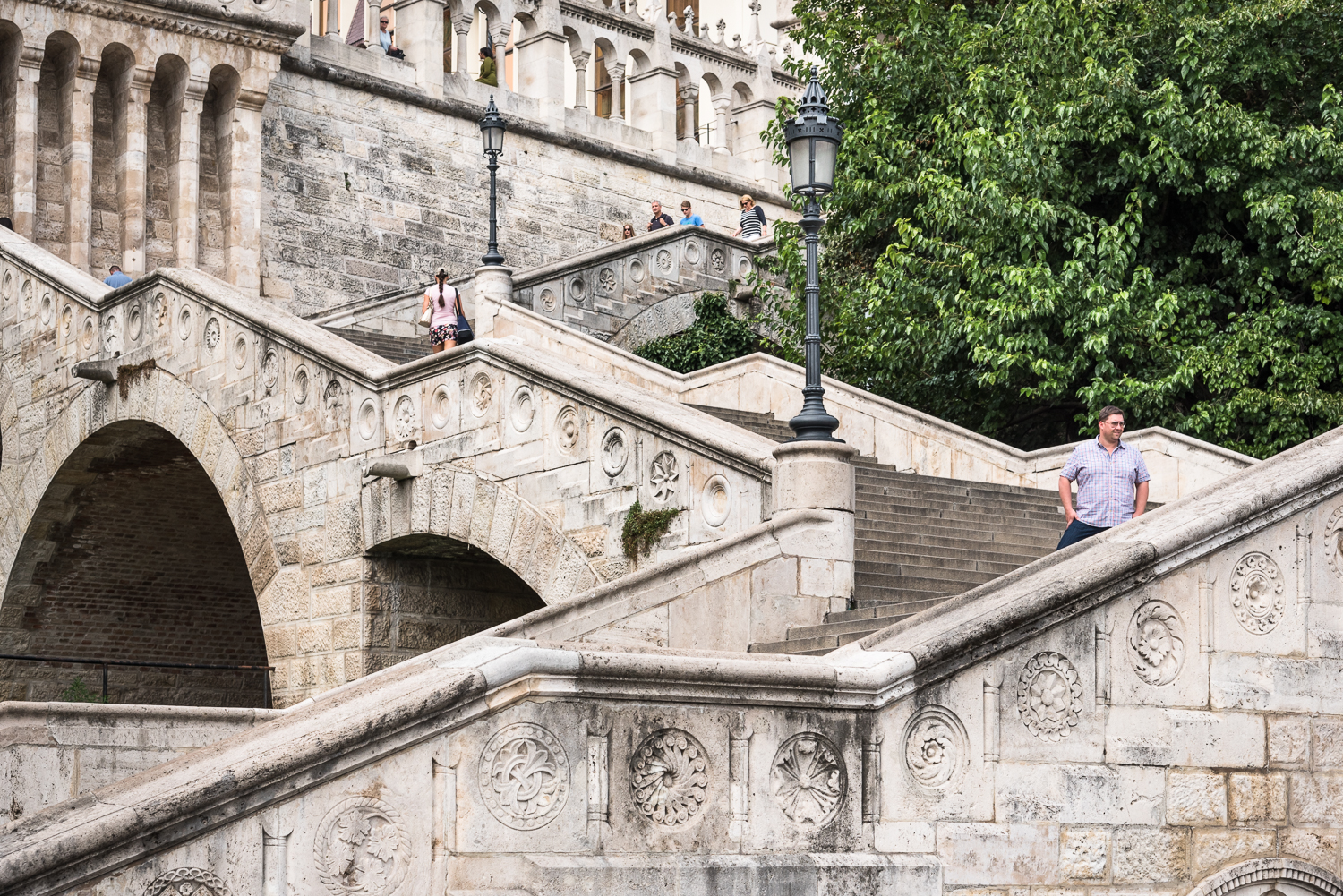
The astounding stairways of Buda Castle
Many routes lead to the hilltop sights of Budapest’s most hallowed neighborhood, but these sets of statuesque stone steps are enchanting in and of themselves.
Budapest Travel Guide
Useful Budapest travel resources
Home » Public Transportation
Public Transportation
Budapest has an extensive and efficient transportation system. If you have some patience and minimal skills with reading maps, you can easily learn the system. The biggest disadvantage, however, is that metros and tram routes shut down for the night at around 11:30pm. Some areas of the city, most notably the Buda Hills, are beyond the reach of some night bus services. Taxis to the rescue.
The transport organiser of the Municipality of Budapest is the Centre of Budapest Transport ( BKK ). When travelling , its passengers will come across metro trains, trams, trolleybuses, suburban railway trains, riverboats and buses, on which BKK tickets, travel cards and passes are valid (with the exception of the funicular, the chairlift and the boat services at weekends).
During rush hours, all forms of transport are crowded, making it best to plan your travel around these times. Most importantly, crowded public transport is the place where you are most likely to be targeted by Budapest’s professional pickpockets.
Public Transportation Map
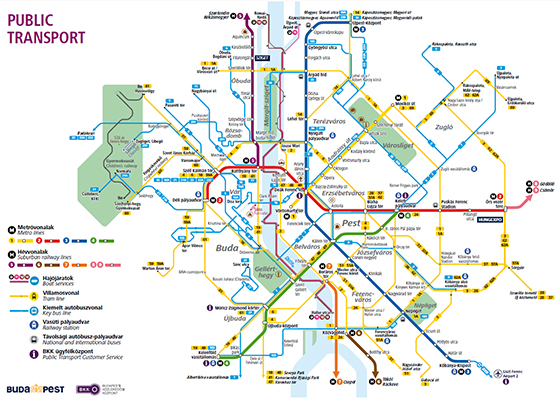
Fares in Budapest
BKK ticket offices
All forms of public transportation (metro, bus, tram, trolleybus, some HÉV railway lines, and cogwheel railway) in Budapest require the self-validation of prepurchased tickets ( vonaljegy ), which cost 350 Ft (EUR 1.11, or USD 1.34) apiece (children 5 and under travel free); single tickets can be bought at metro ticket windows and newspaper kiosks.
Before boarding, please purchase your tickets, travelcards or passes at BKK ticket offices (Please click link to find the locations of BKK customer service centres, TVMs and ticket offices on the interactive maps) located at major transport hubs. Most ticket offices are open between 5:00 and 22:00.
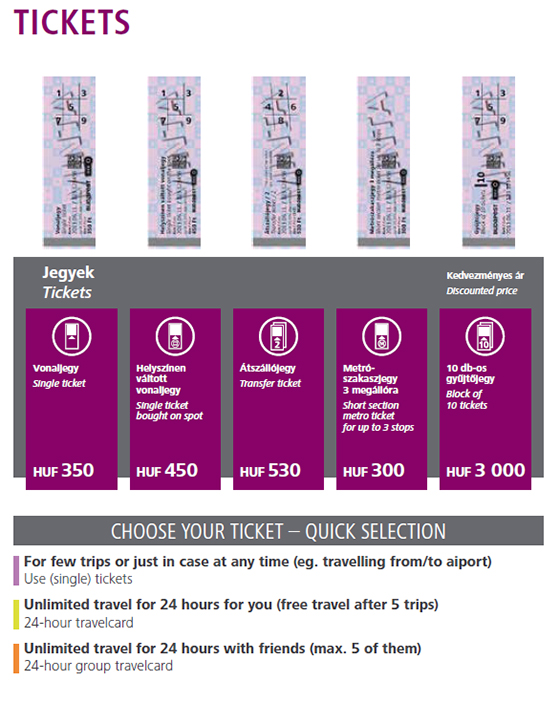
There are also automated machines in most metro stations and at major transportation hubs, but we still don’t trust them. We recommend buying a transport pass to avoid the trouble of constantly having to replenish your tickets. For 3.000 Ft (USD 11.5 / EUR 9.52) you can get a 10-pack (tízes csomag).
Don’t miss your ideal ticket. The whole range of tickets and passes are available at BKK customer centres and ticket offices only.
We strongly recommend that you buy a transport pass, which does not require validation. They are available for 1 day (napijegy) for 1,650 Ft and are good for 24 hours from the day and time marked. The other pass options are 3 days (turistajegy) for 4.150 Ft, 7 days for 4.950 Ft or for longer stays, 15 days (kéthétibérlet) for 6.300 Ft. The 7-day and 14-day passes need to be signed. If your plans are even longer, there is a 30-consecutive day pass (30 napos bérlet) at 9,500 Ft, which requires a photo. If you are going to Budapest for 4 to 5 days, the 7-day (hetijegy) pass is still a saving over individual tickets. Passes are so much more convenient than having a handful of tickets that you have to worry about remembering to validate each time or replenishing your stock at odd hours. Honestly, these will save you money in the long run.
Buy your ticket in advance with your credit card. At most BKK sales points bank cards are accepted for payment. All new TVMs accept regular and also contactless bank cards.
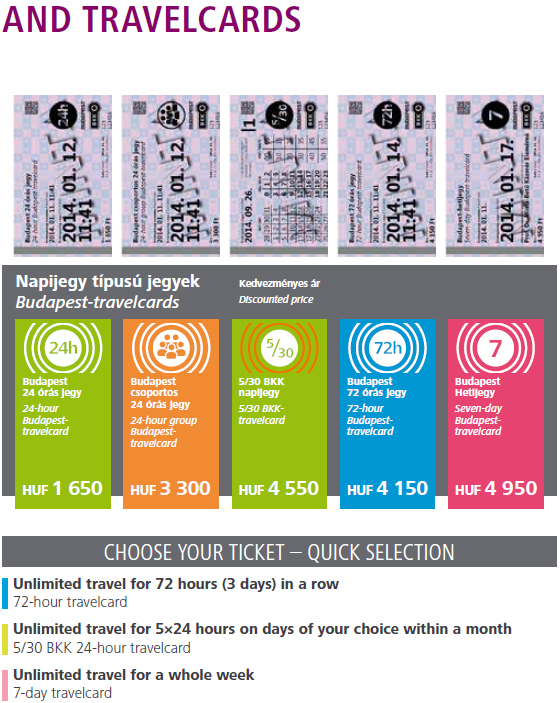
Passes. The 24-hour, 72-hour and 7-day travelcards as well as passes entitle passengers to an unlimited number of trips within the indicated period. Public transport boat tickets are valid only for single, one-way journeys.
BKK Customer Service Centres
- M4 Kelenföld railway station underpass level. Open: 5:30–22:00
- M2, M4 Keleti railway station underpass level. Open: 5:30–22:00
- M1, M2, M3 Deák Ferenc underpass level. Open: 6:00–23:00
- M4 Móricz Zsigmond körtér. Open: 5:30–22:00
Customer Service Points at Budapest Liszt Ferenc International Airport – arrival level:
- Terminal 2/A open: 8:00–22:00
- Terminal 2/B open: 9:00–21:00
Tips for your travel
Please keep your ticket until the end of your trip as the inspectors may ask to check it any time.
Some vehicles feature front-door boarding only. Please validate your ticket or show your pass to the driver when boarding.
If you are not in possession of a valid ticket, travelcard or pass, the inspectors are entitled to issue an on-the-spot fine of HUF 8 000. The fine must be paid in cash in HUF only.
On older-type vehicles the driver will open the door for you so you can get on. On vehicles with an opener next to the door, please push the button to get on.
Some vehicles (buses, night buses and trolleybuses) feature frontdoor boarding only, which is indicated by a sign saying “Elsőajtós felszállás”. Please validate your ticket or show your pass to the driver when boarding.
On most vehicles when you wish to get off, please push the stop request (leszállásjelző) button to indicate your request. The button is to be found next to the door.
For getting off from buses and trolleybuses please use the rear doors .
Passengers are allowed to cross the platform safety line only when the metro or suburban railway train has already stopped; please stand back from the platform edge until then.
Please stand on the right on the escalators at metro stations, to give more space to passengers in a hurry.
Please pay extra attention to your valuables at all times, especially when the vehicle is crowded.
Schedules & maps

All public transport operates on rough schedules, posted at bus and tram shelters and in metro stations. The schedules are a little confusing at first, but the column on the left is weekdays, the middle is Saturdays, and the right is Sundays and holidays. Make note of the last ride of the night or you will be waiting for a bus that is not coming until the wee hours of the morning. The transportation map produced by the Budapest Transport Authority (BKK térkép) is sometimes available at metro ticket windows for a small fee. On the map’s reverse side is a full listing of routes, including the all-important night-bus routes. There has been a shortage of these maps and it is uncertain whether they will continue printing them or not.

Night service

Night services (buses plus tram 6 on the Grand Boulevard) run through the night until regular service resumes at dawn. Separate schedules for night and day buses are posted at the relevant stops. A major hub for night bus lines is Astoria. The solo night buses are front-door boarding only; onboard articulated vehicles ticket inspections are carried out at every door.
Most of the Budapest transportation system closes down between 11:10pm or midnight and 4:30am . There are, however, 31 night routes, a dramatic increase over years past. They’re generally quite safe, though you may find a number of loud and inebriated youth or tourists traveling as well. For the most part, they are harmless. Night routes are posted at bus stops if that route has one. All night buses have a 9 as the first of a three-digit number. A few of them share the same numbers as buses on daytime routes or they may actually run different routes.
Underpasses
Underpasses are the way you cross most major boulevards in Budapest. Underpasses are often little underground cities with vendors, shops, and bakeries, some with bars. The most confusing part for a traveler – as well as some long-time residents – is which exit to use. Many of them have as many as five or six different exits, each letting you out onto a different part of the square or street, which can be quite disorienting. Signs direct you, often using the word “felé”, meaning “toward.” The signs will also include the street(s) at the top of the stairs. We suggest that before you enter the underground, you take note of the landmarks on the corner of your destination, framing the direction you will need to follow once downstairs.
By Metro (Underground)

The World Heritage metro line M1 runs on the Pest side between Vörösmarty tér in the city centre and Mexikói út underneath Andrássy út, running to Hősök tere (Heroes’ Square).
Metro line M2 connects Déli pályaudvar in Buda and Örs vezér tere in Pest through the city centre. Two major train stations (Déli pályaudvar and Keleti pályaudvar) are located along this metro line.
Metro line M3 runs between Újpest-Központ and Kőbánya-Kispest stations on the Pest side of the city. Nyugati pályaudvar train station as well as Kőbánya-Kispest station, where Airport Bus 200E arrives, are located along this line.
Metro line M4 connects Kelenföld Railway Station in Buda and Keleti Railway Station in Pest using modern, driverless trains.
The metro system is clean and efficient, with trains running every 3 to 5 minutes on weekdays and 6 to 8 minutes on weekends, from about 4:30am until about 11:10pm. There are four lines, with only the Red and the newest, No. 4 line going under the Danube to Buda. The three “old” lines are universally known by colors, but numbers are also used: Yellow (No. 1), Red (No. 2), and Blue (No. 3). You will see both the color and number on maps, and all signs are color-coded. The old three lines converge at Deák tér, the only point where any of the lines meet.
The Yellow (No. 1) line is the oldest metro on the European continent and second oldest in the world, having been built in 1894 as part of the Hungarian millennial celebration.
Refurbished and restored to its original splendor, it is the most attractive and shortest metro line in the city. Yellow metro signs are different from those for the Red and Blue lines.
They lack the M to signify metro. Instead, the aboveground stations have large yellow signs above the stairwells with the word földalatti (underground). Most of the stations entryways are painted yellow as a visual clue. Each station has two separate entrances, one for each direction. Confusingly, some of the stairwell entrances are in the opposite direction from the direction the train will be going. The Red (No. 2) Blue (No. 3) and the newst, No. 4 lines are modern metros, though the outside of the cars tend to look old and decrepit (except the new Metro line of course). To reach them you descend long, steep escalators; the Red line has the longest and steepest. If you are prone to vertigo, you may want to take care. The Red line runs from Örs vezér tere in eastern Pest, through the center, and under the Danube, finally ending at Déli Station. Nyugati Station is along the Blue line.
Metro stations. At the entrance of metro stations, the validator machines stamp the starting time of your trip onto your ticket.
On the street, distinctive colored “M” signs of both the Red and Blue lines point out the stations. Validate tickets at automated boxes before you descend the escalator. When changing lines at Deák tér, you’re required to validate another ticket (unless you have a special “metro transfer ticket”). The orange or red validating machines are in the hallways between lines, but are easy to miss, particularly if there are big crowds.

The extensive Budapest bus network of almost 200 lines provides access to the city centre from almost anywhere within and outside of the city with an average frequency of 10–15 minutes. More than half of the fleet are low-floor vehicles. On some services a front-door boarding only policy is in place. The old buses are dark blue, while the new ones have sky-blue livery (same fares apply for both).
Many parts of the city, most notably the Buda Hills , are best accessed by bus. Although buses are the most difficult to use of Budapest’s transportation choices, with patience (and a BKK map) you’ll be able to get around.
With the exception of night buses, most lines are in service from about 4:30am to about 11:30pm. Some bus lines run far less frequently (or not at all) on weekends, while others run far more frequently (or only) on weekends. This information is posted at every bus stop.
Black-numbered local buses constitute most of the city’s lines. Buses with red numbers are express buses that skip minor stops. Check the list at the stop to see if your destination is one of the stops. If the red number on the bus is followed by an E (there are only five routes with an E), the bus makes very few stops between terminals and is best avoided. Look for the sign on the front of the bus to see if it is a regular or express.
Tickets are self-validated onboard the bus by red boxes found by the doors. You can board the bus by any door, but manners dictate that you stand to the side of the door to allow disembarking passengers out before you start to board. Each time you change buses, you need a new ticket and have to validate it. Again, this is not necessary with a transport pass. Tickets cannot be purchased from the driver; see “ Fares ” above for more information.

The dense tramline network features picturesque routes. One of the most beautiful tramlines of the world, tram 2 runs along the river Danube in Pest on the Pest side between Margit híd and Boráros tér, provides an incredible view of the Buda Hills , including the Castle District . It is better than a tour bus. We especially recommend this route at night. The world’s longest open-gangway, walk-through trams serve lines 4 and 6 , on the busiest tram routes in Budapest travelling along Nagykörút, the Grand boulevard, connecting Pest and Buda encircling the city centre. Tram 4 runs between Széll Kálmán tér and Újbuda-Központ, while tram 6 runs 0–24h between Széll Kálmán tér and Móricz Zsigmond körtér. Trams 1 and 3 are also among the most important lines with ring-shaped routes surrounding the city.
You’ll find Budapest’s 32 bright-yellow tram lines (known as villamos in Hungarian) very useful.
Tickets are self-validated onboard. As with buses, tickets are valid for one ride, not for the line itself. Important: The red buttons near the tram doors are for emergency stops, not stop requests. When a tramline is closed for maintenance, replacement buses are assigned the tram route. They go by the same number as the tram, with a “V” (for villamos) preceding the number. See “ Fares ” above for information on tickets.
By Trolleybus

The environmentally-friendly, quiet and electrically powered (receive power from a cable above the street) red trolleybuses have a dense network in the inner city on the flat Pest side of the city. One line that can be of use to visitors is the 70 which originates near Kossuth Lajos tér by the Parliament and cuts through the city centre via Nagymező utca (Budapest’s “Broadway”) before crossing Andrássy út and running on Király utca on its way to the Városliget (City Park).
There are only 16 trolleybus lines in Budapest, all in Pest. Of particular interest to train travelers is No. 73, the fastest route between Keleti Station and within a block of Nyugati Station . All the information in the “By Bus” section above applies to trolleybuses as well. See “ Fares ” above for information on tickets.

Hév (suburban railway lines) serve the outer areas of Budapest. If you are going to destinations nearby Budapest, for example to Szentendre (H5) or to Gödöllő (H8), please remember to get extension tickets needed for the route sections outside of the city boundaries which are not covered by your tickets, travelcards or passes. Line H7 is an exception as it operates only within Budapest. Suburban railway passes are also available; they are for sale along with tickets at BKK ticket offices and from new purple-coloured Ticket Vending Machines. Tickets are also sold by conductors onboard suburban trains.
Leaving the city boundaries by suburban railway (HÉV), passengers have to purchase an extension ticket at the ticket office or from the conductor on board if the ticket office is closed.
However there are four HÉV lines; only the Szentendre (H5) line is of importance here. Most hotels, restaurants, and sights in northern Buda and Óbuda are best reached by the HÉV (so indicated in the directions given). To reach Óbuda ’s Fő tér (Main Sq.), get off at the Árpád híd (Árpád Bridge) stop. For trips within the city limits, the cost is one transit ticket, self-validated as described above, or use a pass. The HÉV suburban railroad connects Budapest’s Batthyány tér with Szentendre . On the Pest side, you can catch the HÉV from the Margit Híd, Budai Híd Fő. Trains leave daily, year-round, every 20 minutes or so from 4am to 11:30pm (trip time: 45 min.). The one-way fare is 560 Ft subtract 230 Ft if you have a valid Budapest public transportation pass. The trip takes 45 minutes. This HÉV route runs regularly between 4am and 11:30pm.
By Cogwheel Railway & Funicular

Budapest’s cogwheel railway (fogaskerekű) began running in 1874, becoming electrified in later years. It runs from Városmajor, across the street from the Hotel Budapest on Szilágyi Erzsébet fasor in Buda, to Széchenyi-hegy, one terminus of the Children’s Railway (Gyermek Vasút) in 20 minutes.The cogwheel railway runs from 5am to 11pm, and normal transportation tickets (see “ Fares ,” above; self-validated onboard) are used.
The cable car or funicular (sikló) connects Buda’s Clark Ádám tér, at the head of the Széchenyi Chain Bridge , with Dísz tér, just outside the Buda Castle. The funicular is one of only two forms of public transportation serving the Castle District (bus Nos. 10 and 16 are the other possibilities; see “By Bus,” above). The funicular offers an extremely steep and short ride, but an excellent view. It runs at frequent intervals from 7:30am to 10pm daily (closed on the second Mon of the month). Tickets cost 700 Ft ($3.80/L2.35) to go up and 1,300 Ft ($7.30/L4.50) for a round-trip for adults, while children get a break at 400 Ft ($2.15/L1.35) up and 750 Ft ($4.05/L2.50) round-trip.

On the section of the river Danube within Budapest, public transport boats serve several piers located near transport hubs on both the Buda and Pest banks. Line D11 terminates in Újpest, while D12 and weekend-only service D13 operate to Rómaifürdő. On workdays Budapest-passes are also valid for boat services, but at weekends only the dedicated tickets for public transport boats are accepted for travel.

Budapest taxis fall into two general categories: legitimate and not. All legal, licenced taxis must have yellow car colour. The fare to be paid at the destination consists of three basic parts: the base fee; the kilometer distance fare; and the waiting tariff, which is used if the taxi has had to stop or has to travel slower than 15 km/h (9 mph) in traffic.
Please note: From 1 September 2013 a new Taxi Decree was introduced in Budapest and regulating the price of the taxis at a fixed tariff of 280 HUF/Km (0.95 EUR/Km) in addition to the one-off basic fee of 450 HUF (1.50 EUR) and waiting fee.
A ride to the city center from the Airport should typically cost around 6500 HUF (22 EUR) depending on traffic conditions.
We particularly recommend Tele5 (00 36 1 355-5555). Other reliable fleets include City Taxi (00 36 1 211-1111), Volántaxi (00 36 1 466-6666), Rádió Taxi (00 36 1 377-7777), and Főtaxi (00 36 1 222-2222). Call one of these companies from your hotel, ask a restaurant person, or ask whoever is in charge to call for you, even if there are other private taxis waiting around outside. Dishonest drivers will ask you to pay for the return trip, ask to be paid in anything but forints, or quote you a “flat rate” in lieu of running the meter. The chances are slim that you will encounter this with any of the companies above. If you need extra room, request a station wagon by asking for a “kombi”, and in the summer you can also request an air-conditioned vehicle. Tipping is usually not more than 10%. Hungarians usually round the bill up. If you think the driver has cheated you, then you should call the company and complain, as most will punish their members for untoward behavior.
We believe anyone wanting to drive in Budapest has a death wish. Not only are there crazy drivers, but you also will find a serious lack of stop signs or traffic lights on most streets. However, you may wish to rent a car for trips out of the city. Hertz, Avis, Alamo, National, and Budget have offices in the city and at the airport, but marginally better deals may be found by making arrangements directly and in advance on their websites. You are urged to reserve a rental car as early as possible. If you reserve from abroad, ask for written confirmation by fax or e-mail. If you don’t receive a confirmation, it’s wise to assume that the reservation has not been properly made. The driver must be 21 years old with no upper age limit and is the only authorized driver; the driver’s license must be at least 1 year old; an International driver’s license is required.
Gellért Hill (Gellért Hegy)
Comments are closed.
Privacy Overview
City Guide » Travel
Public Transport in Budapest – getting around the city
discover the best ways of getting around budapest – from metros, trams, and buses through taxi companies to eco-friendly transport alternatives..
Compared to other large European cities, Budapest is fairly easy to get around, mostly thanks to its extensive public transport system and some really useful eco-friendly ways that have become very popular lately. From metros and trolley buses to suburban railway lines and even boat services and electric scooters, you’ll surely find your favorite way of getting from point A to point B in a quick, efficient and affordable manner. So let us take a look at different ways you can make the best of your travel in this gem of a city.

Public transport
Budapest airport transfer : th e airport bus.
Most tourists arrive in Budapest by plane, so chances are the first thing you’ll see is Budapest Ferenc Liszt International Airport , so it’s only logical we start with Budapest airport transfer . If you’d like to take public transportation to the heart of the city, you have two options: bus 100E and bus 200E. Both have their final stop at the airport, but 200E goes only until Kőbánya-Kispest metro station, which is the end of metro line 3. Bus 100E goes straight to Deák Ferenc tér, so if you’re looking for the quickest way to the center of Budapest, that would be it.
Bus 100E airport shuttle is special, as this is the only bus you can’t just hop on with a regular ticket or pass. You’ll need to buy a special ticket for 2200 HUF to have direct connection to the heart of the city. By the way, we’ve thoroughly covered all airport transfer options in Budapest, so in case you’re interested, check out this article.
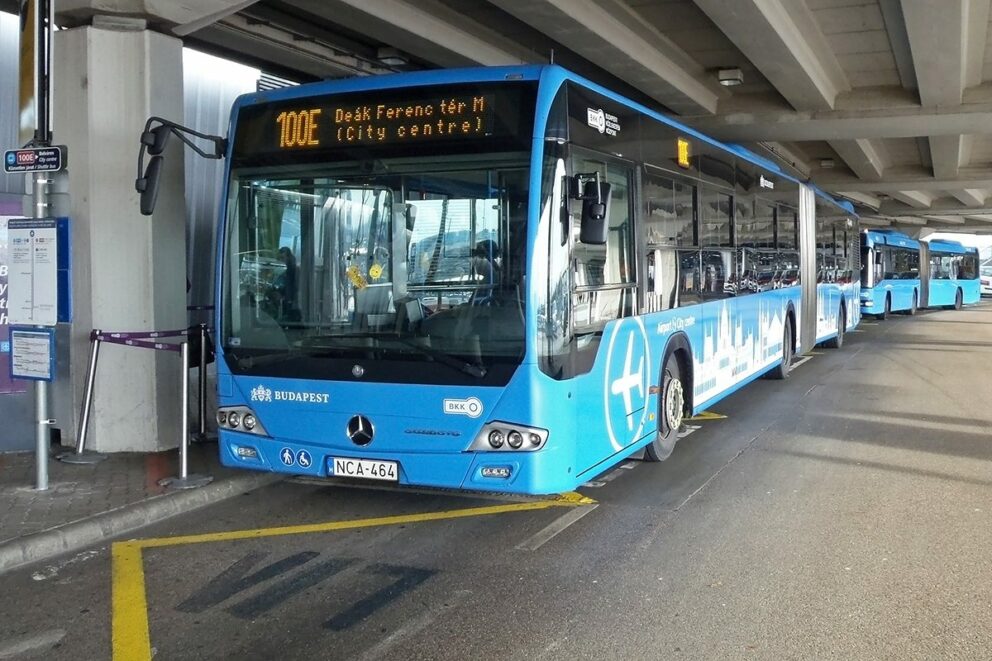
Buses and night buses
There are over 260 bus lines in Budapest, so even if you’re staying in a district that’s further away from the city center, you can count on a bus to take you to the nearest metro station. While they might not be the best choice during rush hour, as traffic can be an issue sometimes, they’re definitely a reliable way to get around.
Enjoying staying out until later at night? No worries, you’ll easily find night buses, as they cover most of the city to grant everyone a quick ride home.
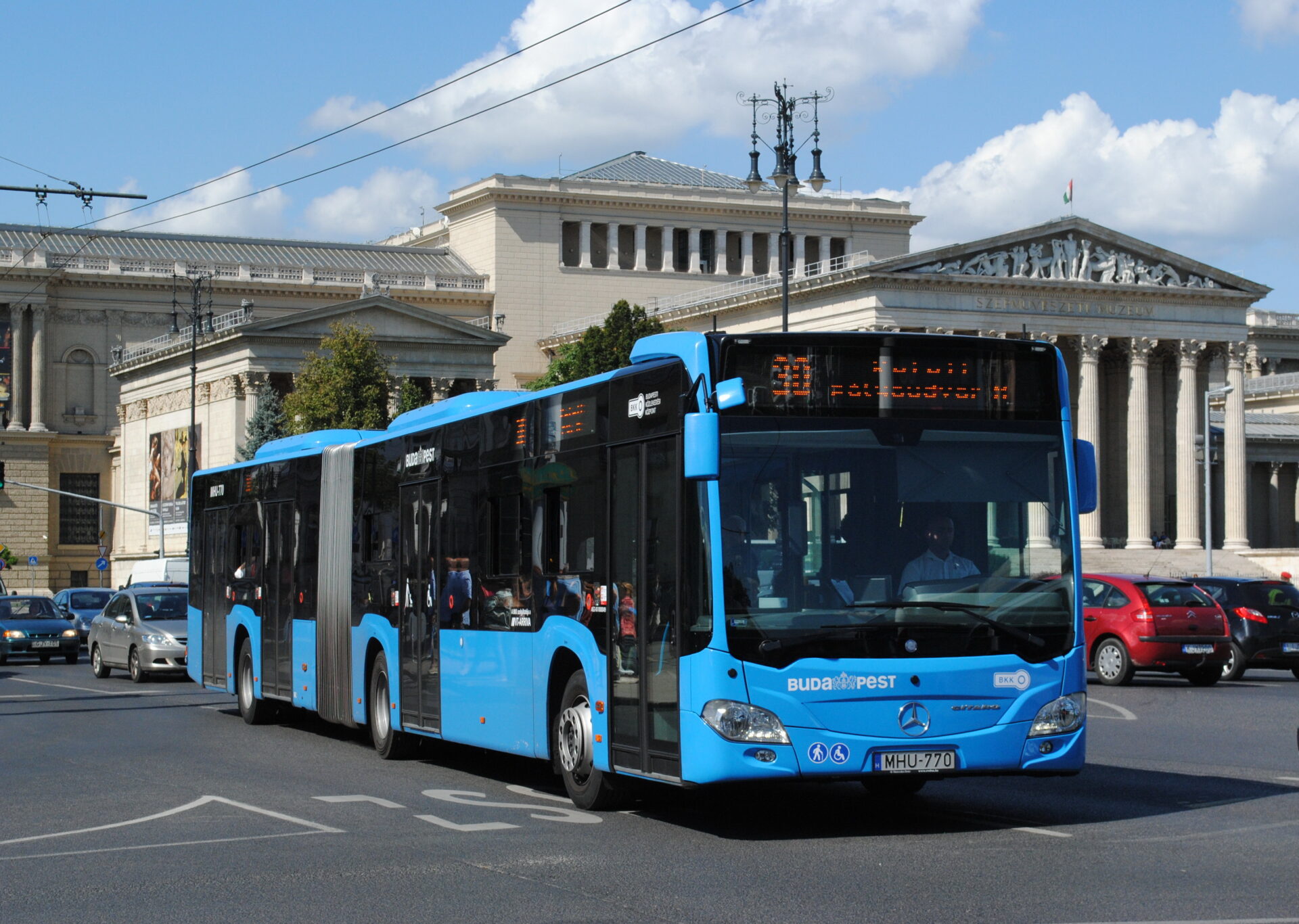
Budapest has one of the world’s largest tram networks, and since trams rarely get stuck in traffic jams, they’re one of the most effective ways to get wherever you want to go. The center of the city, Deák Ferenc tér can be reached by tram lines 47 and 49, and even with 48 on weekends – the old-school carriages are in perfect sync with the inner city’s historical vibes. Tram lines 4 and 6 on the Nagykörút (Grand Boulevard) with one of the most modern trams serve as a backbone of mass transit in the city. They’re usually mentioned together, since there’s only a slight difference in their routes and, as a result, this duo carries the most passengers per day in the world. Added bonus for your convenience: tram line 6 runs all night.
Tram line 2 deserves a special shout-out, since it was included in the top 10 most beautiful tram lines in the world by National Geographic. It runs along the shore of the Danube on the Pest side of the city, and touches many major sightseeing destinations you’ll love, so check our guide on the most iconic attractions along the river [TA1] to get some inspiration. On a related note, tram line 2 isn’t the only noteworthy transportation line in Budapest – check out this article to learn about more.
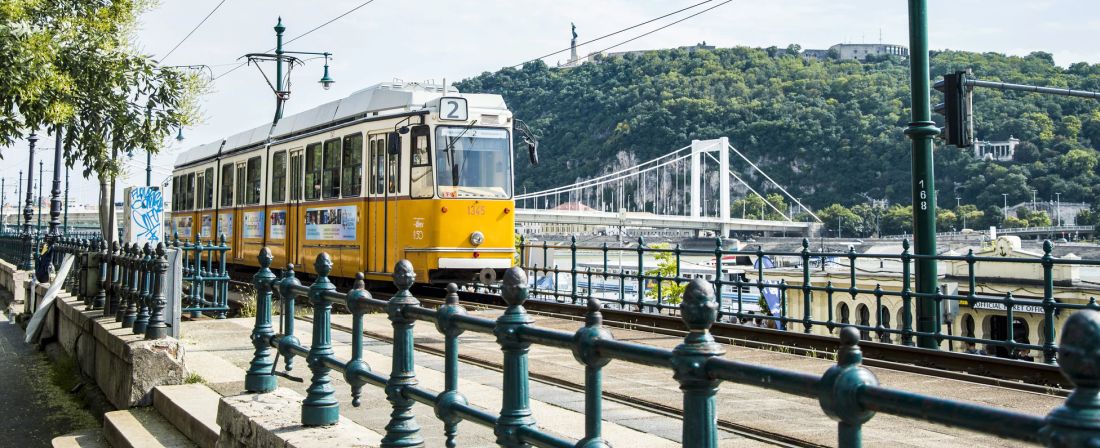
Metro line 1, the world’s second oldest metro line was built in 1896 and is still in operation today. If you want to try something special, be sure to hop on it – it was renovated, but the old-school vibes of the carriages and the stations were purposefully kept.
Deák Ferenc tér serves as a real hub when it comes to public transport in Budapest, metro lines 1, 2 and 3 all have a stop there. Metro line 4 was built in 2014 and connects two railway stations: Kelenföld vasútállomás and Keleti pályaudvar.
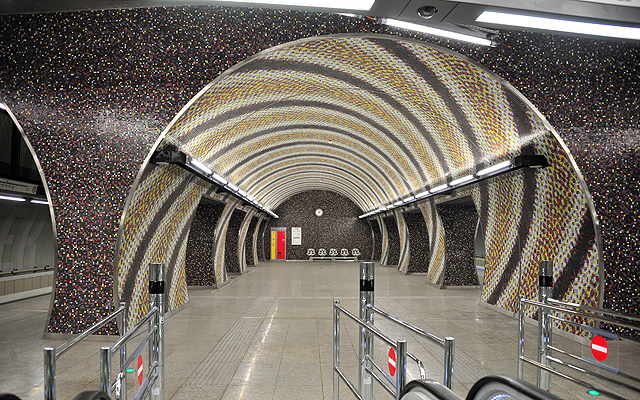
Trolley buses
There are 15 lines available, mostly in the vicinity of the city center. Their numbering is quite odd, though, the lowest number you’ll be able to see on them is 70. It’s no accident: when the first trolley bus was introduced, it served as a tribute to Stalin’s 70th birthday just shortly after World War II.
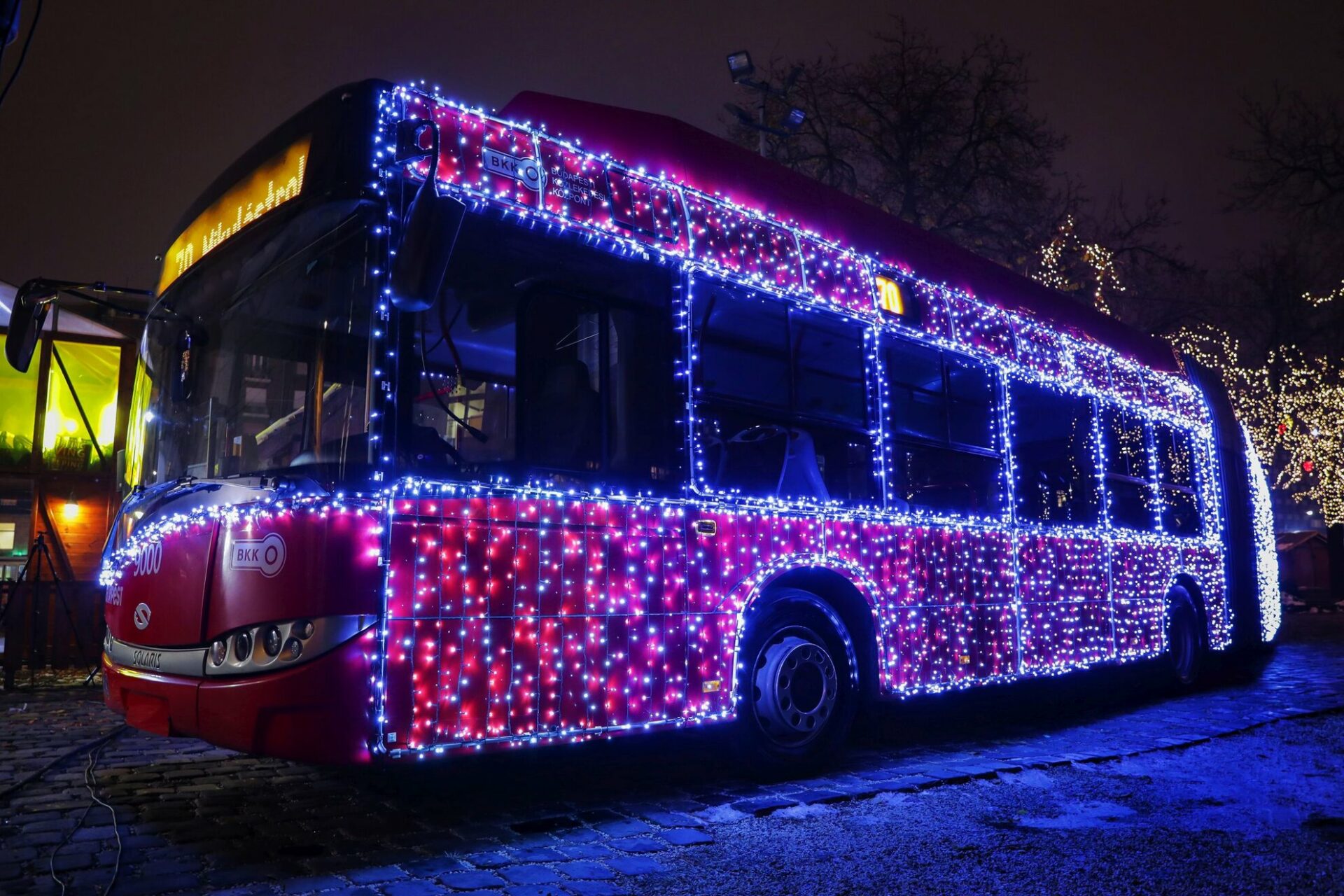
Yes, boats! Pick your favorite from the four available lines and don’t miss out on this amazing opportunity to cruise up and down the Danube while checking out the Parliament or the Buda Castle. The usual single BKK ticket is not valid for them, though, but most passes are.
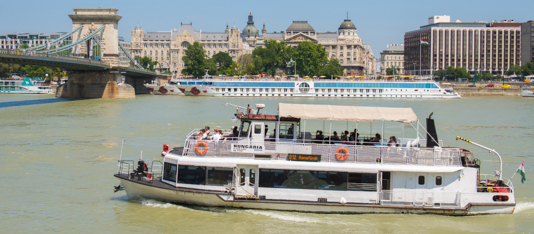
Suburban railways
If you’ve seen a green train with a white stripe on its side, it was a suburban railway (or HÉV in Hungarian). While their main purpose is to connect suburban towns and cities with the capital, they have several stops within the city limits of Budapest – no wonder they’re the most popular way to get to Sziget Festival every summer.
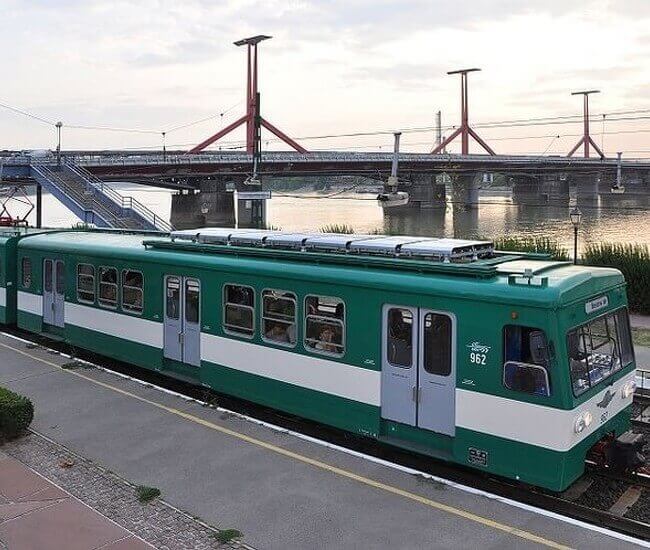
Sikló
The Budapest Castle Hill Funicular is a special gem when it comes to public transportation in Budapest, as there is only one of it, but it’s been in operation since 1870. It connects the Buda end of the Széchenyi Chain Bridge with Buda Castle on the top of the hill. If you’re looking for special experiences, it’s definitely one to try, the view is amazing both going up and down.
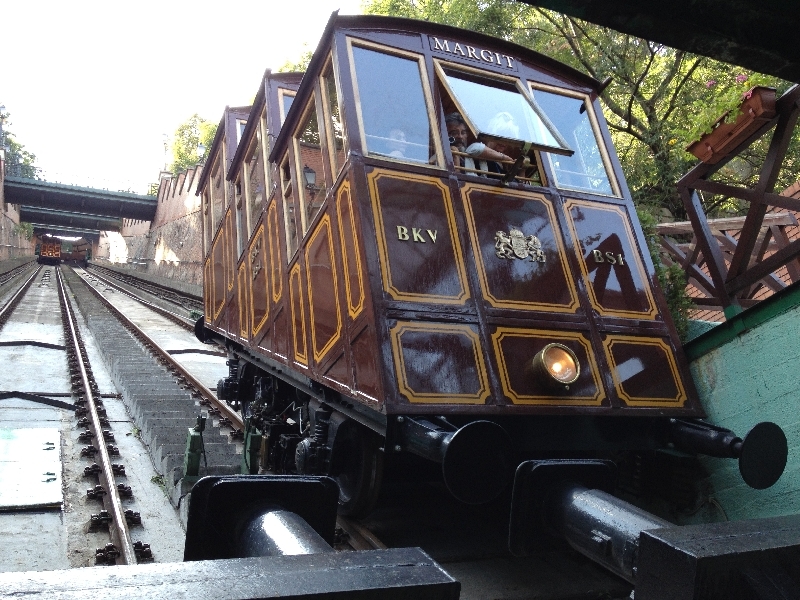
Tickets and passes for public transportation in Budapest
The main transport services are all owned by the Center for Budapest Transport (Budapest Közlekedési Központ, BKK – the abbreviation you should look for). Tickets and passes are valid for buses, trams, metros, trolley buses, and suburban railways, railways and long-distance buses within the administrative limits of the city.
Where to buy
Tickets and passes are available from the purple machines at the entrance of metro stations and larger transport hubs, you can pay both by cash and card. You can also buy tickets from several bus drivers, but it’s more expensive, so it’s useful to think ahead. Tickets need to be validated after purchase, passes don’t. Even though ticket inspections aren’t regular, make sure you always have a valid ticket or pass on you, as fines can be a real pain.
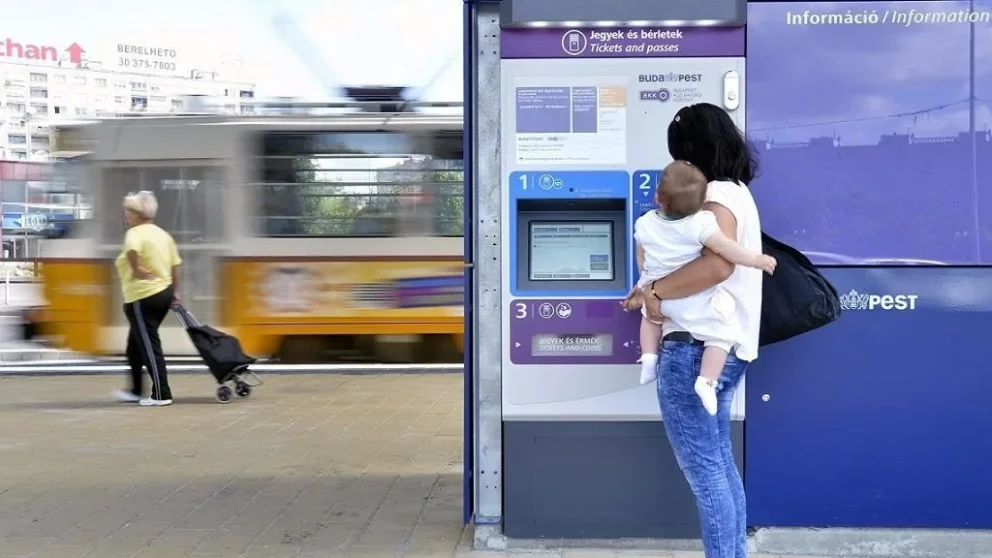
What to buy
It largely depends on individual needs. You have options to choose from a wide variety of tickets and passes, and the general rule of thumb is that the more you travel, the more it’s worth investing in a 24-hour, 72-hour, or a weekly pass. Also, with passes the four boat lines are free, and that’s definitely a nice added bonus. For the best option that suits you, you should check BKK’s official website .
What to download
The most useful application you could have is BKK Futár (available in both website and app form), which gives you the most up-to-date information on arrival times for all vehicles throughout the city.
Alternative transport options in Budapest
There are several taxi companies, but they’re all required to be marked with the word ‘taxi’, and use yellow as their color, so that makes cabs fairly easy to spot. Their tariff is regulated by the government and it consists of three elements: base fare (700 HUF), distance-based fare (300 HUF/km), and time-based fare (75 HUF/min). To avoid any possible taxi scams, it’s always best to call the taxi companies and ask for a cab directly.
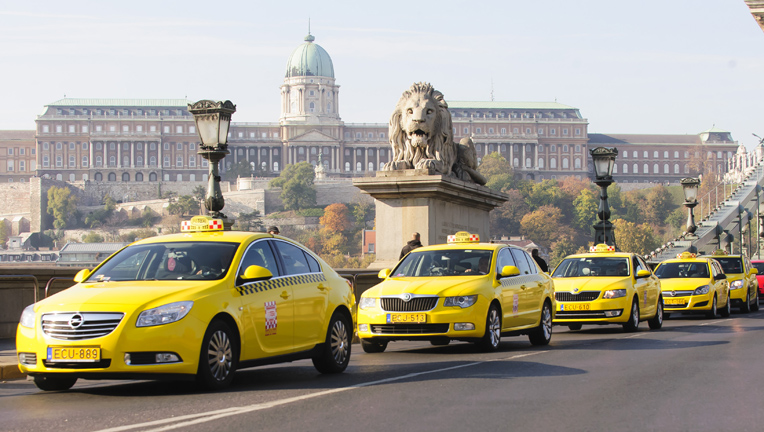
Bolt is an alternative to Uber (which is unfortunately no longer in service in Hungary), and it’s generally cheaper than the yellow taxis. Just download the app , register your credit or debit card, and you’re ready to order your first drive, wherever you’d like to go.
MOL Bubi, Donkey
Feeling sporty? Ride around the city on two wheels with the help of MOL Bubi or Donkey . Cycling has become more popular recently, so you’ll find a lot of bike lanes and roads around Budapest. Just rent a bike via their app and make the most of your day in town.
Not up for a bike ride, but feel like going green? Lime is just for you. Just download the app , rent an electric scooter, and you’re ready to go.
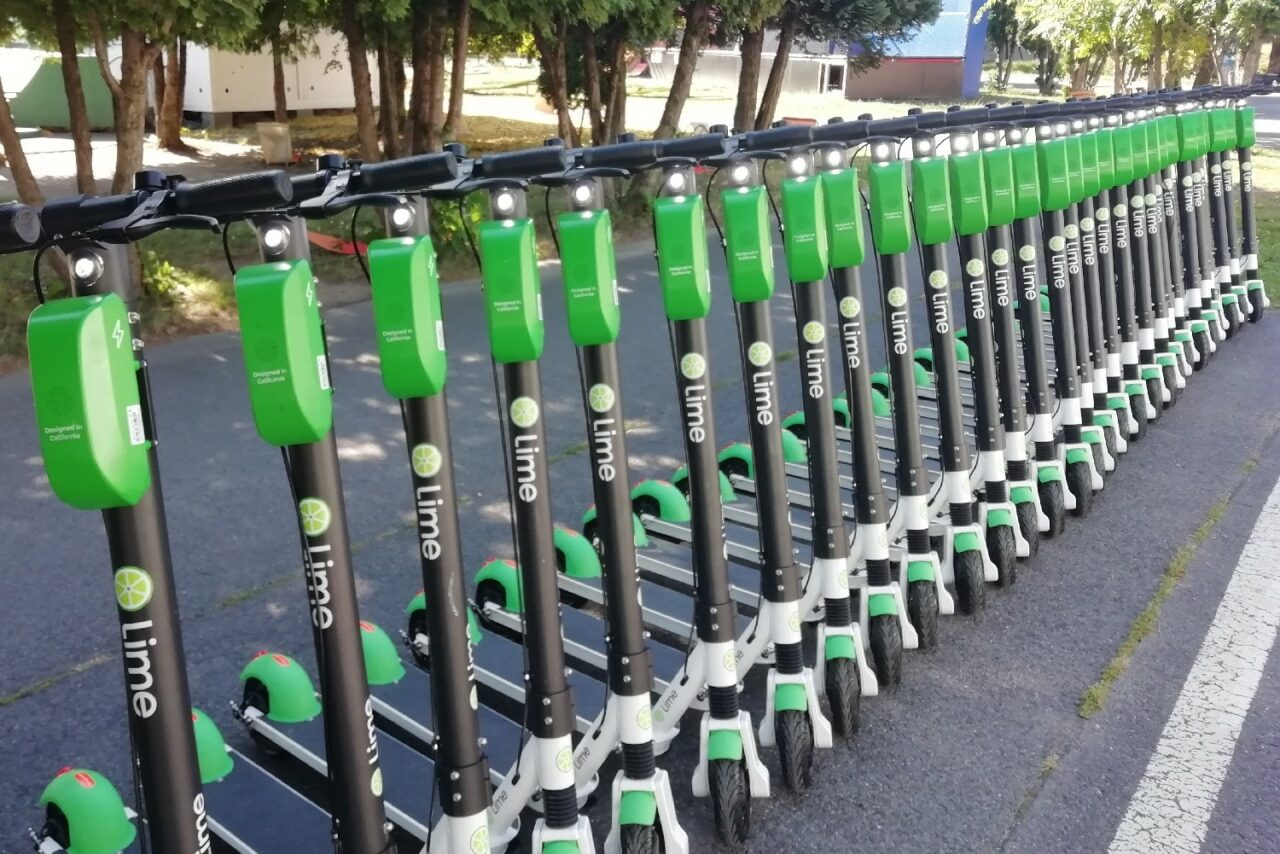
Sightseeing bus tours
If you want to check out all the famous sightseeing destinations Budapest has to offer, but you don’t want to use public transport or taxies, hop-on hop-off tours are the way to go. Check out our article on hop on-hop off tours for more info.
Table of content
Article meta data.
Airport transfer
Enjoy affordable luxury with our premium, airport transfer service..
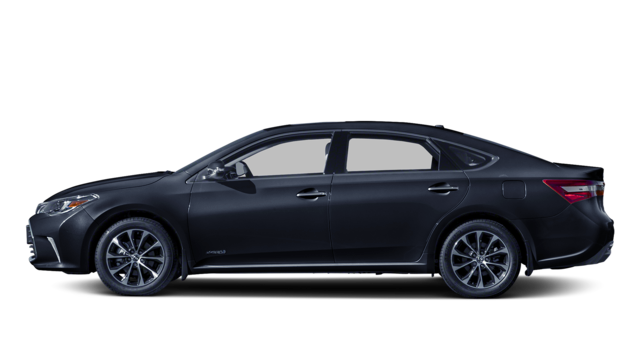
Premium Car | From 35€

Premium Van | From 45€
Related Articles

Budapest’s famous spa parties – where wellness and fun collide

Your ultimate itinerary to exploring Budapest in 1, 2 or 3 days
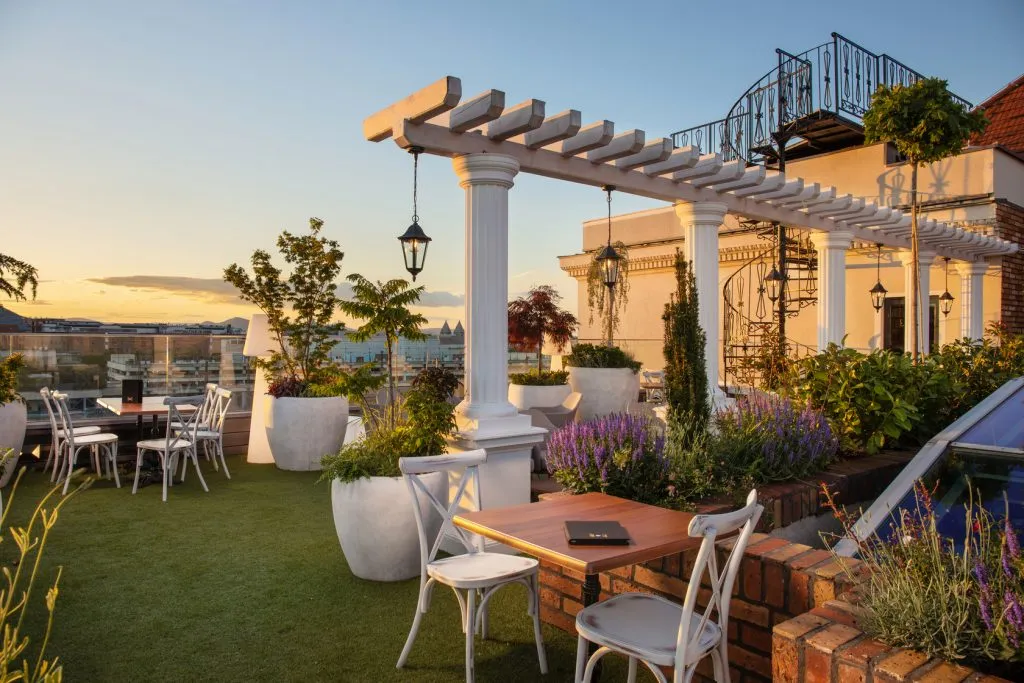
Drinks with a view – the best rooftop bars in Budapest

Budapest Airport Taxi

Hungarian Goulash – Enjoy The One and Only Soup!

Budapest Airport Parking
Watch budapest live.
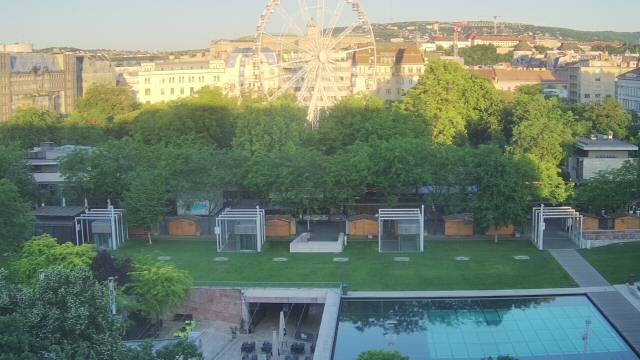
More interesting and useful tips
Parking Budapest – check out our article on this topic to avoid fines and find the best parking spots, even for free.
Your experience is important.
Anything you have not found, ask a question.
Please log in to write a review.
There is no review yet.

- Privacy Overview
- Strictly Necessary Cookies
- Analytics Cookies
- Advertisement Cookies
This website uses cookies so that we can provide you with the best user experience possible. Cookie information is stored in your browser and performs functions such as recognising you when you return to our website and helping our team to understand which sections of the website you find most interesting and useful.
Strictly Necessary Cookie should be enabled at all times so that we can save your preferences for cookie settings.
If you disable this cookie, we will not be able to save your preferences. This means that every time you visit this website you will need to enable or disable cookies again.
This website uses Google Analytics to collect anonymous information such as the number of visitors to the site, and the most popular pages.
Keeping this cookie enabled helps us to improve our website.
Please enable Strictly Necessary Cookies first so that we can save your preferences!
This website uses the following additional cookies:
(List the cookies that you are using on the website here.)

How to Buy Tram Tickets in Budapest: A Comprehensive Guide for Beginners
- 2024-03-07 2024-03-07
Introduction
Trams are a convenient and popular mode of transportation in Budapest, offering a scenic way to explore the city. Whether you’re a tourist or a new resident, understanding how to buy tram tickets is essential for a smooth and hassle-free journey. This guide will walk you through the process step by step, ensuring you have a pleasant tram experience in Budapest.
1. Ticket Types
Before diving into the purchasing process, let’s familiarize ourselves with the different ticket types available:
- Single Ticket: Valid for one uninterrupted journey, including transfers within 90 minutes.
- Block of 10 Tickets: Provides 10 single tickets at a discounted price, perfect for multiple journeys.
- 24-Hour Travel Card: Allows unlimited travel on trams, buses, and metros within Budapest for 24 hours from validation.
- 72-Hour Travel Card: Similar to the 24-hour card, but valid for 72 hours.
2. Buying Tickets
Now that you know the different ticket options, here’s how you can purchase them:
2.1 Ticket Vending Machines
One of the most straightforward ways to buy tram tickets is through the ticket vending machines, which are available at most tram stops. Follow these steps:
- Approach the ticket vending machine.
- Select your preferred language (English is usually available).
- Choose the desired ticket type.
- Insert the exact amount in cash or use a contactless payment method if available.
- Collect your ticket and any change if applicable.
2.2 Ticket Offices
If you prefer interacting with a person, you can buy tram tickets from ticket offices located at major transportation hubs, such as train stations and tourist information centers. Simply approach the counter, specify your ticket type, pay the required amount, and collect your ticket.
2.3 Mobile Apps
Alternatively, you can purchase tram tickets through mobile apps such as the Budapest Public Transport (BKK) app. Download the app, register an account, and follow the instructions to buy your desired ticket. Make sure to activate your ticket before boarding the tram and have it ready for inspection when required.
3. Ticket Validation
Now that you have your tram ticket, it’s crucial to validate it before boarding. Look for the small ticket validating machines located on trams or at tram stops. Insert your ticket, wait for it to be stamped with the date and time, and retrieve it. Remember, failure to validate your ticket may result in a fine if caught during inspections.
4. Additional Tips
Here are a few extra tips to enhance your tram ticket buying experience in Budapest:
- Keep small change or a contactless payment method handy for ticket vending machines.
- Always carry your ticket with you and be prepared to show it when requested by ticket inspectors.
- Double-check the expiry time and validity of your ticket to avoid unnecessary penalties.
- If you’re planning to use public transport frequently, consider purchasing a travel card for convenience and cost savings.
Buying tram tickets in Budapest doesn’t have to be overwhelming or confusing. With the information provided in this guide, you’re now equipped with the knowledge to purchase and use tram tickets with ease. Enjoy your tram rides and explore the beautiful city of Budapest conveniently and affordably!
Table of Contents
Related Posts
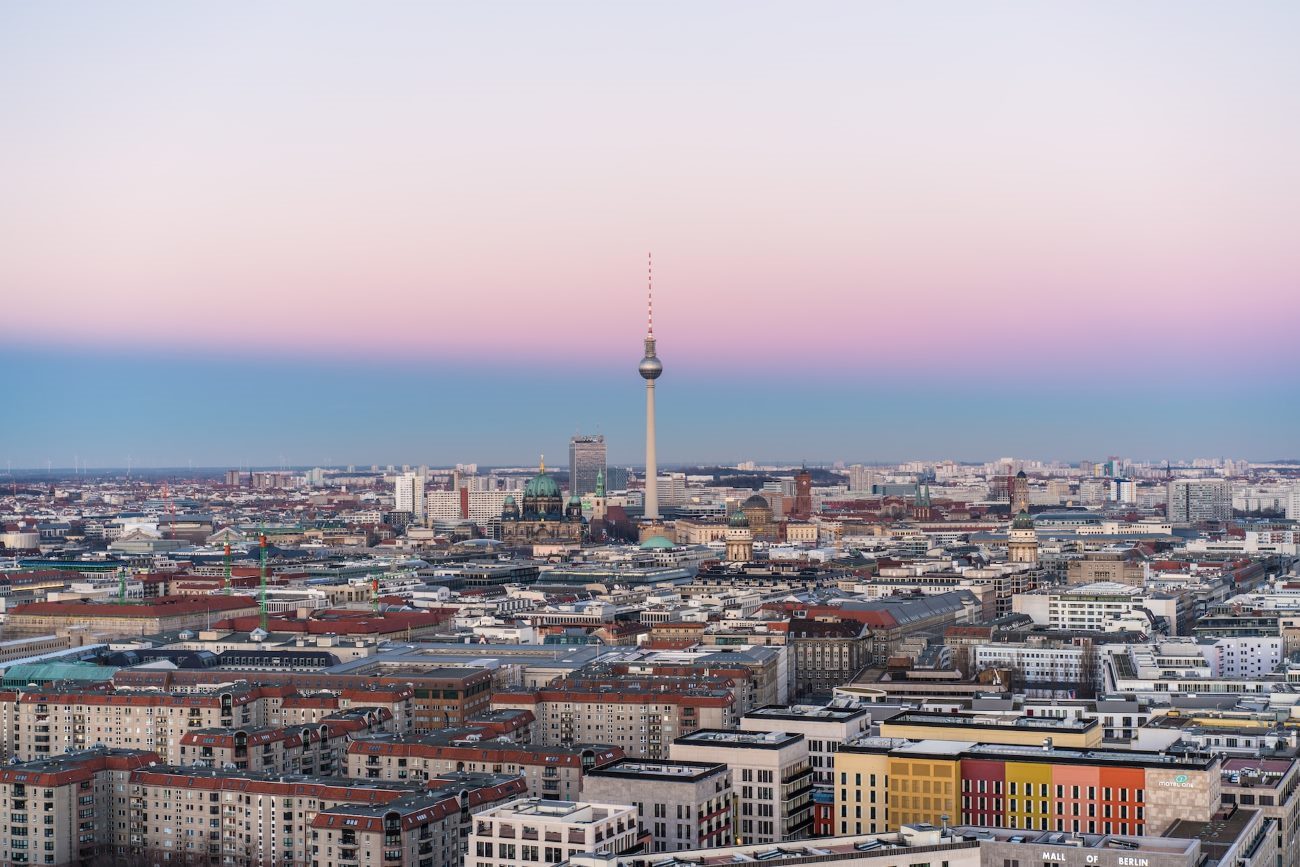
Duna Corso Budapest Sightseeing Boat: Explore the Beauty of Budapest from the Water
Budapest, the breathtaking capital of Hungary, is famous for its stunning architecture, rich history, and vibrant culture. One of the
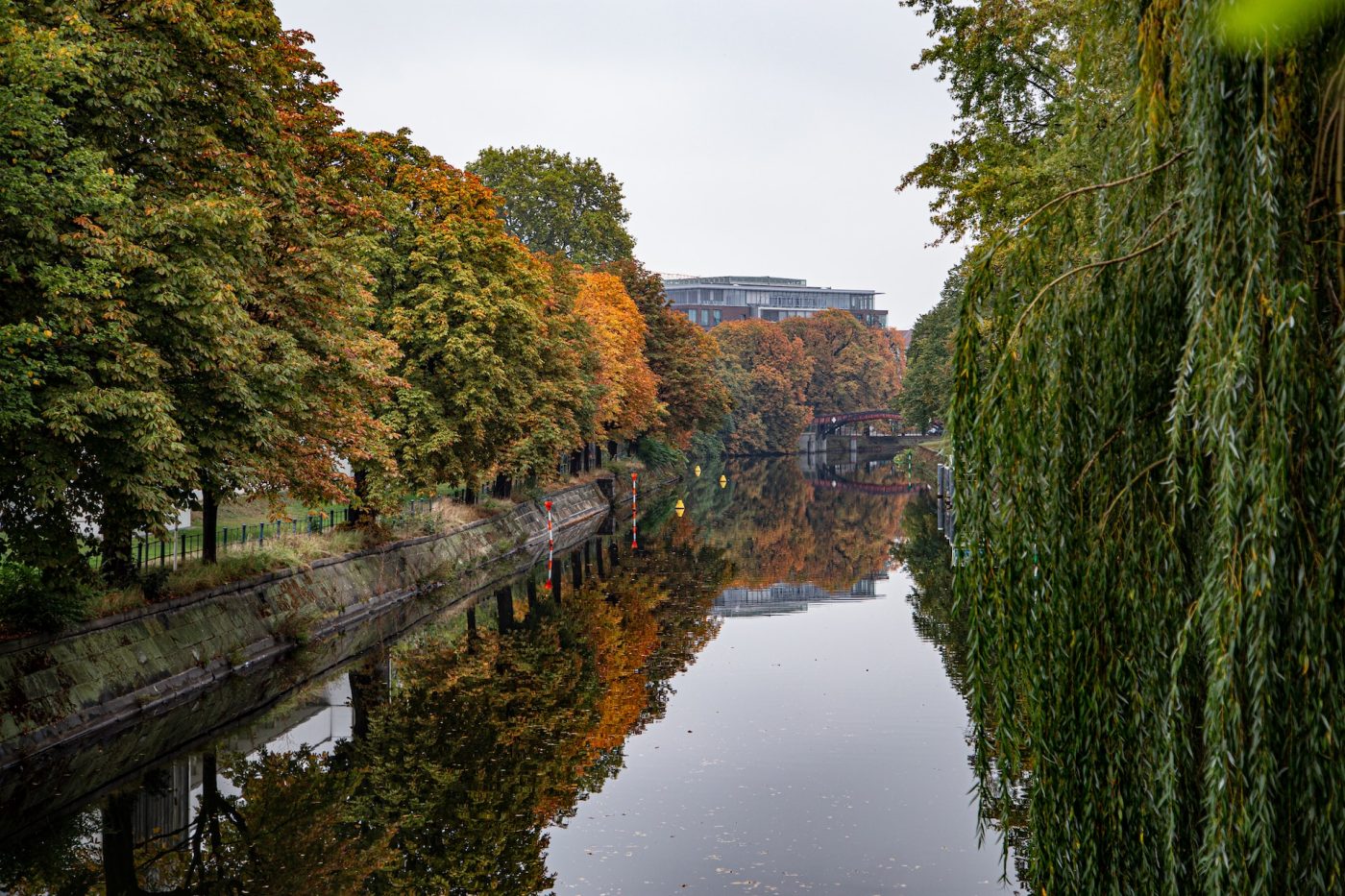
How Long Does it Take to Reach Sachsenhausen from Berlin?
If you are planning a trip to Berlin, Germany, you might be interested in exploring the nearby historical site of
Leave a Reply Cancel reply
Your email address will not be published. Required fields are marked *
Save my name, email, and website in this browser for the next time I comment.
Check out our other cities
Berlin tours.
- Original Berlin Tours
- Berlin Pub Crawl
- Pub Crawl Berlin
- Free Berlin Tours
- More Berlin Tours
- Cold War Tour Berlin
- World War Tour Berlin
- Sachsenhausen Tour
Barcelona Tours
- Free Barcelona Tours
- Barcelona Pub Crawl
- Pub Crawl Barcelona
Budapest Tours
- Free Budapest Tours
- Budapest Bar Crawl
- Pub Crawl Budapest
Madrid Tours
- Madrid Pub Crawl
- Pub Crawl Madrid
- Nice Pub Crawl
- Nice Bar Crawl
- Pub Crawl Nice
Amsterdam Tours
- Amsterdam Pub Crawl
- Bar Crawl Amsterdam
Paris Tours
- Pub Crawl Paris
Dublin Tours
- Pub Crawl Dublin
Warsaw Tours
- Pub Crawl Warsaw
Stockholm Tours
- Pub Crawl Stockholm
Other Links
- Original Pub Crawls
- Be Original Tours
- Original Free Tours
- E-Ticket Trail
Getting around Budapest, guide to public transportation
- Accommodation

Public transports in Budapest work very well and at affordable rates. Its metro system is the oldest in Europe after London, and its four lines cover all the main touristic attractions of the city.
Trams, buses, and taxis work very well; they are always on time, allowing you to reach any corner of the city.
In addiction, you can use Mol Bubi , a public bike-sharing system that allows you to move around Budapest in an ecological and fun way.
Budapest Card
Budapest card is a tourist city pass that allows you to move freely; you can choose between the 24, 48 or 72 hours pass and have unlimited access to all public transport rides, as well as some discounted rates for selected services and free entrance to selected museums.
By purchasing this card, you will be able to use free public transport rides . The card can be purchased at one of the many Budapest Infopoint or online before arriving to Budapest, so you won’t have to worry about it and you will also get a further discount. After purchasing the card, you will have to pick it up at the airport or at one of the many Infopoints .
The Budapest metro is made of 4 lines, numbered from 1 to 4 and identified by four colors. Line 4, the green line, is pretty new as it was completed in 2014. On the other hand, line 1 dates back to 1986 and it was declared World Heritage Site by UNESCO.
The Budapest metro system interchanges at Deák Ferenc tér, Keleti pályaudvar and Kálvin tér stations, which are all located in the city center.
Metro tickets can be purchased before boarding at vending machines or tobacconists; they must be validated before entering the rail area.
Tickets must be kept until the end of the ride; ticket inspectors can check their validity at any point of the station. There are four types of available tickets:
- Single Ticket : ordinary travel ticket valid for a single trip
- Section Ticket : cheaper than an ordinary ticket but valid for a trip up to 3 stops
- Transfer Ticket : single trip including one transfer
- Section Transfer Ticket : ticket valid for one line transfer as long as the whole ride is up to 5 stops
Budapest underground runs from 4.30 am to 23.10. During peak hours trains pass every 2 minutes.
Find more information about Budapest Metro.
In Budapest there are 200 buses lines running from early in the morning to late evening. At night they are replaced by late night lines. Buses are frequent and punctual; valid tickets are the same as underground tickets.
Tourists can easily get around Budapest by metro, without even having to use buses. However, bus 200E connects Ferenc Liszt Airport to the Kobanya Kispest stop, reaching the end of line 3. This is a cheap and easy way to get to the city center after landing to Budapest!
Tourist buses
In addiction to buses, public transport in Budapest includes also trams, which are recognizable by their yellow color. Trams in Budapest cover about 40 lines, some of which passing through the city center. You can use the same bus or metro ticket.
Tram number 2
One of the most interesting things to do on your trip to Budapest is experiencing a ride aboard tram 2 , which runs along the Danube and allows you to admire one of the main attractions of the city such as the Parliament, the Castle with the Fisherman’s Bastion, Matthias Church, the Chain Bridge, and the Elizabeth Bridge.
Taking a taxi in Budapest is cheap and very easy. A taxi ride will be more expensive than a metro or a bus ride, but being driven to your final destination may be worth the expense.
Unfortunately, taxi drivers in Budapest are famous for cheating on tourists . There are even some abusive taxi drivers that will take you to some remote area of the city just to rob you. In order to avoid being involved in such an unpleasant situation, you should always use official taxis.
Sometimes taxi drivers “forget” to turn on the taxi meter with the purpose of charging a way higher rate once you have reached your final destination. Ask them to turn it on straight away with a smile on your face and a calm attitude and you will have no problems.
Taxi fares are calculated by adding three entries:
- Basic fare : fixed fare, it increases at night time
- Per kilometer charge : it changes according to the distance traveled; it also increases at night
- Waiting fee : this third fare needs to be added to the previous two fares when taxis are stopped in traffic or traveling less than 15 k/h
Mol Bubi Bicycles
Another way to move around Budapest is to use the public bike system called Mol Bubi . Just like many other European capital cities, in Budapest there are many pick up and drop off points scattered all over the city. You do not need to be a resident citizen to use the service, and it is possible to pay by credit or debit card.
Bikes are recognizable by their light green color . Renting rates are very convenient. After paying a daily rate, or a 3 or 7 days rate, you need to pay per use.
The first thirty minutes are free, which means that you will only have to pay your daily fair if you are using the bike for short distances. Fairs increase as time passes.
In order to start using the service a 100 euro deposit will be charged on your credit card; it will be unlocked once it has been verified that the bike has been returned in good conditions.

Budapest Card: guide, review and comparison

Cruises on Danube in Budapest
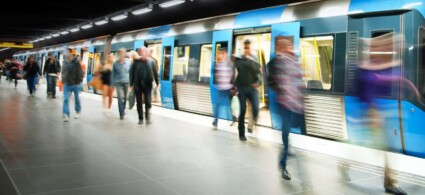
Budapest Metro

Biking in Budapest, tours and bike rental

Car hire in Budapest
How to save on transport and entrance fees.
City Card allow you to save on public transport and / or on the entrances to the main tourist attractions.

Top tips for getting around Budapest (on both sides of the river)

Mar 28, 2023 • 7 min read

Exploring Budapest on foot or by bike is like a free architecture tour © AzmanJaka / Getty Images
Thanks to plentiful buses, boats, trams and Metro trains, getting around Budapest is easy. The Hungarian capital is highly walkable, and for the times when you need to go further afield or get somewhere quickly, there are plenty of options.
Budapest Közlekedési Központ (BKK) runs the city’s transport network, which includes metro lines, trams, buses and even boats in the summer. BKK has a handy app for journey planning, so you can see when the next bus, tram, boat or metro is scheduled to arrive – it's particularly useful in winter, when temperatures regularly drop below -1°C (30°F).
Whatever time of year you come, here are the best ways to get around Budapest.
Pick up a travel card or transport pass for cheap journeys in Budapest
On Budapest public transport, you can buy a ticket for a single journey or buy a travel pass valid for anything from 24 hours to a month, covering all forms of public transportation run by BKK. Prices start at 2500 HUF for 24 hours. The Budapest Card also includes travel on public transport, as well as free entry to sights and attractions; it costs from €29 for 24 hours.
You can buy tickets for public transport from ticket offices in metro stations or at the purple self-service ticket machines at most metro, bus and tram stops. If you get a single ticket, make sure you validate it when you enter the metro station or get on board the bus or tram.
Keep the ticket with you until the end of the journey. Ticket inspectors tend to work undercover, dressed as normal passengers until the purple armband goes on, and there are steep fines if you don't have a valid ticket (the fine doubles if you can't pay on the spot). Other than when changing metro lines, tickets cannot be used for transfers.

Walking is the best way to see Budapest's gorgeous architecture
Walking is by far the best way to explore Budapest. It’s not the fastest way to get around the city, but it's certainly the most enjoyable. A walk through the backstreets of Budapest could lead to the discovery of your new favorite cafe, and every stroll feels like a spontaneous tour of beautiful Budapest architecture.
Budapest is a safe city to walk in, but be aware that bikes and pedestrians share the same paths on some sections of the Danube Banks, particularly in Buda, so watch out for cyclists.
Biking around Budapest is easy and inexpensive
Budapest is a very cycle-friendly city. You’ll find bike paths crisscrossing the center and winding through the outer districts, with the Danube-side cycle paths in Buda being some of the most popular routes for visitors.
It’s easy to rent a bike in Budapest; just look out for the green stations of the MOL Bubi bike-sharing scheme. You can rent bikes easily and cheaply using the app, with costs starting at 40 HUF per minute; when you’re done, simply return the bike to one of the many bike stations dotted around the city to stop the meter.
Zip around Budapest on the metro
The metro is the quickest way to get around Budapest, and it comes into its own during the frosty winter months. There are four metro lines, with Metro Line 1 (also known as the Yellow Line) being the oldest underground railway in continental Europe – and a Unesco World Heritage Site.
Metro line 1 runs from Vörösmarty tér to City Park, below Andrássy Avenue . Metro Line 2 (red) goes from Déli pályaudvar in Buda to Örs Vezér tér in Pest. Line 3 (blue) crosses Pest from north to south, but the line seems to be in a state of permanent construction, so you may need to get a replacement bus. The gleaming modern Line 4 (green) goes from Keleti train station to Kelenföld train station.

Budapest's trams offer great city views
The tram network covers most of downtown Pest and Buda and extends out into the suburbs. Trams are quick, easy to use and usually much faster than buses – and you also get to see some of this famously beautiful city as you travel, unlike riding the metro underground.
Tram 2 is one of the most beautiful tram routes in Europe, skirting the Danube banks on the Pest side of the river and rattling by the Hungarian Parliament with views of Castle Hill on the other side of the river. Trams 4 and 6 link Buda and Pest from Petőfi Bridge to Margit Bridge, crossing the Grand Boulevard in Pest.
Take the bus for good connections to the suburbs
Buses and electric trolleybuses cover the city all the way to the outer suburbs. The regular blue buses that run all over the city are a good option if you want to go up to the Buda Hills or the Castle District. Buses 16 and 16A bus will deliver you to the castle, while buses 21 and 21A go to Normafa – the highest part of the city, popular for its parks and hiking trails. On the Pest side, red trolleybuses link downtown with neighborhoods beyond the Grand Boulevard.
Suburban trains are great for day trips from Budapest
The suburban train network known as HÉV (Helyiérdekű Vasút) is great for day-trippers looking to visit the fascinating small towns just outside of Budapest, such as Szentendre , a picturesque town that was once home to a substantial Serbian community and thriving art colony.
The easiest way to get to Szentendre is to take HÉV H5, which runs from downtown Buda. Other useful lines for travelers include the HÉV H8, which runs to Gödöllő – home to the elegant Baroque Gödöllő Royal Palace – and the HÉV H7 going south to Csepel Island.

Summertime boats run along the Danube
In the summer months, BKK runs a special boat service along the Danube, connecting various stops on the riverbanks. The ferry can get you to some of the city’s most prominent landmarks , including the Castle Garden Bazaar , the Hungarian Parliament and Margaret Island .
The boat is not the fastest way to travel, but if you want a city tour on a budget, it’s worth the 750 HUF ticket price to enjoy the city from the water. Additionally, shorter ferry trips cost 170 HUF for a single ticket. Check that the service is running before heading to the riverbanks because it can be erratic.
Ride-sharing apps are handy for late-night rides
If you need to get back to your hotel late at night and prefer to avoid the gamble of taking a cab on the street, download the Bolt app (formerly known as Taxify). It works the same way as Uber (which no longer operates in Hungary), and you can get a ride in a matter of minutes in most parts of the city.
Use reputable taxi firms to get around Budapest at night
Conventional taxis are commonplace in Budapest, but it’s best to use a reputable taxi firm such as City Taxi , Főtaxi , 6x6 Taxi or TaxiPlus . Don’t flag down a cab on the street because there are some unsavory taxi drivers – although there are fewer of these characters nowadays than there were in the past. You can easily order a cab by phone or via the companies' apps, or most restaurants and hotels will happily order a cab for you.
A rental car is only really useful for day trips out of Budapest
It’s not really worth renting a car in Budapest unless you plan to take long-distance day trips out of the city. Big international rental-car companies, such as Hertz and Avis, have offices in some large hotels and at the airport.
Accessible transportation in Budapest
Accessible transportation in Budapest has improved in recent years, but there’s still a long way to go. Metro Line 4 is wheelchair-accessible across the entire route, but the older metro lines only have a few stops with elevators and wheelchair access.
Tram lines 4 and 6 are step-free and accessible for wheelchairs, but many other tram lines have quite a few steps between the street and the tram. Travelers in wheelchairs can use most buses, and drivers will lower the bus and extend a ramp. HÉV trains are old and have steep steps that are challenging even for those without mobility issues.
The BKK website has a guide to accessibility on Budapest’s public transport . For more information on accessible travel, see Lonely Planet's accessible travel resources .
This article was first published Dec 23, 2021 and updated Mar 28, 2023.
Explore related stories

Tips & Advice
Jun 12, 2024 • 12 min read
There is simply no way to tour Europe and not be awestruck by its natural beauty, epic history and dazzling artistic and culinary diversity.

May 3, 2024 • 5 min read

Mar 17, 2024 • 7 min read

Mar 6, 2024 • 8 min read

Oct 19, 2023 • 8 min read

May 23, 2023 • 6 min read
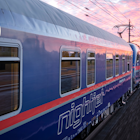
Apr 20, 2023 • 6 min read

Apr 6, 2023 • 7 min read

Apr 4, 2023 • 6 min read

Jan 24, 2023 • 7 min read
How To Use The Public Transportation In Budapest? (Tickets & Fares)
Published by veronika on june 9, 2018.
Most of the main sights in Budapest are easily accessible on foot. But if you are tight on time or you feel that you have already walked enough for the day, our capital also has an excellent public transportation system with four metro lines and an extensive network of trams and buses. So it is really easy to get around! Here is a little guide on how to use the public transportation in Budapest.
In Budapest travel like the locals do!
What types of tickets are available and how much do they cost?
You can either buy single tickets or have a travel card valid for a longer period of time.
A s ingle ticket costs 350 HUF (about 1.2 euros, 450 HUF if bought from the driver on some lines) and is valid for one ride after validation. Each time you board a new vehicle you need to validate a new ticket. Transfers with the same ticket are only allowed on the metro lines. Apart from the metro, transferring between lines (eg. from a tram to a tram, a tram to a bus, a bus to a bus etc.) requires a new single ticket. You can save a little by buying 10 single tickets in a block for 3000 HUF.
On the other hand, travel cards are valid for a longer period of time from the date and time indicated on them. They are valid for an unlimited number of rides and you do not need to worry about validation every time you board a new vehicle. The simple day pass is worth it if you would use the public transportation at least five times within 24 hours. The table below shows the prices for the most common travel card types. Here you can find a more detailed list of tickets and fares.
Trams on the Great Boulevard run all night long.
Where to buy tickets and travel cards?
At the airport – The Budapest Public Transportation Center (BKK) has a Customer Service Point on both Terminal 2A and Terminal 2B of the Liszt Ferenc International Airport. Open from 8 a.m. (2A) / 9 a.m. (2B) until 10 p.m. (both terminals). There are also vending machines if you arrive too late or too early. They accept bank cards, so don’t bother with changing money . All ticket types are available. ( Here you can read more on transportation to and from the airport.)
At major transportation hubs – BKK has Customer Centers at transportation hubs like Deák tér, Ferenciek tere, Blaha Lujza tér, Keleti Railway Station etc. and smaller ticket selling points at bigger stops. All ticket types are available.
To buy your tickets look for these purple machines.
Ticket Vending Machines – These purple machines can be found at the busier bus and tram stops and all metro stations. They work with Hungarian Forints or credit cards, but sometimes only one of the two options is available. You can choose from several languages, among them English, Spanish, German or French. All ticket types are available.
On the vehicles themselves – On certain buses and trams in the city center you can buy single tickets from the drivers. They are a tiny bit more expensive than the ones bought in advance (450 HUF instead of 350 HUF), and you can only pay with Hungarian Forints. Try to have the exact amount, they usually can’t brake up big banknotes. Communication in English can be challenging sometimes. Only single tickets are available.
Retailers – Some hotels and small kiosks at the metro stops sell single tickets. Only single tickets are available.
Your travel pass is valid even on the Danube, but only on weekdays.
Validity of tickets
Single tickets and travel cards are valid within the administrative boundaries of Budapest for all metro, bus, trolleybus and tram services. They are also valid for the cog-wheel railway (also known as tram 60) and for stops of the suburban railway within Budapest. Outside of Budapest (eg. going to Szentendre) you need an extension ticket for the suburban railway. However, normal tickets and travel cards cannot be used on the Buda Castle Funicular, the Chairlift in the Buda Hills, and bus 100E (which is a direct bus line from the city center to the airport).
On the boats run by the public transportation company you can use your passes on workdays , but the normal single ticket is not valid. On the weekend and national holidays everybody must buy a boat ticket that costs 750 forints, none of the passes are valid.
A single ticket is valid for one ride on buses, trams, and trolleybuses. Transfer with the same single ticket is only possible between two metro lines. Otherwise, you need to validate a new ticket every time you transfer from one vehicle to another.
Travel cards are valid for an unlimited number of rides within Budapest during the period indicated on them. The validity period starts either at the time of purchase or on any date and time in the future.
For the 100E airport bus you need a special ticket
How to validate a single ticket?
On buses, trams, and trolleybuses you can find orange or red validation machines on the vehicles themselves . Insert the ticket into the machine with the numbered side first and facing upwards. The machine stamps your ticket automatically. On some trams, you will find red machines instead of the orange ones. Those old-school machines work manually. Insert the ticket at the top of the machine (the numbered side first and facing you). Then pull the black part of the machine with the ticket inside towards yourself and it punches a hole in the ticket.
In case of the metro, you will find the orange machines at each metro entrance. Remember to validate a new single ticket every time you board a bus, a tram, or a trolleybus or whenever you enter the area of the metro.
Insert your ticket with the numbered part first facing upwards.
What happens if I do not have a valid ticket?
In Budapest, you will not find gates that only let you through with a valid ticket. However, ticket inspectors can ask for your tickets on the whole territory of the transportation network. If you have a valid ticket, the chances are high that you will never encounter them. But if you forget to validate, you can be sure that they will appear out of nowhere. The penalty fee is 8000 HUF on the spot , so you had better validate your single tickets. Or buy a travel card and then you do not have to worry about validation.
The lower station of the Buda hills chairlift – you can buy your ticket in the building from a machine
How do I find my way around?
The Budapest Public Transportation Center has a mobile app called BKK Futár (for Android and iOS ). Use it to get from A to B if you have data on your phone. It is easy to set the language to English, just look for the Settings sign (“Beállítások”) at the bottom of the menu and choose the first option for Languages (“Nyelv”) . Google Maps also has useful and up-to-date information on timetables and routes.
Now you are all set to hit the streets in Budapest! With public transportation, you can cover more if you have limited time in our capital. It can also make our Budapest101 walking tours more efficient – and more fun! Besides the ordinary vehicles, Budapest also offers some unique means of transportation as well. Learn more about them on a Budapest101 transportation tour .
Veronika is a guide and tour organiser of Budapest 101
Related Posts
Architecture, the budapest 10-year challenge.
For us Budapest is like a timeless lady who mixes fun and elegance. And like a good wine, it improves with age! So we decided to look back on the last decade and see how Read more
5+1 Unique Ways of Transport in Budapest
With its excellent public transportation system, it is really easy to get around in Budapest! But besides the ordinary buses and trams, you can find some unique or historical means of transportation as well. Here Read more
How to Survive the Budapest Airport – The Ultimate Guide
Okay, you landed in Budapest, and now what? We are here to help! In this post we’ll tell you how the locals do it and make you a Budapest Airport pro. You’ll learn where to change Read more
A fantastic tram-ride in Budapest

You can buy tickets to hop-on-hop-off buses in Budapest. You can pay a private guide to show you around. Or, you can buy a single ticket for the public transportation and enjoy a ride with tram 2 in Budapest.

Let us get started right away. The best way to start the tour is by heading for the Margaret Bridge. The bridge is located a bit north of the Hungarian Parliament. You can, of course, start by jumping on the tram from the Rakoczi Bridge (or the Petöfi Bridge, or the Liberty bridge instead), but as you join us on this trip, we will start from the Margaret Bridge (name of the stop is Jaszai Mari tér).
Let’s get started with the panoramic tram ride in Budapest
As you board tram line 2 in Budapest, do not forget to validate your ticket first. The people inspecting tickets are not known to be tourist-friendly. As a consequence, lots of people have ended up paying unnecessary fines, even if they didn’t intend to do anything wrong at all. Again, validate your ticket. You can not buy a ticket on the tram, so you need to bring a ticket with you (you can buy from vending machines, from small kiosks, and in all metro stations).

You do not need to travel for a long time with tram 2 before you see this magnificent building ahead of you! The Hungarian Parliament is the building, and it is one of the most beautiful of them all in Budapest.

Depending on who tells you about the building, you will hear that it was constructed sometime between 1884 and 1903, and it was designed by Imre Steindl. It is very inspired by the British Parliament building, but it ended up even nicer than its source of inspiration!
There has been a lot of construction work on the Hungarian Parliament building , but it is now mostly finished. As a result, it is shining on all sides (earlier it has been almost black due to dirt). The building is fantastic all times of the day, but it is at its most amazing after sunset with the big lights turned on!
As the tram drives next to the Parliament you will see two other beautiful buildings. These were all part of a design competition at the end of the 19th century, but they both lost the competition to the present Parliament building. Instead of throwing away the drawings, they decided to build both the buildings as well. The first building you see is the home of the Ethnographic museum while the second building belongs to the Ministry of Agriculture.

Once you leave the Parliament and the other buildings behind you, the tram will take you along the River Danube again. You will be met by a stunning view in all directions as the tram moves on towards the Chain Bridge, the most famous of all bridges in Budapest. But, before we pass by the Chain Bridge, let us take a look across the Danube to enjoy the view of several beauties.
A nice Danube Panorama to the right
As we look to the right we will see four different structures that should be highlighted. Take a look at the picture beneath to see which those buildings are.

Down by the Danube on the Buda side you can see the Szilágyi Dezső Square Reformed Church . It was built between 1893 and 1895, and it is well known for its special shape, and the beautiful Zsolnay tiles on the roof.
As you look further up you can see three interesting structures next to one another. The one marked as number two on the picture is the Fishermen’s Bastion . This was built at the start of the 20th century, designed by the Miklos Ybl. While working on the Fishermen’s Bastion , he was also leading the work of renovating the Matthias Church (number 3), a church that was originally built in the 13th century. This church is the favorite church of many who visit Budapest, not only because of its interior, but because of the fantastic Zsolnay tiles on the roof, and that you can visit the tower and enjoy one of the best views in Budapest from the top.

Number four on the picture is the Hilton Hotel. This is a debated building, as many feel as if it shouldn’t be there. It is, however, a very special building due to the fact that it was constructed onto the remains of a Dominican monastery from the 15th century. As you enter the hotel, you can still see the ruins of the original building, making this one of the most special Hilton hotels in the world.
The beautiful Chain Bridge and the Castle
The tram ride from the Parliament to the Chain Bridge doesn’t take more than 1-2 minutes, so you will not have a long time to study the buildings we have just described. Soon you will get into a little tunnel taking you to the other side of the Chain Bridge . But, do not forget to take a closer look at the bridge before you drive beneath it. This was the first permanent bridge constructed between Buda and Pest . It was finished in 1849, and it has been one of the most famous landmarks in Budapest ever since. It was destroyed in 1945 (Second World War), but was quickly fixed and was ready for use again in 1949.
Now it is time to look to the Buda side again. On the top of the hill on the other side, you can see the Buda Castle . It was originally constructed in the 13th century. It has served several kings and flourished especially during the reign of King Matthias in the 15th century. During the Second World War, it was heavily damaged, but most of the damages were fixed during the Communist reign. Today the Castle is the home of the National Gallery, Budapest Historical Museum , and the National Library. In addition, it is a very popular venue for festivals and other popular events.
The Elisabeth Bridge and the Gellert Hill
In front of us, we can now see a white bridge, better known as the Elisabeth bridge . It was originally constructed in 1903, and it was the largest suspension bridge in the world as it was finished. Just like the Chain Bridge, it was destroyed during the Second World War. The citizens of Budapest had to wait for more than 20 years for this bridge to be reconstructed.
On the Buda side of the bridge, we can see a statue portraying Bishop Gellert . He was on his way to Jerusalem as a pilgrim in the 11th century, when Hungary’s first king (Stephan), convinced him to stay. Gellert stayed in Hungary, but after the death of King Stephen, he was taken captive by rebellions trying to get rid of Christianity, and he was thrown down the hill in a barrel (and died).
On the top of the hill, you can see the Citadel and the liberty statue . This hill has been used for thousands of years, but the citadel (fortress) was built between 1850-1854. The statue portraying a lady with a palm branch in her hands was built after the Second World War in honor of the Communist soldiers who liberated Budapest (the construction was ordered by the Soviets, so the Hungarian didn’t have the chance of saying no to the job). The Gellert Hill is maybe the nicest place in Budapest if you want to take stunning panorama shots of the city, both during daytime and by night.

You will now quickly reach the green bridge, the Liberty Bridge . This was the third bridge built between Buda and Pest and it was finished by the end of the 19th century. Since the tram will drive into a tunnel to get beneath the bridge you cannot actually see the building, but on the Pest side next to the tram line, you can now find the famous Market Hall, a must-see place while in Budapest.

As the tram moves on, you can see the Gellert hotel on the Buda side, and almost next to it, the Technical University . But, just as interesting is the building on the Pest side built in the shape of a whale. This is often referred to by locals as the whale ( Bálna ), and it is a cultural center with some nice shops, and several restaurants and bars. It is a nice place to sit down and have something to eat and drink while enjoying the view of the Danube and the city.

The end of the tram ride is approaching, but there are still a few more things worth noticing. First, we will pass beneath the Petőfi bridge (named after a famous Hungarian poet who lived in the 19th century). On the Pest side, you can now see a whole lot of newly built buildings. It is a modern area with new flats and quite a lot of offices. But, do not be fooled, and do not leave the tram yet. You will soon reach the final stop, and Budapest has some goodies left for you, just take a look at the picture.

As the tram ride ends, you will end up next to the Palace of Arts (to the right) and the National Theater (to the left). These are some magnificent buildings that were built quite recently (between 2000 and 2005). They are extraordinary buildings, but most people would say that they are most impressive by night, just look at the picture above again.
Now that the tram ride has ended
The tram ride has now ended, and you have just enjoyed a very cheap panoramic tour of Budapest. But, you are far away from the city center by now, so you should probably just remain on the tram and enjoy the ride back to the city center. You will then have one more chance to pick up on those attractions you didn’t really have the time to see during the first ride.
Do not forget that this is a ride you should do both during daytime and nighttime. As you can see, lots of the pictures are portraying Budapest by night, and the city is even more beautiful then. If you want to save even more money, you could do this tram ride instead of a River Cruise on the Danube . Most cruises travel between the Margaret Bridge (where the tram ride started) and the Rakoczi Bridge (where the tram trip ended), so you will see exactly the same. It might be better and easier to spot everything from the Danube, but if you are on a budget, this is a fantastic tram ride that will let you discover Budapest on your own without spending more than 1 Euro.
Doesn’t this sound like a treat when you come to Budapest? Have you tried it? Have you got any questions? We would love to hear your comments, thoughts, and questions.
4 thoughts on “ A fantastic tram-ride in Budapest ”
We plan visiting Budapest in end July. The Tram 2 ride is very concise and informative.
Magnificent view
We plan to visit Budapest in mid August 2019. This info will help us to plan. Surely we want to ride Tram 2. Any idea on ticket cost for a return journey ?
The tram ticket costs 350 HUF per way… 🙂 You need to validate the ticket on board.
Leave a Reply Cancel reply

Getting Around Budapest: The Essential Guide For Navigating Hungary’s Capital
B udapest is known as the “pearl of the Danube” because it’s divided into 2 areas – Buda and Pest- each one on a different side of the Danube. While we think this makes Budapest SO beautiful, we also found that it makes navigating around a *little* more tricky.
After living in Budapest and getting around the city using ALL the ways, Caleb and I have narrowed down the 5 best ways to get around Budapest and, to take it a step further, which method of transport is the best for getting to each of the main attractions. Spoiler alert: your feet are the best, followed by the tram!
We’re laying it all out for you in this guide so that getting around Budapest is simple, easy, and stress-free. whether you’re only there for a few short days or longer. Let’s dive in, starting with a sneak peek of the beautiful #2 tram ride!
The Best Way To Get Around Budapest As a Visitor
These are the 5 methods of transportation we recommend and what attractions to use them to see. You can click each option to jump to our detailed guide on that topic!
1️⃣ Walking – best for basically everything
2️⃣ Trams – getting around the pest side/seeing Parliament/Margaret Island
3️⃣ Buses – getting to Buda Castle/fisherman’s Bastion
4️⃣ Metro – Getting to hero’s square or Széchenyi Baths.
5️⃣ Taxi/Rideshare – getting anywhere when you’re short on time and don’t mind spending.
The easiest way to get around is walking.
Use this method: to get pretty much anywhere except * maybe * Heroes Square and Szechenyi Baths.
Yes, Budapest is a *little* spread out between the Buda and Pest sides, and that pesky, very large Danube river makes crossing between both a little more time-consuming on foot, but you get incredible views of the river if you take the time to walk across them!
Get Our Best Travel Tips
We won’t send you any spam & unsubscribe at any time!
Walking is truly the best way to get around Budapest and see all its beauty! We racked up 40k steps some days and weren’t mad about it.
We mean, If you’re walking from Buda to Pest, it’s likely only going to be 30-40 minutes, which means more calories burned to refill with creamy chicken paprikash and Hungarian white wine, you know? 🍷
READ NEXT: Budapest district guide to see the main, walkable attractions in each district.
The trams are a scenic way to get around without traffic.
Use this method: to get around the pest side and visit Parliament or Margaret Island.
Trams are our second pick because they offer the convenience of wheels but without the traffic of other cars on the road, like a bus, making them faster. Plus, you’ve got lots of options with about 40 lines to choose from.
We also really like trams vs buses because they can also be pretty scenic and romantic, like our favorite ride on the #2 tram. Great for couples like us!
The tram line you’ll likely want to use is the #2.
According to National Geographic , this is one of the best tram rides in the world, and we agree. When we rode it, we walked to Margaret Bridge on the pest side (you’ll see the tram stop right at the entrance to the bridge), then we took it all the way to Zsil Utca station. Then walk along the water back because it’s a super nice romantic stroll.
This route will let you see Buda Castle from the other side of the river, the Chain Bridge, Margaret Bridge, and Parliament.
But you could also take it all the way to Fővám tér if you want to add a peep at the Liberty Bridge or Grand Market hall. You could also hop on it right at parliament buildings (stop at Országház Látogatóközpont) if you don’t care about Margaret Bridge.
The bus system is the best way to cross the Danube.
Use this method: to get from Pest to Buda Castle if you don’t want to walk! Or to and from the airport.
The bus system is our third pick because it lets you see Budapest’s beauty, but it can take more time because of traffic.
To use it to get to Buda Castle, we recommend taking Bus #16 , which goes from Deak Ferenc Ter to the Disz ter, where you’ll get off and head to Buda Castle.
Below is a photo of the *usual* timetable for this route for easy reference:
We also recommend taking the bus from the airport to the city center to save some cash. We found it super punctual, too! The best option is to get the 100E right from the airport – it’s right outside the arrival area, and it’s only about $6 USD per person!
Don’t worry about buying a ticket anywhere for that. You can just pay by tap with your credit card onboard. However, we each had to have our own credit card; we could not share a credit card if we used the tap method.
The metro is fast but less scenic than above-ground options.
Use this method: to get to Heros Square or Széchenyi Baths.
The metro is fast, but, as a tourist, we recommend you prioritize the tram or bus if needed so you can actually see the beauty of Budapest, not just stare at concrete walls whizzing past you.
Having said that, we find it the most convenient way to get to the Heros Square or Széchenyi Baths. Just take the M1 from Deak Ferenc Ter in the city center and get off at Hosok Tere for Hero’s Square or Szechenyi Furdo for the baths.
Buying Tickets For Public Transport
You can buy tickets that work on the bus, tram, or metro, and you can get them from any of the purple ticket dispensers at the tram stops or at the ticket counters in the metro. There are some at a few bus stops, but only the main “touristy” stops.
You can get them from drivers, but we always felt we were annoying them, and they never had change. Using the ticket dispensers is easier because they take credit cards.
Once you buy your ticket, MAKE SURE to validate it by scanning the barcode on the bus/tram doors or at the driver’s area. If you’re at the metro, the validation box is at the top of the escalator before going down to the platform.
Honorable Mention: Taxis For When you’re short on time & don’t mind spending $$
You could also use a taxi to get to any of the main sites in Budapest. Just know that this is the most expensive option , and it’s not always the fastest because you might get stuck in traffic. Licensed cabs are yellow, and the prices are regulated across Budapest , so you won’t get ripped off.
Is there Uber in Budapest?
Yes, as of June 2024, Uber is back in Budapest! Except, just like Bolt, Uber is the same as original taxis and all have the same fares.
Insider Tips For Using Public Transportation in Budapest
- Our top tip is to snag the Budapest Card. This is a card, especially for tourists with multiple time frame options like 1 day, 2 days, 3 days, etc, and you get unlimited access to public transport! Bonus: It gives you other discounts on attractions around the city!
Here is a description of the whole shebang that the card covers.
You can get them online here, at the airport, or at any of the info points around the city.
2. Know about single journey tickets . In most cases, if you are purchasing single tickets (not the Budapest card), it’s one ticket per passenger per ride. So, if you have to transfer buses or trams at any point, you need a new ticket.
The metro is an exception to this. You can keep transferring until you exit the metro at your final point.
3. Always keep your tickets handy . until you’re done riding any form of transportation so you don’t get stuck in a spot check with your pants down.
Eeerr…without your ticket in hand? 😅
4. Get the “Budapest Go” app. This app allows you to plan your journey , buy tickets, and even pre-buy your ticket for the airport bus. It’ll save you a lot of time and stress!
Download it here.
5. When in doubt, use Google Maps . The public transportation option never failed us, so that’s a good way to know which option to take and which line to take!
6. If you’re going somewhere during rush hour, try your absolute best to walk. Otherwise, it will likely take you longer than you think because you’ll get stuck in traffic OR be squished into a crowded bus or tram!
Here is a link to the Budapest public transportation guide if you have any other questions!
Voila! That about covers in our guide to the best ways to travel around Budapest for first-timers. Of course, there are other options like Lime Scooter or bike, but, honestly, those have some safety risks, and we don’t recommend them! If you have any questions, just leave us a comment and let us know!
Now that you know how to get around, you have to know where to stay to make the most of your time. We wrote a beginner’s guide to the 3 best districts to stay in Budapest for first-timers to help you out!

This website uses cookies to improve your browsing experience and analyze the use of the website. Learn More

Budapest Metro + Public Transportation

The city of Budapest has a rather extensive and useful public transit system known as BKK which includes the metro, tram, trolleys, buses, and even suburban trains (known as HEV lines).
This post will help you navigate each of the public transportation services in Budapest in addition to offering advice for saving money on tickets.
- Tickets & Offers
- Boats & Funiculars
- MOL Bubi Public Bikes
TICKETS AND DEALS
There are a few different ways to pay for admission to public transit in Budapest, and each option is valid on all vehicles including the metro, trams, trolleys, buses, and HEV trains.
The main method is simply to purchase a single ticket, which is good for one uninterrupted trip.
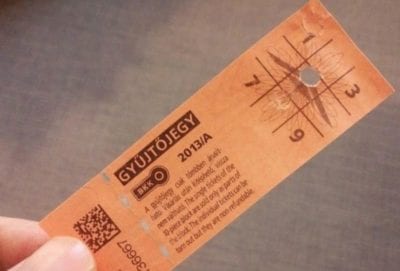
There are also transfer tickets you can buy which allow you to move from one mode of transport to another.
There are several additional ticket options to choose from including metro section tickets and blocks of 10 tickets, but these are intended more for locals than travelers.
- Single Ticket: €1 (€1.25 if purchased onboard)
- Single Transfer Ticket: €1.50
- Metro Section Ticket: €0.85
- Block of 10 Tickets: €8.50
Learn more about these ticket types .
Alternatively, you could save avoid the potential hassle of figuring out the # and type of tickets you need and by purchasing a travel card instead.
There are 3 different versions of travel cards available in Budapest: 24-hour, 72-hour, and 7-day.
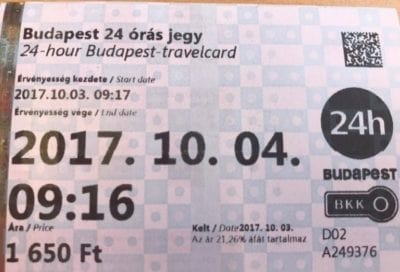
The 24-hour card can be purchased either for individual riders or for groups of up to 5 people.
The 72-hour and 7-day cards are only available for individual riders.
Each travel card is valid on all public transport network vehicles, so you won’t need any other tickets to climb on board.
These cards become valid the moment you purchase them, so we recommend that you don’t pick one up until you need it.
In other words, if you get the pass at 9 pm, it will only be valid until 9 pm the next day.
- 24-Hour Travel Card: €4.65
- Valid for up to 5 people (€1.87 per person)
- Price per day: €3.92
- Price per day: €2
How do I pay for public transport in Budapest?
Tickets and passes can be purchased either at ticket vending machines or newspaper kiosks.
Most ticket offices have closed down in favor of the ticket vending machine, but occasionally you’ll find one at metro stations in the city.

You can also purchase tickets onboard buses for an additional fee.
Ticket inspectors randomly come aboard to check and make sure everyone has paid their fare, with fines up to €45, so be sure to validate your tickets.
Another option is to purchase a tourist pass known as the Budapest Card .
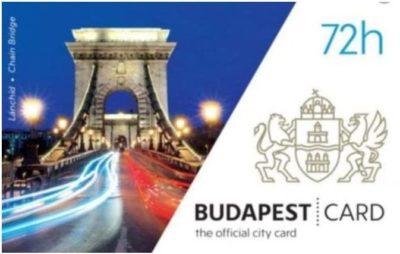
This service provides free public transport for the amount of time it is valid (1-5 days).
- 1-Day Budapest Card: €21.99
- Price per day: €16.49
- Price per day: €14.33
- Price per day: €13.25
- Price per day: €12.60
At first glance, the tourist pass may look a bit more expensive, but when you consider the fact that it also includes admission to dozens of popular attractions for free , the price makes more sense.
Additionally, you can also save up to 50% off many popular tours, landmarks, museums, amusement parks, and more.
Depending on how you use this concession pass, you could potentially save more money on public transport by using a Budapest Card instead of a travel card.
Another nice thing about this tourist pass is that it only becomes valid when you activate it, so you can purchase it ahead of time.
For more details on this service, please read our post covering Budapest tourist passes .
BUDAPEST METRO
There are currently 4 metro lines in Budapest that provide service to the city centre and some of the outskirts of the city.
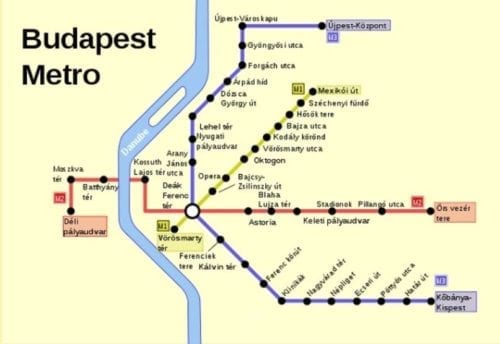
There are several stops that would be of interest to travelers and tourists.
Line 1 | Yellow Line
- Runs from Vörösmarty tér to Mexikói út.
- Includes stops at the Hungarian State Opera House, Heroes Square, City Park, and the Chain Bridge.
Line 2 | Red Line
- Runs from Buda’s Déli Pályaudvar to Pest’s Örs vezér Square.
- Includes stops at the Hungarian Parliament, Kossuth Square, Batthyány Square, and the Great Synagogue.
Line 3 | Blue Line
- Runs from Újpest városközpont to Kőbánya, Kispest.
- Includes a stop at the Great Market Hall, St. Stephen’s Cathedral, the Hungarian National Museum, and more.
- Connects with bus 200E (airport transfer).
Line 4 | Green Line
- Runs from Keleti Train Station to Kelenföld Train Station.
- Includes stops at Bikás Park, the Gellért Thermal Baths, the Hungarian National Museum, the Great Market Hall, and more.
The metro opens every day at 4:30 am and runs until 23:00 (11 pm) at night.
You can expect metro trains to make stops every 2-15 minutes on average depending on the time of day.
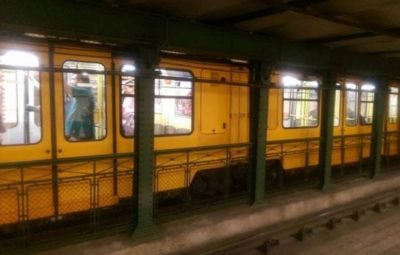
You’ll find ticket machines at most metro stations, and there are also ticket offices at a few locations as well.
Before boarding, you must validate your ticket at one of the orange machines you’ll find at each station.
There are more than 40 different tram lines in Budapest, and you can distinguish them from the metro by their yellow color.

While all the lines on this tram network are helpful for locals, tourists will find the following services most useful.
- Includes stops at the Hungarian Academy of Sciences, the House of Parliament, St. Gellert’s Hill, Buda Castle and more.
- Includes stops near the Buda Castle, Citadel, House of Parliament, Rákóczi Square Market Hall, and more.
- Tram 6 operates all night long .
- Includes stops near or at St. Anne’s Church, Gellért Hill, Gellért Spa, Citadella, Batthyány Square, and more.
- Includes stops at the Hungarian National Museum, the Great Market Hall, the Liberty Bridge, Lake Feneketlen, and more.
- Includes stops at Bauhaus Street, Körszálló (the Round Hotel), an enchanting forest, Hűvösvölgy and more.
Much like the metro, Budapest’s trams provide a lot of great stops that travelers and tourists might want to see.
What sets this service apart from others is the greater accessibility and number of lines.
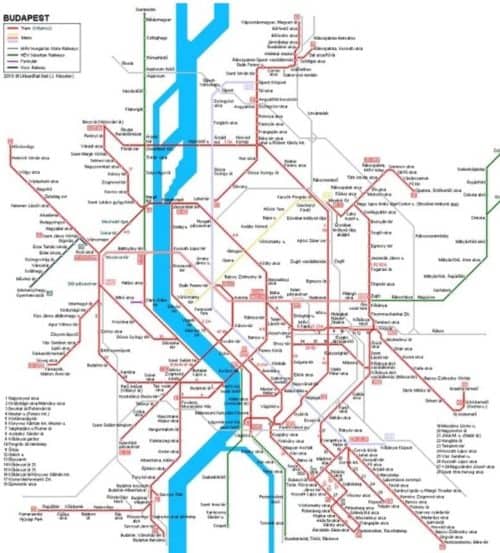
The Budapest trams run from 4:30 am to 11 pm each day, and the most popular lines run every 5-10 minutes on average.
Typically, this service is a bit slower than the metro – especially when it comes to the most popular line, Tram 2 – but you probably won’t have to wait an excessively long time.
Every major tram stop will have a ticket machine nearby which you can use to purchase admission.
Once you step on the tram, you’ll need to validate your ticket using the red, yellow or orange ticket validators on board.
There are over 250 bus lines in Budapest, which makes them one of the most difficult aspects of the public transit system to navigate.
That said, there are some reasons you may want to consider using the bus in this city, and a few great lines that are useful for travelers and tourists alike.
- Connects the airport with the Kőbánya-Kispest metro station.
- Connects Keleti Pályaudvar with Móricz Zsigmond Körtér.
- Includes stops at Blaha Lujza tér, Astoria, Ferenciek tere, Rudas Bath, Hotel Gellért and more.
- Connections with trams 4, 6, and the red, blue, and green metro lines.
- Connects Deák tér with Széll Kálmán tér.
- Includes stops at or near the Buda Castle Funicular, Buda Castle, Parade Square, Matthias Church and more.
- Connections with all metro lines at Deák tér.
- Connects Gyöngyösi utca with Apor Vilmos tér.
- Includes stops at Heroes Square, the Chain Bridge, as well as additional locations along Andrássy Avenue.
- Offers service all night long at stops marked with owl symbols.
Although there are a lot of blue buses that service popular stops in Budapest, there are just as many trams and metro trains that visit the same locations, so you may find that you won’t need to use the bus in this city.
That said, the airport transfer via bus 200E is definitely useful, and it’s unquestionably one of the most affordable ways to reach the city center – especially if you use a travel card or tourist pass.
There is also a 100E bus which is more of a shuttle bus, offering a direct transfer to the city center from Terminal 2.
This line also has more space for luggage, making it ideal for travelers.
This line costs around €2.70 for a ticket as opposed to the €1 fare on the 200E line, but there are fewer stops on the way to the city, and the bus is literally designed for airport transfers, so it’s definitely worth consideration.
It’s also nice that buses 900-999 provide service during the hours that other public transit options are usually not running (from 11 pm - 4:30 am).
In addition to that, the buses are one of the best ways to reach areas like the Buda Hills. If you need to reach the suburbs, consider this Budapest transport option.
Tickets can be purchased on board, but you’ll pay €0.25 more for the convenience.
If you’d rather save some money, you can use a ticket machine, visit a post office, a travel card, or a concession pass .
In addition to all the traditional buses in Budapest, there are also 15 red-colored trolley bus lines in the city numbered 70-83.
Each trolley connects with either the metro or trams at several locations throughout the city, making this an excellent alternative for transfers to other services in Budapest’s public transit system.
Here are a few details to keep in mind about each trolley:
- Includes stops at Transport Museum, Andrássy Avenue, Kossuth Square, and more.
- Connects with trams 2, 4, and 6, as well as lines 1 and 2 of the metro.
- Includes stops at Andrássy Avenue, Kossuth Square, Bethlen Gábor Square, and more.
- Includes stops at Kálvária Square, Gypsy Musician Park, Kalvin Square, and more.
- Connects with trams 2, 4, 6, 47, 49, and metro line 4.
As with all other forms of public transportation in Budapest, you’ll need to purchase tickets either from a ticket machine or in the form of a travel card or tourist pass.
Much like the trams and metro, these red trolleybuses run from about 4:30 am - 11 pm, give or take a half-hour depending on which line you choose.
Otherwise known as suburban trains, this railway system is designed more for locals than for travelers and tourists, but there are some lines you might want to consider.
The Szentendre train (Line 5) runs from Batthyány tér to Szentendre, a small town on the bank of the Danube River that gives you a taste of Hungarian living.
This line also includes a stop at Aquincum, an ancient Roman city in Budapest that you might want to visit in order to see some of the ruins and historic architecture in the area.
Another great option is the line that runs from Örs Vezér tere to Gödöllo (Line 8), as Gödöllo is a popular little baroque village that houses the royal Gödöllo Palace and was one of Queen Elizabeth’s favorite residences.
Although these services can be helpful for anyone planning to take short day trips outside of Budapest, it’s important to note that anyone leaving the city center on an HÉV train will need an extension ticket.
These ticket prices depend on how far out you’ll be going. Here are the fares you can expect to pay:
- 10 Km Extension Ticket: €0.70
- 15 Km Extension Ticket: €0.85
- 20 Km Extension Ticket: €1.05
- 25 Km Extension Ticket: €1.30
- 30 Km Extension Ticket: €1.60
As you can see, even though you might have to pay a bit extra to use the HEV trains outside of the city, the prices are quite reasonable and definitely worth consideration.
HÉV suburban railway trains run once every 10-30 minutes depending on the line and the time of day, and they provide service from 4:30 am - 12 am each day.
BOATS AND FUNICULARS
In addition to the metro, trams, buses, trolleys, and HEV trains, there are also a few public boats you can use in Budapest, as well as one funicular you might want to consider.
The public boat lines are provided along the Danube River between Boráros tér and Római fürdő from March to October. Here are the lines currently available:
- D11 | Haller utca - Újpest Árpád út
- D12 | Haller utca - Római Fürdő/Lido
- D13 | Haller utca - Római Fürdő
- D14 | Csepel-Királyerdő - Soroksár Molnár-sziget
Tickets for the public boat service are €2.10 for adults and €1.55 for children, and you can purchase them on board.
Alternatively, you can also use either travel cards or tourist passes for unlimited access to these boats.
When it comes to funiculars, there’s really only one of note that most travelers will want to consider: the Buda Castle funicular from Clark Adam Square.
This service is not included with any public transport ticket, travel card, or tourist pass, so you’ll have to purchase admission separately.
Here are the ticket prices:
- One Way: €2.85/Adults | €1.70/Children
- Return: €4.85/Adults | €3.15/Children
The Buda Castle funicular runs from 7:30 am - 10 pm each day, and it can be found at the Buda end of the Chain Bridge.
MOL BUBI PUBLIC BIKES
In addition to all the other options on Budapest public transport (BKK), they also offer bike rentals for those who want a little more control over their transportation.
All you have to do is download the free MOL Bubi app and use it to unlock a bike at one of the 190 stations throughout Budapest.
The app also includes a map, making it easy to find the closest station.
One of the best things about the Bubi bikes is that they are available 24/7, so even when the buses and trains aren't running, you can always grab a bike and use it to get around.
Pricing Options
There are three different ways to pay for this service: pay-as-you-go, a monthly pass, and an annual pass.
Most tourists will probably stick to the pay-as-you-go option, as even the monthly pass is going to make more sense for locals.
Pay-As-You-Go
- 40 HUF (€0.10) per minute
- 2400 HUF (€6) per hour
- 4800 HUF (€12) for 2 hours
- 9600 HUF (€24) for 4 hours
Monthly Pass
- 1000 HUF (€2.70)
- The first 30 minutes are free
- 40 HUF (€0.10) per minute after
Annual Pass
- 8500 HUF (€23)
Due to the way the pricing is structured, it actually makes more sense to get a monthly pass if you plan to use Bubi bikes multiple times over several days, even if you're just visiting on vacation.
The monthly and annual pass options allow you to use a bike for 30 minutes for free, and all you have to do is return it to one of the many stations in time to avoid additional fees.
Once you've returned a bike, you can take out another one and restart the 30 minute timer.
If you're planning to do some sightseeing, this might be a good way to get from one attraction to the next, as most landmarks have a station nearby.
RELATED POSTS:
- Tourist Attraction Concession Passes
- Things to Do in Budapest
- Hop-On-Hop-Off Buses
Choose a Destination... I want them all PLUS general travel tips. Amsterdam Berlin Boston Charleston Chicago Dubai Lisbon London Los Angeles Miami Nashville New York City New Orleans Paris Philadelphia Prague Rome San Francisco Washington DC
About The Author

Boglarka Bordas
North america, united kingdom & ireland, middle east & india, asia & oceania.
- Search Please fill out this field.
- Manage Your Subscription
- Give a Gift Subscription
- Newsletters
- Sweepstakes
- Travel Destinations A-Z
This Central European City Is 'Paris of the East' and Boasts Michelin-Starred Restaurants, Contemporary Museums, and High-End Shopping
Budapest is emerging as Central Europe's most modern city.
:max_bytes(150000):strip_icc():format(webp)/Dobrina-Zhekova-2885480a814f40a2801fda922af4d135.jpeg)
Where to Eat
Where to stay, where to see art, where to shop.
Stuart Westmorland/Getty Images
With its history dating back to the Roman times and its grand palaces and cultural institutions, Budapest is one of Europe's most beautiful and architecturally significant capitals. Dubbed "Paris of the East," the Hungarian city comprises Buda and Pest, sitting on the opposite banks of the Danube River, linked by the spectacular Chain Bridge.
The city is recognized for its cultural significance as a UNESCO World Heritage Site , offering spectacular architecture, riverfront views, and thermal baths. But Budapest, while rooted in the past, is also emerging as a modern world-class destination with Michelin-starred restaurants, a globally acclaimed art scene, top-notch hotels, sleek spas, and countless independent boutiques and design shops.
totalpics/Getty Images
"Budapest has been an 'over-cultured' city for about a hundred years, with more theatres, symphony orchestras and museums than the country could have afforded," said András Török, a Budapest-based author and lecturer, whose latest book "Budapest Gem" was published by Assouline in April. "Nowadays, Budapest, a city just the right size, offers all the sophistication of much larger cities, especially after the gastro revolution of the mid-2010s."
Read on for a curated list of Budapest's best hotels, restaurants, spas, and galleries that reveal the city's modern spirit.
Overlooking the Danube River, Felix occupies a stunning neo-renaissance building and a former pumping station for the Royal Palace. The elegant eatery, often frequented by celebrities, boasts multiple dining rooms, including a breezy (and shaded) terrace with spectacular Gresham Palace and Buda Castle vistas. With seasonal, globally-inspired menus and a few year-round classics like oysters and caviar, Felix sources the freshest local ingredients and prime cuts of Australian and Japanese meats. Patrons also enjoy an impressive selection of hundreds of bottles of classic and rare Hungarian and international wines. Try the 1995 Oremus Tokaji Aszu 5 Puttonyos, a sweet dessert wine from Hungary's most renowned wine region, or indulge in a bottle of dry white 2021 Balassa X Czinki Szent Tamás Furmint, the result of a collaboration between one of the country's best vineyards and master sommelier Tamas Czinki, who's behind the restaurant's wine list.
In 2022, the Michelin Guide launched its inaugural Hungary guide, awarding two stars to just two eateries, including the Budapest-based Stand . The cozy downtown restaurant is helmed by award-winning chefs Tamás Széll and Szabina Szulló, whose elaborate dishes are rooted in traditional Hungarian culinary traditions but prepared with modern palates in mind. The result is a fine dining experience that showcases modern techniques and takes guests on a culinary journey around the country in an elegant yet cozy dining room.
Courtesy of W Budapest
Another highlight of the modern Budapest dining scene is Babel , which, like Stand, has been part of the Michelin Guide for two years. There is something whimsical and homey about its dining room, which features exposed stone walls, lush greenery, and warm wood accents. The eight-course menu is a refined celebration of Central European flavors and ingredients with a touch of Scandinavian minimalism.
Nightingale by Beefbar , the sleek Art Nouveau restaurant and bar of W Budapest, draws the city's cool crowd. Handcrafted cocktails, live DJ sessions, and shareable plates of Asian and Mediterranean-inspired dishes are complemented by front-row views of the city's Opera House across the street on elegant Andrássy Avenue.
It's easy to see why luxe hospitality brands love Budapest — the city has no shortage of grand palaces and mansions oozing Old World charm that have been transformed into five-star hotels.
But a roster of new openings blends past and present, marrying the best of two worlds and aesthetics.
W Budapest , which opened its doors in the summer of 2023 and was a finalist on this year's Travel + Leisure It List , is a prime example of the timeless sophistication of the city's historic buildings. Housed in the UNESCO-listed Drechsler Palace on Andrássy Avenue, the property's spectacular interiors reference the building's past — at one point, it served as the headquarters for the Ballet Insitute, so all bathrooms are outfitted with dressing room-like mirrors and lighting fixtures are inspired by delicate pearl earrings that ballerinas wear — with the brand's design-forward approach to hospitality. There are spacious accommodations with custom furnishings, a spa with an indoor heated pool, an impossibly chic hidden speakeasy, and a very Instagram-worthy courtyard covered by a wave-like glass ceiling.
With 84 rooms, the splendid Kozmo Hotel Suites and Spa , falls into the boutique hotel category and bills itself as the "modern reinterpretation of luxury." The five-star property, also housed in a historic landmark building, proves sophistication is in the small details such as Penhaligon toiletries, poster beds, bathtubs, and expansive city views.
Spanning three buildings, Dorothea Hotel, Budapest, Autograph Collection debuted in November 2023 at the heart of the city's downtown, just a few blocks from the Danube River. With 216 rooms, all impeccably furnished by the Milan-based Lissoni & Partners studio and featuring floor-to-ceiling windows, soaking bathtubs, and private balconies, the property's interiors balance old and new.
In recent years, the art landscape in Budapest has changed thanks to the growing recognition of Hungarian artists abroad and the rise of younger Hungarian collectors at home.
"Hungarian people have become more open for contemporary art," Márton Nemes , one of Hungary's most prominent contemporary artists, explained in his downtown Budapest studio. He said more young people are encouraged to pursue careers as professional artists at home. Nemes studied in London and divides his time between New York City and Budapest. His colorful abstract work is currently on view at the Hungarian Pavilion at the Venice Biennale.
Tanatat pongphibool/Getty Images
The Hungarian capital's art scene is ripe with galleries and spaces showcasing a diaspora of art media by established and up-and-coming artists. acb Galéria , housed in a neo-Renaissance building a few city blocks from the city's Opera House, was founded in the early 2000s but has since become one of the most prestigious art galleries in Hungary with three exhibition spaces and focuses on emerging local and international artists. (Nemes's work was displayed here in 2023.)
In September 2021, 37-year-old Hong Kong art collector Queenie Rosita Law opened Q Contemporary , a non-profit art center dedicated to Central and East European art, housed in the elegant 19th-century Rausch Villa on Andrássy Avenue. Law has been a champion of Hungarian art for over a decade after spending time in the region as a student at the prestigious Central St. Martins School of Art and Design in London. The space was renovated and now has whitewashed walls where travelers can peruse some one hundred works of art by dozens of the region's most prominent multidisciplinary contemporary artists like the internationally acclaimed László Fehér, Ilona Keserü, and Mira Brtka.
Alexander Spatari/Getty Images
For decades, The Studio of Young Artists' Association has supported Hungary's art professionals, and its FKSE Stúdió, a permanent exhibition space in Budapest's bohemian 7th district on the Pest side, promotes the work of the country's youngest artists and most recent art school graduates. The dynamic space also hosts lectures, discussions, video presentations, and other events where the general public can meet the artists in person.
And among the many galleries and art spaces along Bartók Béla Boulevard on the Buda side, you'll find Godot Intézet (the entrance is through a coffee shop), a small and beautiful gallery space with huge circular windows that regularly showcases art by local newcomers. Godot Intézet is associated with Budapest's Godot Galéria, an Independent Museum for Contemporary Art , which is also a worthy stop.
Nanushka , the sustainable fashion brand with a cult following among fashionistas on both sides of the Atlantic, was founded almost two decades ago in Budapest by Sandra Sándor and is now one of the best-known Hungarian labels worldwide. The company's aesthetic blends traditional Hungarian folklore details with urban simplicity and impeccable craftsmanship. Nanushka's Budapest store is fronted by a trendy coffee shop serving pastries and caffeinated drinks, hinting at the company's lifestyle appeal. The curated boutique collection includes women's and men's wear, including accessories like bags and sunglasses.
Dan Glasser/Courtesy of Nanushka
A few steps from Nanushka is the bright and airy boutique of Aeron , another well-known Hungarian brand in fashion circles, offering pieces that showcase its designer's penchant for sustainable practices and materials and exquisite tailoring and timeless design.
On the complete opposite of the creative spectrum is Eszka , whose brightly colored patterns and bold knitwear are designed to boost a wearer's confidence.
And if you need some high-end R&R, head to Omorovicza Insitute . The serene spa and store of the celebrity-favorite beauty brand (Anne Hathaway, Gwyneth Paltrow, and Uma Thurman are fans) uses minerals from the city's thermal waters. Book a detoxifying facial with Omorovicza's Moor mud products that refine and nourish or boost your skin's hydration levels with the brand's Hydrafacial Skin Therapy Session, blending its proprietary healing concentrate for instant glow and rejuvenation.
Related Articles
Weekly newsletter
I would like to subscribe and I let the website store the given information about me.
Budapest Cogwheel Railway Put into Service 150 Years Ago Today

150 years ago, on June 24, 1874, the first cogwheel train was put into operation in Budapest. The idea of the cogwheel railway on Sváb Hill was suggested by Count Ödön Széchenyi. The hill was a popular place for hiking and recreation for the city’s inhabitants, but until then it was mostly accessible on foot, Magyar Nemzet writes .
Cogwheel trains are used in high altitude mountainous areas, their locomotives have one or more driving gears connected to a special toothed rack rail. The first European cogwheel railway was designed and built by Niklaus Riggenbach between Vitznau and Rigi (Switzerland), and was inaugurated in 1871, the MTVA’s press archive reads.
The idea for the Budapest cogwheel was raised by Count Ödön Széchenyi after he became acquainted with Riggenbach’s work. The concession contract was signed with Riggenbach’s company on May 21, 1873, and the Swiss-born engineer Ferenc Cathry Szaléz was commissioned to build the track, that was completed in less than a year.
The world’s third Riggenbach railway with steam locomotives was put into service on June 24, 1874.
The railway was 2,883 meters in length with a difference in elevation of 264 meters between the two terminals. The trains left from the Ecce Homo meadow (now called Városmajor park) and ran along the Diós-árok to reach Sváb Hill. The steam locomotives pushed two or three carriages uphill at a speed of 12 km/h and hauled them downhill at a speed of 7.2 km/h.

A photograph from around 1880-1890. Photo: Fortepan / Budapest Főváros Levéltára / Klösz György fényképei
Initially running only between April and October, the cogwheel railway was mostly used by hikers, but it was also used for freight transport. From the beginning, it was criticized for its track and high ticket prices. Efforts were made to increase traffic by reducing fares and then offering discounts. The line was extended to Széchenyi Hill in 1890, increasing its length to 3,733 meters. From 1910, the railway, as it was also operating in winter, allowed the transport of heavy wagons loaded with building materials or fuel.
When the concession expired in 1926, the cogwheel became the property of the capital and was transferred to a Budapest municipal company, BSZKRT.
Railway electrification was started in 1927, and as part of the comprehensive technical development, the polluting steam locomotives were replaced by Ganz electric locomotives.
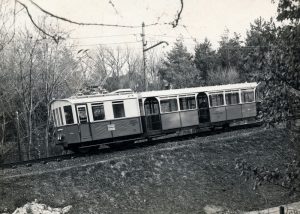
A Ganz-built, Rowan-type train on the electrified Cog-wheel Railway line in 1929. Photo: Fortepan / Surányi Sándor – György József
Old trackage was replaced by heavy-duty rails, overhead wires were built, and electrically powered vehicles were purchased. The speed limit was increased to 13.5 km/h, and trains followed each other every 15 minutes instead of every 30.
During the Second World War, from the end of 1944 to mid-1945, the cogwheel was not in use, and later used to transport timber from the mountains to the city. Freight traffic stopped over time, and some people even suggested discontinuing the service due to the growing number of buses.
The cogwheel was eventually rescued and became a test case for transport without conductors, with the first KN signs (kalauz nélkül – English: no conductor on board) being installed on the cogwheel railway on December 4, 1961.

Terminal of the railway in 1969. Photo: Fortepan / FŐMTERV
The railway was taken over by the Budapest Transport Company (BKV) in 1968, and in 1973 it was completely renovated.
The track was renewed replacing the Riggenbach system with the Strub cogwheel system, the line voltage was increased to 1,500V, high platforms were built at the stations, a new station was built, the terminal at Városmajor was rebuilt, and new types of engines and carriages were purchased. In the past decades, numerous renovations and modernization have been carried out, computer-controlled security system is in use since 1992, and since 1993, cyclists can also use the service.
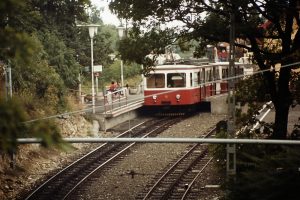
A Budapest cogwheel train in 1975. Photo: Fortepan / Ed Sijmons
The cogwheel train (formally called tram number 60 since 2008) is currently facing serious technical and traffic challenges. Regular maintenance is carried out to ensure its safe operation until the funds are available for a full refurbishment.
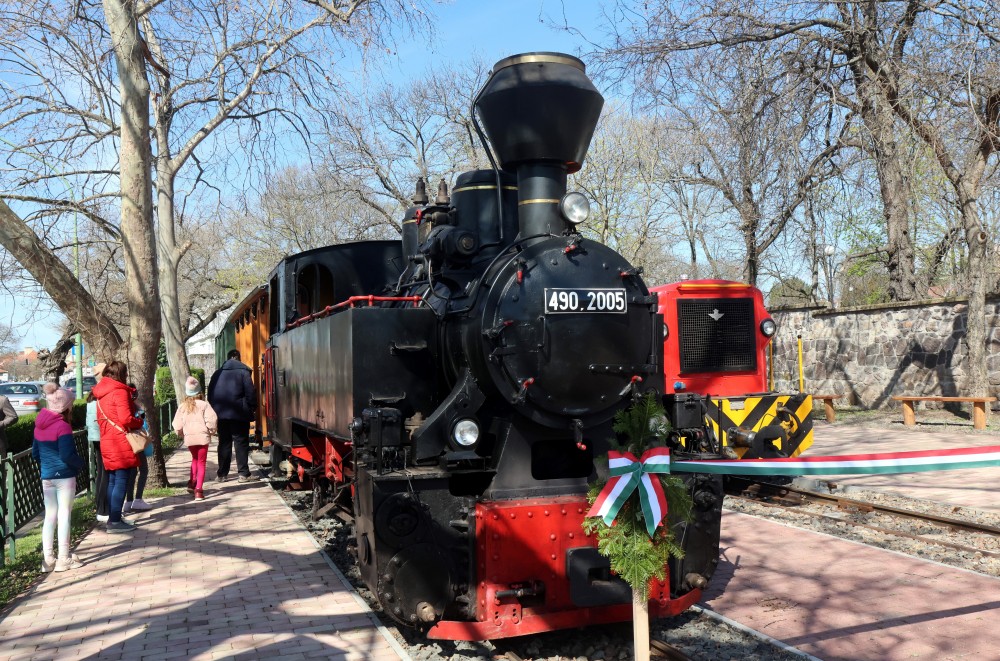
In the last 10 years, some HUF 42 billion has been invested in the development of the regional tourism infrastructure. Continue reading
Via Magyar Nemzet; Featured image: Wikipedia

IMAGES
VIDEO
COMMENTS
The trams run from early morning until midnight, with some lines offering 24-hour service. Tram stops are marked with yellow signs and are usually located every few blocks, making them easily accessible. 1.1 Tram Lines. Budapest has numerous tram lines, each designated with a number and color. The most popular tram lines for tourists are:
Trams in Budapest run from 4:30 am to 11 pm, with the most important lines running every 5 to 10 minutes. All of Budapest's means of transport use the same. ... The Budapest Card is a travel card for tourists, which offers unlimited travel on public transportation, including trams, for a specified period of time (24, 48, 72, 96, or 120 hours). ...
This is an excerpt from our extensive Budapest guide book in which we show you the city from its most authentic and honest side through 99 chapters and more than 200 places to discover.. Budapest's trams ("villamos'") are shiny yellow beacons of the city's public transportation system. Their history reaches back to more than 150 years and today, they are somewhat the "exceptional ...
Tram 2: Front Row Seats to Buda's Cityscape. Considered the grande dame of all trams in Budapest, tram 2 offers passengers front row seats to gawk at Buda's historic cityscape and the main bridges that adorn the city center.Starting at Margaret Bridge and passing by iconic landmarks such as the Parliament building and Chain Bridge, this tram ride is a perfect way to take in the beauty of the ...
Trams in Budapest run from 4:30 am to 11 pm. The most important lines run every 5 to 10 minutes. Tariffs. All of Budapest's means of transport use the same tickets and travel passes and cost the same price: Budapest transport ticket and pass prices.
Budapest Metro Lines 🚊 Trams In Budapest -The Most Important Tram Lines: Trams No. 4 and No. 6; Tram No. 2, & 2B - One Of The Most Scenic Tram Rides In Europe; Trams No. 47 and 49 🚌 Bus Services. Night Buses 🚎 Trolley Lines 🚃 Suburban Railway (HÉV) Travelling By Public Boat (2022) Public Boat Lines (Before 2022):
Don't travel at rush hour. The tram, metro, and bus buses can get pretty packed between 8 and 9 a.m., and between 5:30 p.m. and 7 p.m. Try to avoid traveling during those times if possible. Keep an eye on your belongings. Budapest is generally a safe city, but like any capital, you have a risk of pickpockets.
Navigating Budapest by Tram. Uniquely experience the charm of Budapest by hopping aboard one of its 32 vibrant, bright-yellow tram lines. In Hungarian, these are known as "villamos". You'll find tram lines like no. 4 and no. 6 exceptionally useful, as they run along the Outer Ring (Nagykörút), covering a significant swath of the city.
Budapest has over 30 tram lines throughout the city, but you won't be using most of them. The most important trams for tourists are tram lines 2, 4, and 6. Tram 2 is like a tourist train; it goes along the Danube on the Pest-side and will show you views of the Gellért Hill, Buda Castle, Chain Bridge, and the Parliament.
The tram network of Budapest is part of the mass transit system of Budapest, the capital city of Hungary.Tram lines serve as the second-most important backbone of the transit system after the bus network, carrying almost 100 million more passengers annually than the Budapest Metro. In operation since 1866, the Budapest tram network is among the world's largest tram networks by route length ...
Travel options in Budapest. Day and night public transport in Budapest Special and heritage transport services. Chairlift, Funicular, heritage transport services - Budapest's special transport means and lines Night tranpsort. Life goes on at night - all the information you need about Budapest's night lines
The Budapest Tram Network. Budapest boasts an extensive tram network that covers the entire city, making it a convenient mode of transportation for both locals and visitors. Trams in Budapest are an iconic part of the city's charm, offering scenic routes and providing easy access to popular tourist attractions. How Does the Ticketing System Work?
Get from A to B easily around Budapest with our simple guide to using the city's excellent public transport, giving tips and info about tickets, passes, buses, boats, metro lines and more. ... bus and tram must have a separate, validated ticket, or consider a transfer ticket, as listed above. 6/10 ... 24- and 72-hour travel passes Valid for 24 ...
Transportation System/Links in Budapest - Click for a printable map! Fares in Budapest. BKK ticket offices. All forms of public transportation (metro, bus, tram, trolleybus, some HÉV railway lines, and cogwheel railway) in Budapest require the self-validation of prepurchased tickets (vonaljegy), which cost 350 Ft (EUR 1.11, or USD 1.34) apiece (children 5 and under travel free); single ...
Travel information. Airport Express. Travel options in Budapest. Special and heritage transport services. Night tranpsort. Front-door boarding. Accessibility. ... Map of Budapest metro, tram and trolleybus lines Heritage transport services. Map of Budapest's heritage transport services. Cycling maps.
Budapest has one of the world's largest tram networks, and since trams rarely get stuck in traffic jams, they're one of the most effective ways to get wherever you want to go. The center of the city, Deák Ferenc tér can be reached by tram lines 47 and 49, and even with 48 on weekends - the old-school carriages are in perfect sync with ...
As well as the trams, there are also many buses taking you to all the farthest corners of the city. There are over 30 tram lines running through Budapest, so to describe everything about Budapest trams you'd need a whole separate article. However, there are three major tram lines that can take the average tourist everywhere they need to go ...
24-Hour Travel Card: Allows unlimited travel on trams, buses, and metros within Budapest for 24 hours from validation. 72-Hour Travel Card: Similar to the 24-hour card, but valid for 72 hours. 2. Buying Tickets. Now that you know the different ticket options, here's how you can purchase them: 2.1 Ticket Vending Machines
City Card allow you to save on public transport and / or on the entrances to the main tourist attractions. 39,00 €. Easy, quick and safe booking, the best prices and customer service in English. Moving around Budapest is very easy thanks to the BKV public transports available around the city, including buses, trams, and metro.
Thanks to plentiful buses, boats, trams and Metro trains, getting around Budapest is easy. The Hungarian capital is highly walkable, and for the times when you need to go further afield or get somewhere quickly, there are plenty of options. Budapest Közlekedési Központ (BKK) runs the city's transport network, which includes metro lines ...
Apart from the metro, transferring between lines (eg. from a tram to a tram, a tram to a bus, a bus to a bus etc.) requires a new single ticket. You can save a little by buying 10 single tickets in a block for 3000 HUF. On the other hand, travel cards are valid for a longer period of time from the date and time indicated on them. They are valid ...
Let's get started with the panoramic tram ride in Budapest. As you board tram line 2 in Budapest, do not forget to validate your ticket first. The people inspecting tickets are not known to be tourist-friendly. As a consequence, lots of people have ended up paying unnecessary fines, even if they didn't intend to do anything wrong at all.
The metro is fast, but, as a tourist, we recommend you prioritize the tram or bus if needed so you can actually see the beauty of Budapest, not just stare at concrete walls whizzing past you.
There are 3 different versions of travel cards available in Budapest: 24-hour, 72-hour, and 7-day. ... The Budapest trams run from 4:30 am to 11 pm each day, and the most popular lines run every 5-10 minutes on average. Typically, this service is a bit slower than the metro - especially when it comes to the most popular line, Tram 2 - but ...
Budapest, while rooted in the past, is emerging as a modern world-class destination with Michelin-starred restaurants, a globally acclaimed art scene, top-notch hotels, sleek spas, and countless ...
150 years ago, on June 24, 1874, the first cogwheel train was put into operation in Budapest. The idea of the cogwheel railway on Sváb Hill was suggested by Count Ödön Széchenyi. The hill was a popular place for hiking and recreation for the city's inhabitants, but until then it was mostly accessible on foot, Magyar Nemzet writes .